A Study of Software Development Project Cost, Schedule and Quality By Outsourcing to Low Cost Destination
VerifiedAdded on 2022/01/22
|45
|13810
|52
AI Summary
Downloaded by RMIT University At 05:12 26 February 2016 (PT) Downloaded by RMIT University At 05:12 26 February 2016 (PT) A Study of Software Development Project Cost, Schedule and Quality By Outsourcing to Low Cost Destination Abstract: Purpose - This paper makes an attempt to find good values of onsite-offshore team strength; number of hours of communication between business users and onsite team and between onsite and offshore team so as to reduce project cost and improve schedule in a global software development environment
Contribute Materials
Your contribution can guide someone’s learning journey. Share your
documents today.
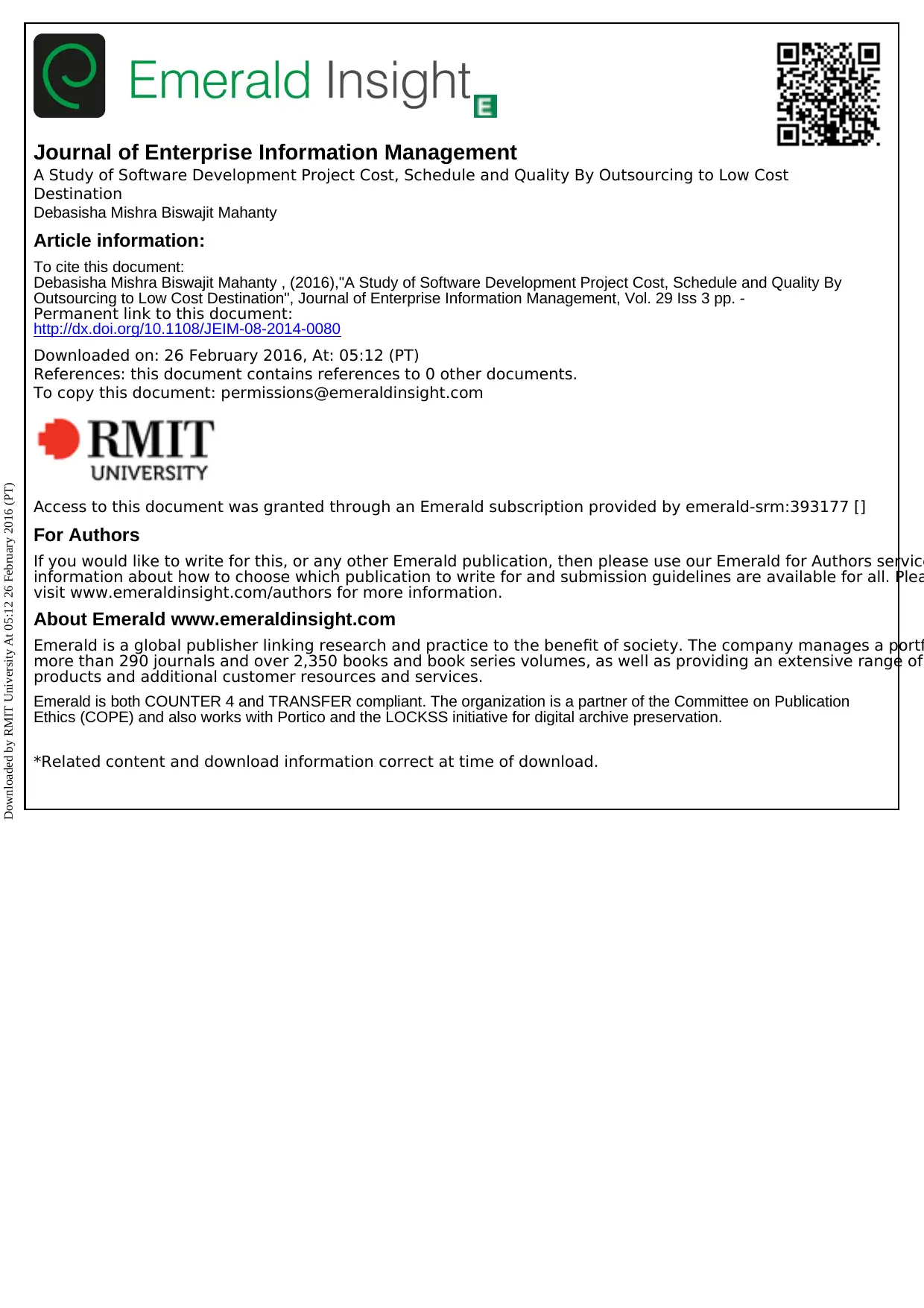
Journal of Enterprise Information Management
A Study of Software Development Project Cost, Schedule and Quality By Outsourcing to Low Cost
Destination
Debasisha Mishra Biswajit Mahanty
Article information:
To cite this document:
Debasisha Mishra Biswajit Mahanty , (2016),"A Study of Software Development Project Cost, Schedule and Quality By
Outsourcing to Low Cost Destination", Journal of Enterprise Information Management, Vol. 29 Iss 3 pp. -
Permanent link to this document:
http://dx.doi.org/10.1108/JEIM-08-2014-0080
Downloaded on: 26 February 2016, At: 05:12 (PT)
References: this document contains references to 0 other documents.
To copy this document: permissions@emeraldinsight.com
Access to this document was granted through an Emerald subscription provided by emerald-srm:393177 []
For Authors
If you would like to write for this, or any other Emerald publication, then please use our Emerald for Authors service
information about how to choose which publication to write for and submission guidelines are available for all. Plea
visit www.emeraldinsight.com/authors for more information.
About Emerald www.emeraldinsight.com
Emerald is a global publisher linking research and practice to the benefit of society. The company manages a portf
more than 290 journals and over 2,350 books and book series volumes, as well as providing an extensive range of
products and additional customer resources and services.
Emerald is both COUNTER 4 and TRANSFER compliant. The organization is a partner of the Committee on Publication
Ethics (COPE) and also works with Portico and the LOCKSS initiative for digital archive preservation.
*Related content and download information correct at time of download.
Downloaded by RMIT University At 05:12 26 February 2016 (PT)
A Study of Software Development Project Cost, Schedule and Quality By Outsourcing to Low Cost
Destination
Debasisha Mishra Biswajit Mahanty
Article information:
To cite this document:
Debasisha Mishra Biswajit Mahanty , (2016),"A Study of Software Development Project Cost, Schedule and Quality By
Outsourcing to Low Cost Destination", Journal of Enterprise Information Management, Vol. 29 Iss 3 pp. -
Permanent link to this document:
http://dx.doi.org/10.1108/JEIM-08-2014-0080
Downloaded on: 26 February 2016, At: 05:12 (PT)
References: this document contains references to 0 other documents.
To copy this document: permissions@emeraldinsight.com
Access to this document was granted through an Emerald subscription provided by emerald-srm:393177 []
For Authors
If you would like to write for this, or any other Emerald publication, then please use our Emerald for Authors service
information about how to choose which publication to write for and submission guidelines are available for all. Plea
visit www.emeraldinsight.com/authors for more information.
About Emerald www.emeraldinsight.com
Emerald is a global publisher linking research and practice to the benefit of society. The company manages a portf
more than 290 journals and over 2,350 books and book series volumes, as well as providing an extensive range of
products and additional customer resources and services.
Emerald is both COUNTER 4 and TRANSFER compliant. The organization is a partner of the Committee on Publication
Ethics (COPE) and also works with Portico and the LOCKSS initiative for digital archive preservation.
*Related content and download information correct at time of download.
Downloaded by RMIT University At 05:12 26 February 2016 (PT)
Secure Best Marks with AI Grader
Need help grading? Try our AI Grader for instant feedback on your assignments.
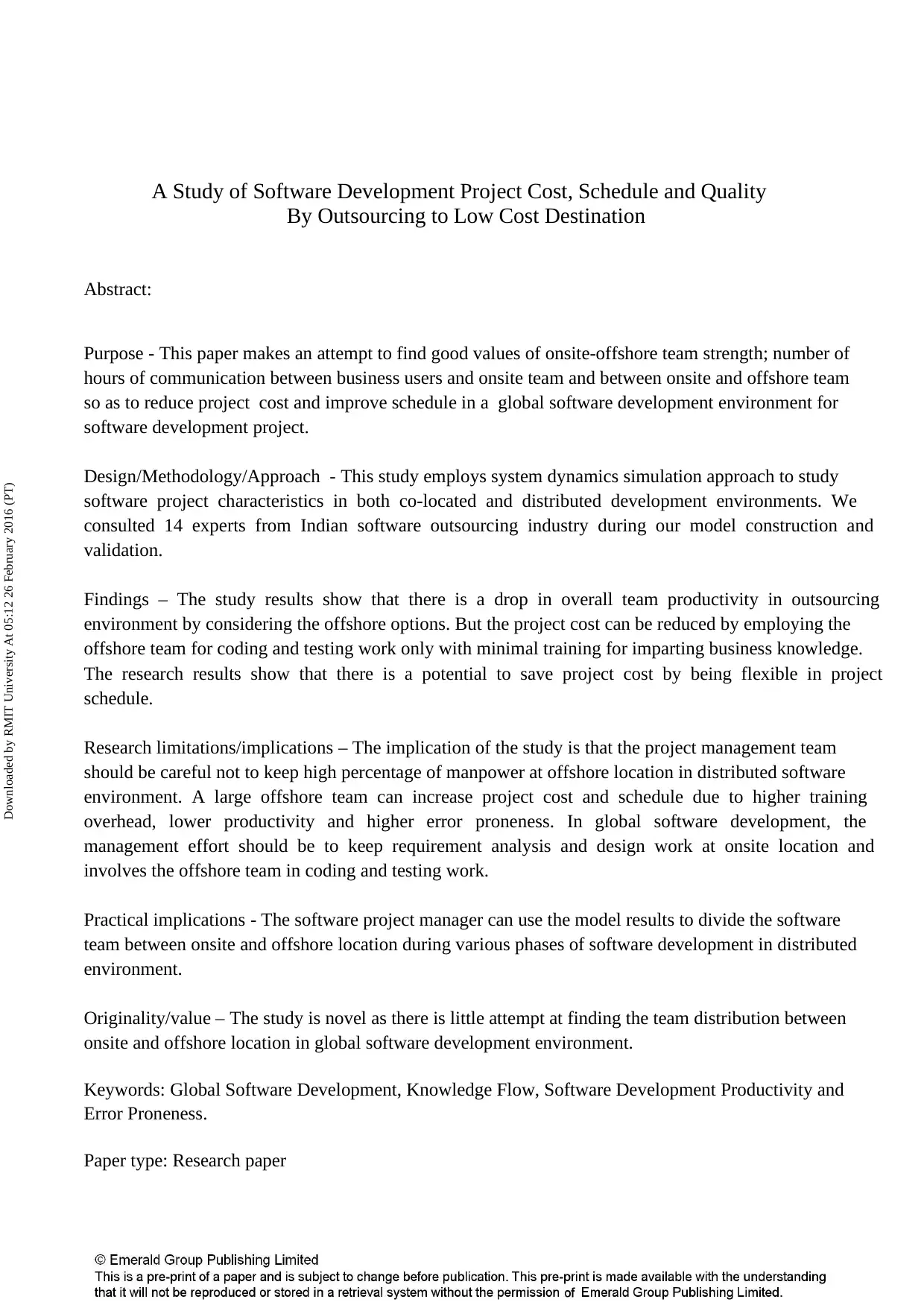
A Study of Software Development Project Cost, Schedule and Quality
By Outsourcing to Low Cost Destination
Abstract:
Purpose - This paper makes an attempt to find good values of onsite-offshore team strength; number of
hours of communication between business users and onsite team and between onsite and offshore team
so as to reduce project cost and improve schedule in a global software development environment for
software development project.
Design/Methodology/Approach - This study employs system dynamics simulation approach to study
software project characteristics in both co-located and distributed development environments. We
consulted 14 experts from Indian software outsourcing industry during our model construction and
validation.
Findings – The study results show that there is a drop in overall team productivity in outsourcing
environment by considering the offshore options. But the project cost can be reduced by employing the
offshore team for coding and testing work only with minimal training for imparting business knowledge.
The research results show that there is a potential to save project cost by being flexible in project
schedule.
Research limitations/implications – The implication of the study is that the project management team
should be careful not to keep high percentage of manpower at offshore location in distributed software
environment. A large offshore team can increase project cost and schedule due to higher training
overhead, lower productivity and higher error proneness. In global software development, the
management effort should be to keep requirement analysis and design work at onsite location and
involves the offshore team in coding and testing work.
Practical implications - The software project manager can use the model results to divide the software
team between onsite and offshore location during various phases of software development in distributed
environment.
Originality/value – The study is novel as there is little attempt at finding the team distribution between
onsite and offshore location in global software development environment.
Keywords: Global Software Development, Knowledge Flow, Software Development Productivity and
Error Proneness.
Paper type: Research paper
Downloaded by RMIT University At 05:12 26 February 2016 (PT)
By Outsourcing to Low Cost Destination
Abstract:
Purpose - This paper makes an attempt to find good values of onsite-offshore team strength; number of
hours of communication between business users and onsite team and between onsite and offshore team
so as to reduce project cost and improve schedule in a global software development environment for
software development project.
Design/Methodology/Approach - This study employs system dynamics simulation approach to study
software project characteristics in both co-located and distributed development environments. We
consulted 14 experts from Indian software outsourcing industry during our model construction and
validation.
Findings – The study results show that there is a drop in overall team productivity in outsourcing
environment by considering the offshore options. But the project cost can be reduced by employing the
offshore team for coding and testing work only with minimal training for imparting business knowledge.
The research results show that there is a potential to save project cost by being flexible in project
schedule.
Research limitations/implications – The implication of the study is that the project management team
should be careful not to keep high percentage of manpower at offshore location in distributed software
environment. A large offshore team can increase project cost and schedule due to higher training
overhead, lower productivity and higher error proneness. In global software development, the
management effort should be to keep requirement analysis and design work at onsite location and
involves the offshore team in coding and testing work.
Practical implications - The software project manager can use the model results to divide the software
team between onsite and offshore location during various phases of software development in distributed
environment.
Originality/value – The study is novel as there is little attempt at finding the team distribution between
onsite and offshore location in global software development environment.
Keywords: Global Software Development, Knowledge Flow, Software Development Productivity and
Error Proneness.
Paper type: Research paper
Downloaded by RMIT University At 05:12 26 February 2016 (PT)
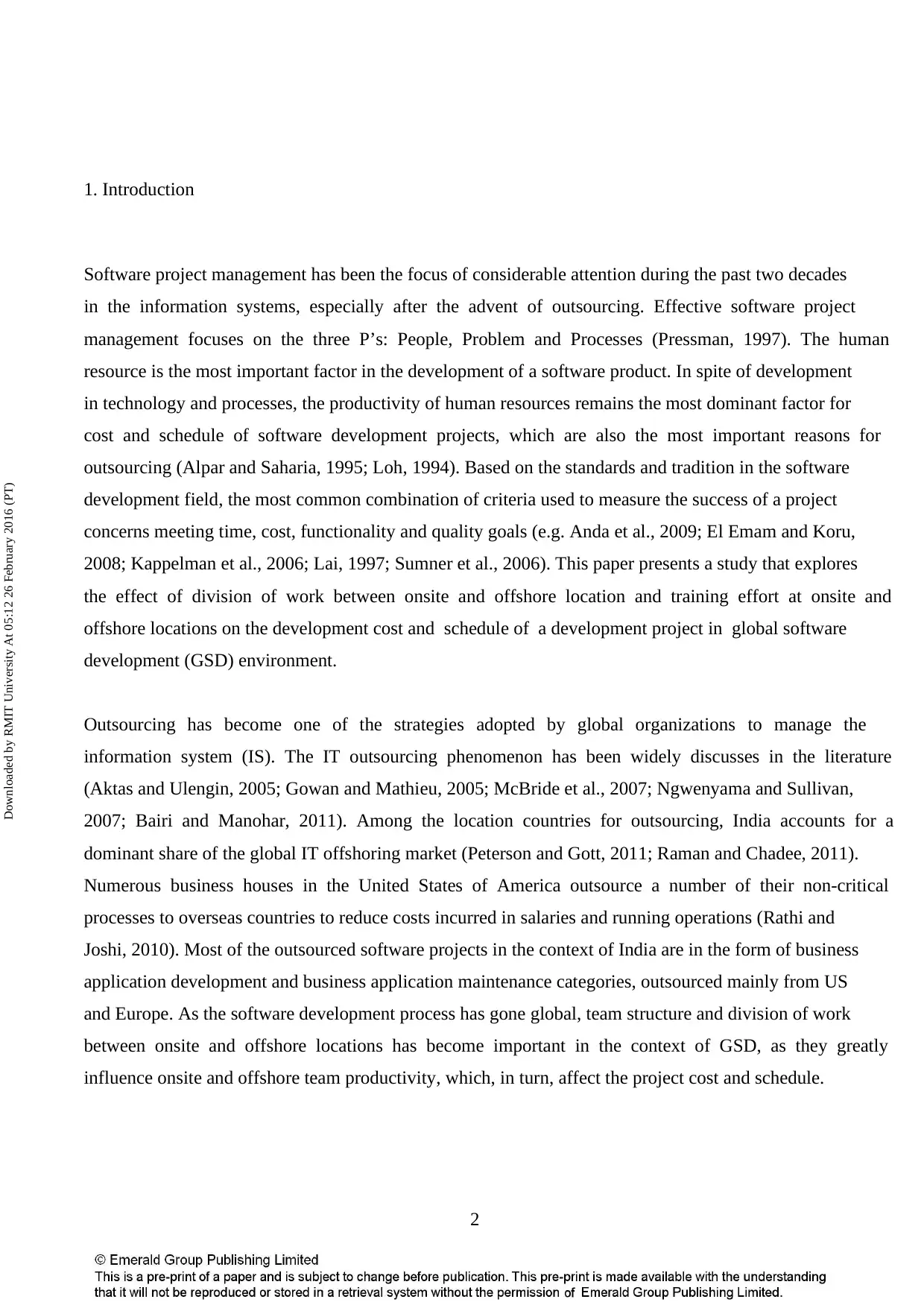
2
1. Introduction
Software project management has been the focus of considerable attention during the past two decades
in the information systems, especially after the advent of outsourcing. Effective software project
management focuses on the three P’s: People, Problem and Processes (Pressman, 1997). The human
resource is the most important factor in the development of a software product. In spite of development
in technology and processes, the productivity of human resources remains the most dominant factor for
cost and schedule of software development projects, which are also the most important reasons for
outsourcing (Alpar and Saharia, 1995; Loh, 1994). Based on the standards and tradition in the software
development field, the most common combination of criteria used to measure the success of a project
concerns meeting time, cost, functionality and quality goals (e.g. Anda et al., 2009; El Emam and Koru,
2008; Kappelman et al., 2006; Lai, 1997; Sumner et al., 2006). This paper presents a study that explores
the effect of division of work between onsite and offshore location and training effort at onsite and
offshore locations on the development cost and schedule of a development project in global software
development (GSD) environment.
Outsourcing has become one of the strategies adopted by global organizations to manage the
information system (IS). The IT outsourcing phenomenon has been widely discusses in the literature
(Aktas and Ulengin, 2005; Gowan and Mathieu, 2005; McBride et al., 2007; Ngwenyama and Sullivan,
2007; Bairi and Manohar, 2011). Among the location countries for outsourcing, India accounts for a
dominant share of the global IT offshoring market (Peterson and Gott, 2011; Raman and Chadee, 2011).
Numerous business houses in the United States of America outsource a number of their non-critical
processes to overseas countries to reduce costs incurred in salaries and running operations (Rathi and
Joshi, 2010). Most of the outsourced software projects in the context of India are in the form of business
application development and business application maintenance categories, outsourced mainly from US
and Europe. As the software development process has gone global, team structure and division of work
between onsite and offshore locations has become important in the context of GSD, as they greatly
influence onsite and offshore team productivity, which, in turn, affect the project cost and schedule.
Downloaded by RMIT University At 05:12 26 February 2016 (PT)
1. Introduction
Software project management has been the focus of considerable attention during the past two decades
in the information systems, especially after the advent of outsourcing. Effective software project
management focuses on the three P’s: People, Problem and Processes (Pressman, 1997). The human
resource is the most important factor in the development of a software product. In spite of development
in technology and processes, the productivity of human resources remains the most dominant factor for
cost and schedule of software development projects, which are also the most important reasons for
outsourcing (Alpar and Saharia, 1995; Loh, 1994). Based on the standards and tradition in the software
development field, the most common combination of criteria used to measure the success of a project
concerns meeting time, cost, functionality and quality goals (e.g. Anda et al., 2009; El Emam and Koru,
2008; Kappelman et al., 2006; Lai, 1997; Sumner et al., 2006). This paper presents a study that explores
the effect of division of work between onsite and offshore location and training effort at onsite and
offshore locations on the development cost and schedule of a development project in global software
development (GSD) environment.
Outsourcing has become one of the strategies adopted by global organizations to manage the
information system (IS). The IT outsourcing phenomenon has been widely discusses in the literature
(Aktas and Ulengin, 2005; Gowan and Mathieu, 2005; McBride et al., 2007; Ngwenyama and Sullivan,
2007; Bairi and Manohar, 2011). Among the location countries for outsourcing, India accounts for a
dominant share of the global IT offshoring market (Peterson and Gott, 2011; Raman and Chadee, 2011).
Numerous business houses in the United States of America outsource a number of their non-critical
processes to overseas countries to reduce costs incurred in salaries and running operations (Rathi and
Joshi, 2010). Most of the outsourced software projects in the context of India are in the form of business
application development and business application maintenance categories, outsourced mainly from US
and Europe. As the software development process has gone global, team structure and division of work
between onsite and offshore locations has become important in the context of GSD, as they greatly
influence onsite and offshore team productivity, which, in turn, affect the project cost and schedule.
Downloaded by RMIT University At 05:12 26 February 2016 (PT)
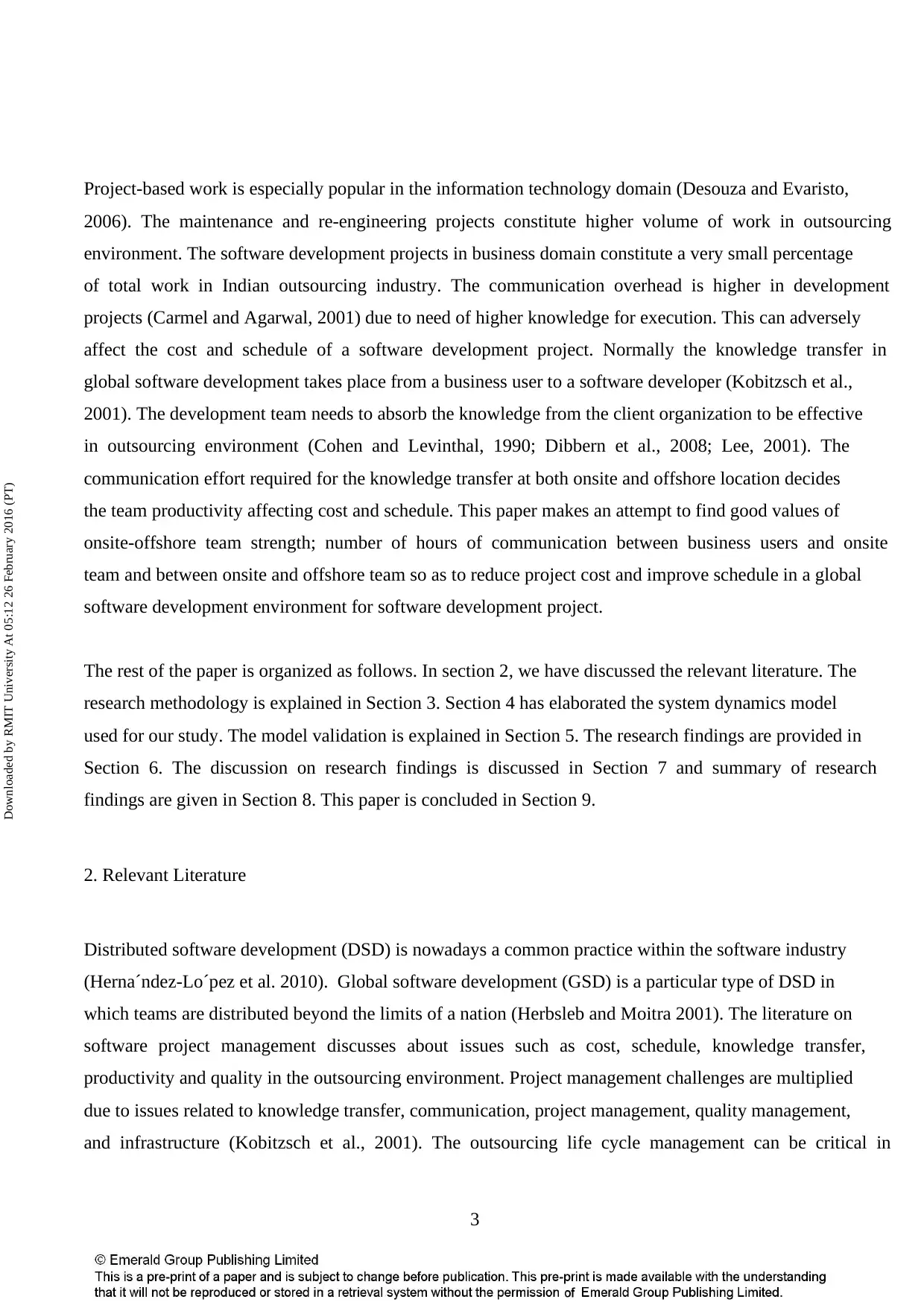
3
Project-based work is especially popular in the information technology domain (Desouza and Evaristo,
2006). The maintenance and re-engineering projects constitute higher volume of work in outsourcing
environment. The software development projects in business domain constitute a very small percentage
of total work in Indian outsourcing industry. The communication overhead is higher in development
projects (Carmel and Agarwal, 2001) due to need of higher knowledge for execution. This can adversely
affect the cost and schedule of a software development project. Normally the knowledge transfer in
global software development takes place from a business user to a software developer (Kobitzsch et al.,
2001). The development team needs to absorb the knowledge from the client organization to be effective
in outsourcing environment (Cohen and Levinthal, 1990; Dibbern et al., 2008; Lee, 2001). The
communication effort required for the knowledge transfer at both onsite and offshore location decides
the team productivity affecting cost and schedule. This paper makes an attempt to find good values of
onsite-offshore team strength; number of hours of communication between business users and onsite
team and between onsite and offshore team so as to reduce project cost and improve schedule in a global
software development environment for software development project.
The rest of the paper is organized as follows. In section 2, we have discussed the relevant literature. The
research methodology is explained in Section 3. Section 4 has elaborated the system dynamics model
used for our study. The model validation is explained in Section 5. The research findings are provided in
Section 6. The discussion on research findings is discussed in Section 7 and summary of research
findings are given in Section 8. This paper is concluded in Section 9.
2. Relevant Literature
Distributed software development (DSD) is nowadays a common practice within the software industry
(Herna´ndez-Lo´pez et al. 2010). Global software development (GSD) is a particular type of DSD in
which teams are distributed beyond the limits of a nation (Herbsleb and Moitra 2001). The literature on
software project management discusses about issues such as cost, schedule, knowledge transfer,
productivity and quality in the outsourcing environment. Project management challenges are multiplied
due to issues related to knowledge transfer, communication, project management, quality management,
and infrastructure (Kobitzsch et al., 2001). The outsourcing life cycle management can be critical in
Downloaded by RMIT University At 05:12 26 February 2016 (PT)
Project-based work is especially popular in the information technology domain (Desouza and Evaristo,
2006). The maintenance and re-engineering projects constitute higher volume of work in outsourcing
environment. The software development projects in business domain constitute a very small percentage
of total work in Indian outsourcing industry. The communication overhead is higher in development
projects (Carmel and Agarwal, 2001) due to need of higher knowledge for execution. This can adversely
affect the cost and schedule of a software development project. Normally the knowledge transfer in
global software development takes place from a business user to a software developer (Kobitzsch et al.,
2001). The development team needs to absorb the knowledge from the client organization to be effective
in outsourcing environment (Cohen and Levinthal, 1990; Dibbern et al., 2008; Lee, 2001). The
communication effort required for the knowledge transfer at both onsite and offshore location decides
the team productivity affecting cost and schedule. This paper makes an attempt to find good values of
onsite-offshore team strength; number of hours of communication between business users and onsite
team and between onsite and offshore team so as to reduce project cost and improve schedule in a global
software development environment for software development project.
The rest of the paper is organized as follows. In section 2, we have discussed the relevant literature. The
research methodology is explained in Section 3. Section 4 has elaborated the system dynamics model
used for our study. The model validation is explained in Section 5. The research findings are provided in
Section 6. The discussion on research findings is discussed in Section 7 and summary of research
findings are given in Section 8. This paper is concluded in Section 9.
2. Relevant Literature
Distributed software development (DSD) is nowadays a common practice within the software industry
(Herna´ndez-Lo´pez et al. 2010). Global software development (GSD) is a particular type of DSD in
which teams are distributed beyond the limits of a nation (Herbsleb and Moitra 2001). The literature on
software project management discusses about issues such as cost, schedule, knowledge transfer,
productivity and quality in the outsourcing environment. Project management challenges are multiplied
due to issues related to knowledge transfer, communication, project management, quality management,
and infrastructure (Kobitzsch et al., 2001). The outsourcing life cycle management can be critical in
Downloaded by RMIT University At 05:12 26 February 2016 (PT)
Secure Best Marks with AI Grader
Need help grading? Try our AI Grader for instant feedback on your assignments.
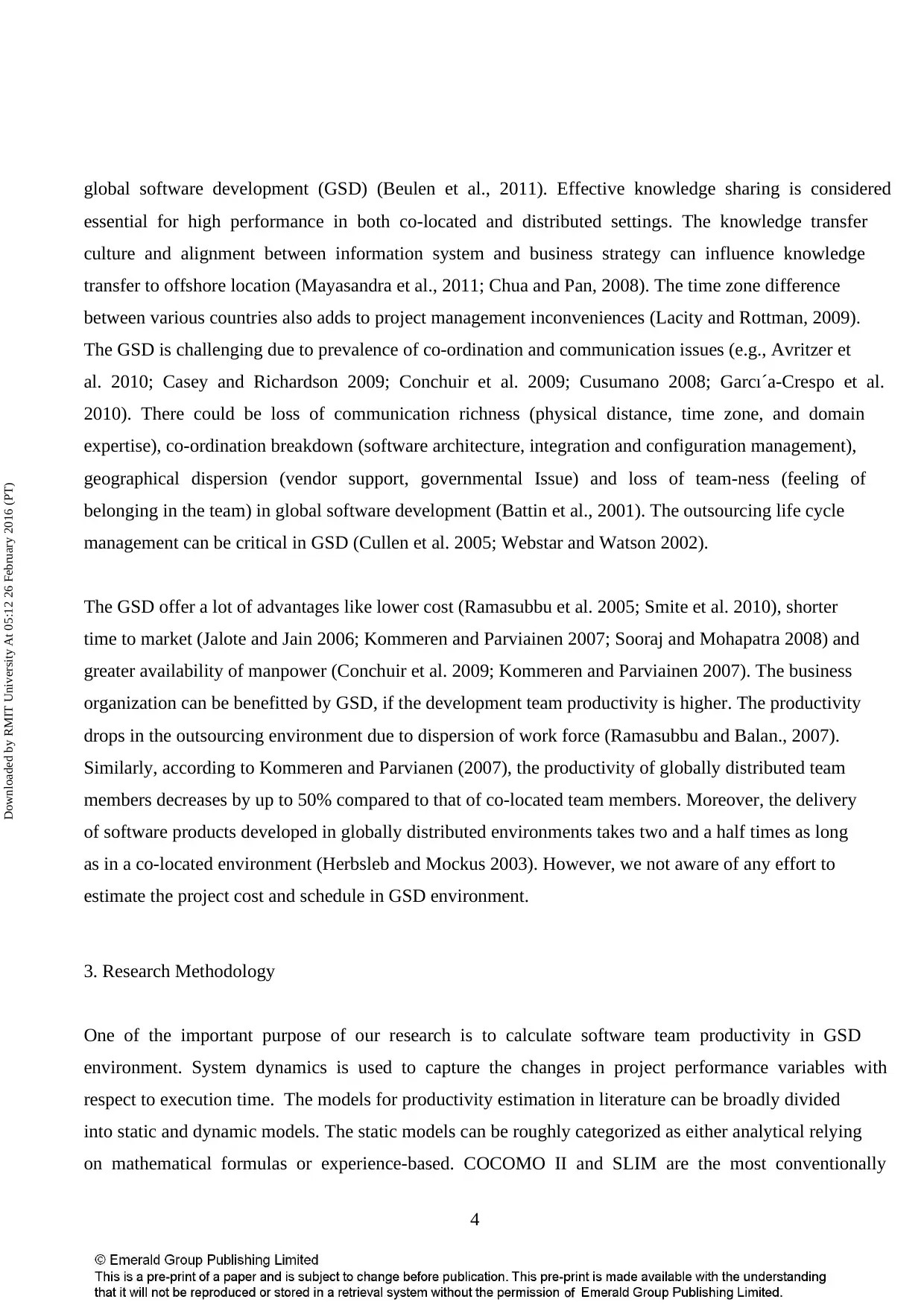
4
global software development (GSD) (Beulen et al., 2011). Effective knowledge sharing is considered
essential for high performance in both co-located and distributed settings. The knowledge transfer
culture and alignment between information system and business strategy can influence knowledge
transfer to offshore location (Mayasandra et al., 2011; Chua and Pan, 2008). The time zone difference
between various countries also adds to project management inconveniences (Lacity and Rottman, 2009).
The GSD is challenging due to prevalence of co-ordination and communication issues (e.g., Avritzer et
al. 2010; Casey and Richardson 2009; Conchuir et al. 2009; Cusumano 2008; Garcı´a-Crespo et al.
2010). There could be loss of communication richness (physical distance, time zone, and domain
expertise), co-ordination breakdown (software architecture, integration and configuration management),
geographical dispersion (vendor support, governmental Issue) and loss of team-ness (feeling of
belonging in the team) in global software development (Battin et al., 2001). The outsourcing life cycle
management can be critical in GSD (Cullen et al. 2005; Webstar and Watson 2002).
The GSD offer a lot of advantages like lower cost (Ramasubbu et al. 2005; Smite et al. 2010), shorter
time to market (Jalote and Jain 2006; Kommeren and Parviainen 2007; Sooraj and Mohapatra 2008) and
greater availability of manpower (Conchuir et al. 2009; Kommeren and Parviainen 2007). The business
organization can be benefitted by GSD, if the development team productivity is higher. The productivity
drops in the outsourcing environment due to dispersion of work force (Ramasubbu and Balan., 2007).
Similarly, according to Kommeren and Parvianen (2007), the productivity of globally distributed team
members decreases by up to 50% compared to that of co-located team members. Moreover, the delivery
of software products developed in globally distributed environments takes two and a half times as long
as in a co-located environment (Herbsleb and Mockus 2003). However, we not aware of any effort to
estimate the project cost and schedule in GSD environment.
3. Research Methodology
One of the important purpose of our research is to calculate software team productivity in GSD
environment. System dynamics is used to capture the changes in project performance variables with
respect to execution time. The models for productivity estimation in literature can be broadly divided
into static and dynamic models. The static models can be roughly categorized as either analytical relying
on mathematical formulas or experience-based. COCOMO II and SLIM are the most conventionally
Downloaded by RMIT University At 05:12 26 February 2016 (PT)
global software development (GSD) (Beulen et al., 2011). Effective knowledge sharing is considered
essential for high performance in both co-located and distributed settings. The knowledge transfer
culture and alignment between information system and business strategy can influence knowledge
transfer to offshore location (Mayasandra et al., 2011; Chua and Pan, 2008). The time zone difference
between various countries also adds to project management inconveniences (Lacity and Rottman, 2009).
The GSD is challenging due to prevalence of co-ordination and communication issues (e.g., Avritzer et
al. 2010; Casey and Richardson 2009; Conchuir et al. 2009; Cusumano 2008; Garcı´a-Crespo et al.
2010). There could be loss of communication richness (physical distance, time zone, and domain
expertise), co-ordination breakdown (software architecture, integration and configuration management),
geographical dispersion (vendor support, governmental Issue) and loss of team-ness (feeling of
belonging in the team) in global software development (Battin et al., 2001). The outsourcing life cycle
management can be critical in GSD (Cullen et al. 2005; Webstar and Watson 2002).
The GSD offer a lot of advantages like lower cost (Ramasubbu et al. 2005; Smite et al. 2010), shorter
time to market (Jalote and Jain 2006; Kommeren and Parviainen 2007; Sooraj and Mohapatra 2008) and
greater availability of manpower (Conchuir et al. 2009; Kommeren and Parviainen 2007). The business
organization can be benefitted by GSD, if the development team productivity is higher. The productivity
drops in the outsourcing environment due to dispersion of work force (Ramasubbu and Balan., 2007).
Similarly, according to Kommeren and Parvianen (2007), the productivity of globally distributed team
members decreases by up to 50% compared to that of co-located team members. Moreover, the delivery
of software products developed in globally distributed environments takes two and a half times as long
as in a co-located environment (Herbsleb and Mockus 2003). However, we not aware of any effort to
estimate the project cost and schedule in GSD environment.
3. Research Methodology
One of the important purpose of our research is to calculate software team productivity in GSD
environment. System dynamics is used to capture the changes in project performance variables with
respect to execution time. The models for productivity estimation in literature can be broadly divided
into static and dynamic models. The static models can be roughly categorized as either analytical relying
on mathematical formulas or experience-based. COCOMO II and SLIM are the most conventionally
Downloaded by RMIT University At 05:12 26 February 2016 (PT)
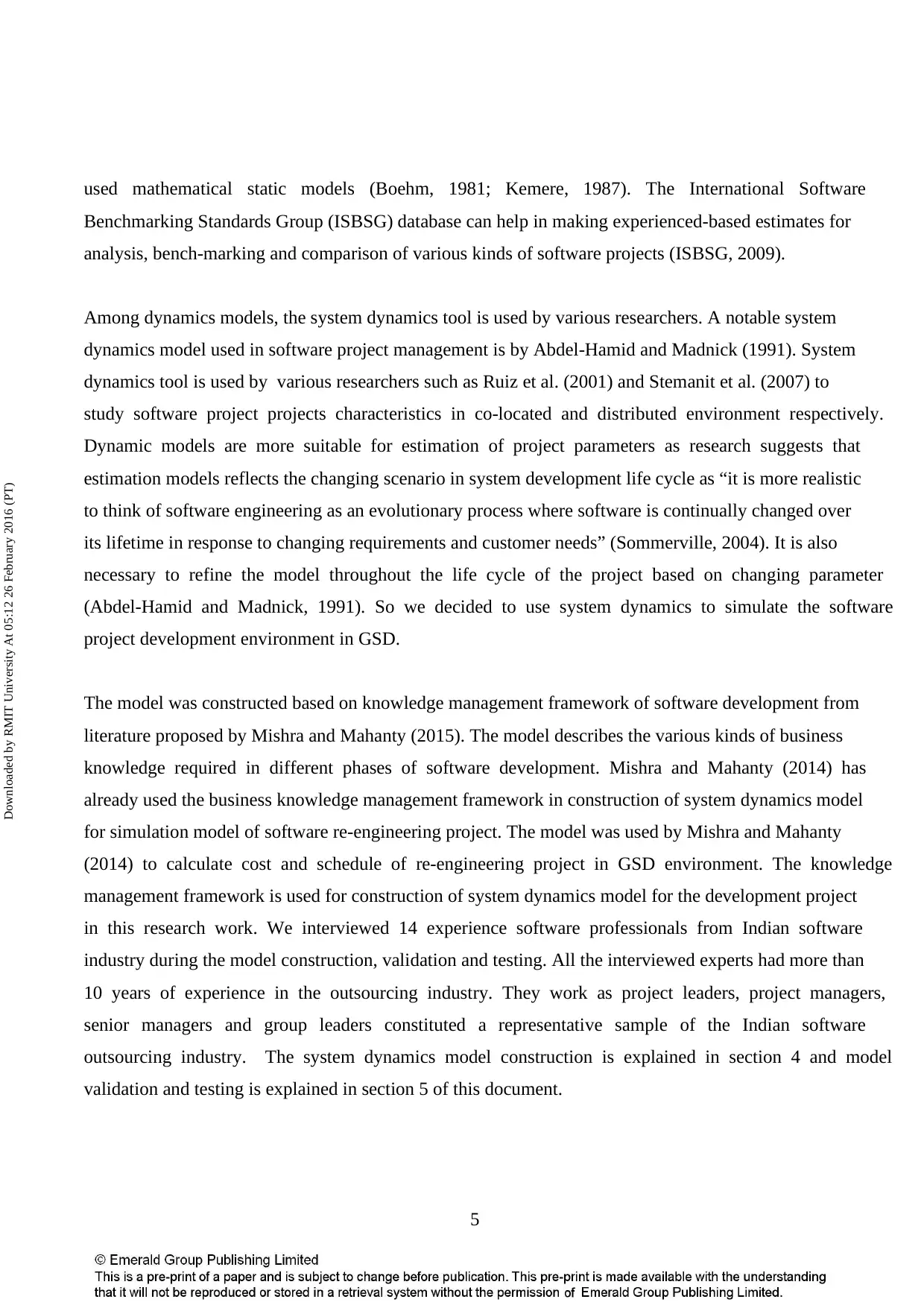
5
used mathematical static models (Boehm, 1981; Kemere, 1987). The International Software
Benchmarking Standards Group (ISBSG) database can help in making experienced-based estimates for
analysis, bench-marking and comparison of various kinds of software projects (ISBSG, 2009).
Among dynamics models, the system dynamics tool is used by various researchers. A notable system
dynamics model used in software project management is by Abdel-Hamid and Madnick (1991). System
dynamics tool is used by various researchers such as Ruiz et al. (2001) and Stemanit et al. (2007) to
study software project projects characteristics in co-located and distributed environment respectively.
Dynamic models are more suitable for estimation of project parameters as research suggests that
estimation models reflects the changing scenario in system development life cycle as “it is more realistic
to think of software engineering as an evolutionary process where software is continually changed over
its lifetime in response to changing requirements and customer needs” (Sommerville, 2004). It is also
necessary to refine the model throughout the life cycle of the project based on changing parameter
(Abdel-Hamid and Madnick, 1991). So we decided to use system dynamics to simulate the software
project development environment in GSD.
The model was constructed based on knowledge management framework of software development from
literature proposed by Mishra and Mahanty (2015). The model describes the various kinds of business
knowledge required in different phases of software development. Mishra and Mahanty (2014) has
already used the business knowledge management framework in construction of system dynamics model
for simulation model of software re-engineering project. The model was used by Mishra and Mahanty
(2014) to calculate cost and schedule of re-engineering project in GSD environment. The knowledge
management framework is used for construction of system dynamics model for the development project
in this research work. We interviewed 14 experience software professionals from Indian software
industry during the model construction, validation and testing. All the interviewed experts had more than
10 years of experience in the outsourcing industry. They work as project leaders, project managers,
senior managers and group leaders constituted a representative sample of the Indian software
outsourcing industry. The system dynamics model construction is explained in section 4 and model
validation and testing is explained in section 5 of this document.
Downloaded by RMIT University At 05:12 26 February 2016 (PT)
used mathematical static models (Boehm, 1981; Kemere, 1987). The International Software
Benchmarking Standards Group (ISBSG) database can help in making experienced-based estimates for
analysis, bench-marking and comparison of various kinds of software projects (ISBSG, 2009).
Among dynamics models, the system dynamics tool is used by various researchers. A notable system
dynamics model used in software project management is by Abdel-Hamid and Madnick (1991). System
dynamics tool is used by various researchers such as Ruiz et al. (2001) and Stemanit et al. (2007) to
study software project projects characteristics in co-located and distributed environment respectively.
Dynamic models are more suitable for estimation of project parameters as research suggests that
estimation models reflects the changing scenario in system development life cycle as “it is more realistic
to think of software engineering as an evolutionary process where software is continually changed over
its lifetime in response to changing requirements and customer needs” (Sommerville, 2004). It is also
necessary to refine the model throughout the life cycle of the project based on changing parameter
(Abdel-Hamid and Madnick, 1991). So we decided to use system dynamics to simulate the software
project development environment in GSD.
The model was constructed based on knowledge management framework of software development from
literature proposed by Mishra and Mahanty (2015). The model describes the various kinds of business
knowledge required in different phases of software development. Mishra and Mahanty (2014) has
already used the business knowledge management framework in construction of system dynamics model
for simulation model of software re-engineering project. The model was used by Mishra and Mahanty
(2014) to calculate cost and schedule of re-engineering project in GSD environment. The knowledge
management framework is used for construction of system dynamics model for the development project
in this research work. We interviewed 14 experience software professionals from Indian software
industry during the model construction, validation and testing. All the interviewed experts had more than
10 years of experience in the outsourcing industry. They work as project leaders, project managers,
senior managers and group leaders constituted a representative sample of the Indian software
outsourcing industry. The system dynamics model construction is explained in section 4 and model
validation and testing is explained in section 5 of this document.
Downloaded by RMIT University At 05:12 26 February 2016 (PT)
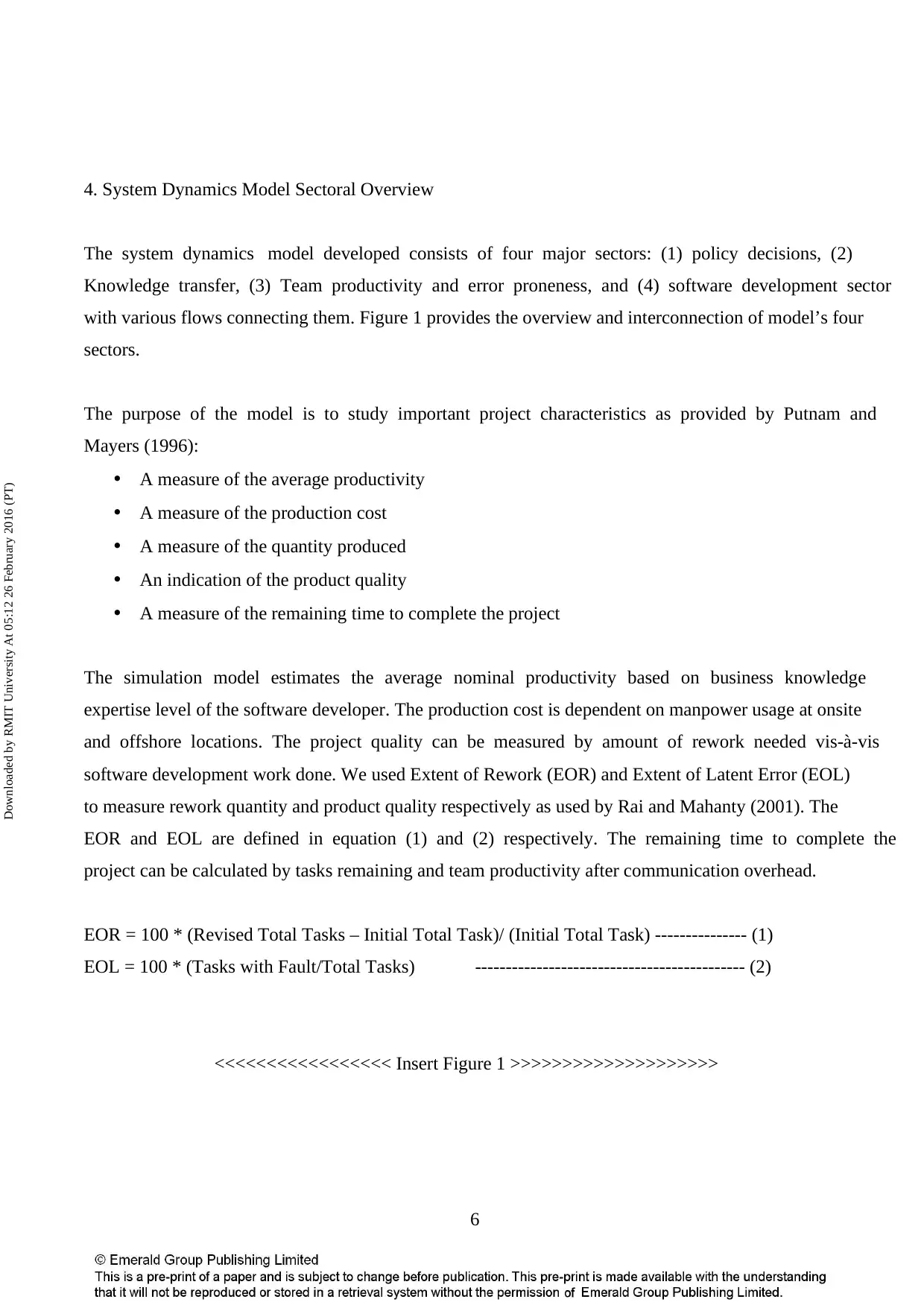
6
4. System Dynamics Model Sectoral Overview
The system dynamics model developed consists of four major sectors: (1) policy decisions, (2)
Knowledge transfer, (3) Team productivity and error proneness, and (4) software development sector
with various flows connecting them. Figure 1 provides the overview and interconnection of model’s four
sectors.
The purpose of the model is to study important project characteristics as provided by Putnam and
Mayers (1996):
• A measure of the average productivity
• A measure of the production cost
• A measure of the quantity produced
• An indication of the product quality
• A measure of the remaining time to complete the project
The simulation model estimates the average nominal productivity based on business knowledge
expertise level of the software developer. The production cost is dependent on manpower usage at onsite
and offshore locations. The project quality can be measured by amount of rework needed vis-à-vis
software development work done. We used Extent of Rework (EOR) and Extent of Latent Error (EOL)
to measure rework quantity and product quality respectively as used by Rai and Mahanty (2001). The
EOR and EOL are defined in equation (1) and (2) respectively. The remaining time to complete the
project can be calculated by tasks remaining and team productivity after communication overhead.
EOR = 100 * (Revised Total Tasks – Initial Total Task)/ (Initial Total Task) --------------- (1)
EOL = 100 * (Tasks with Fault/Total Tasks) -------------------------------------------- (2)
<<<<<<<<<<<<<<<<< Insert Figure 1 >>>>>>>>>>>>>>>>>>>>
Downloaded by RMIT University At 05:12 26 February 2016 (PT)
4. System Dynamics Model Sectoral Overview
The system dynamics model developed consists of four major sectors: (1) policy decisions, (2)
Knowledge transfer, (3) Team productivity and error proneness, and (4) software development sector
with various flows connecting them. Figure 1 provides the overview and interconnection of model’s four
sectors.
The purpose of the model is to study important project characteristics as provided by Putnam and
Mayers (1996):
• A measure of the average productivity
• A measure of the production cost
• A measure of the quantity produced
• An indication of the product quality
• A measure of the remaining time to complete the project
The simulation model estimates the average nominal productivity based on business knowledge
expertise level of the software developer. The production cost is dependent on manpower usage at onsite
and offshore locations. The project quality can be measured by amount of rework needed vis-à-vis
software development work done. We used Extent of Rework (EOR) and Extent of Latent Error (EOL)
to measure rework quantity and product quality respectively as used by Rai and Mahanty (2001). The
EOR and EOL are defined in equation (1) and (2) respectively. The remaining time to complete the
project can be calculated by tasks remaining and team productivity after communication overhead.
EOR = 100 * (Revised Total Tasks – Initial Total Task)/ (Initial Total Task) --------------- (1)
EOL = 100 * (Tasks with Fault/Total Tasks) -------------------------------------------- (2)
<<<<<<<<<<<<<<<<< Insert Figure 1 >>>>>>>>>>>>>>>>>>>>
Downloaded by RMIT University At 05:12 26 February 2016 (PT)
Paraphrase This Document
Need a fresh take? Get an instant paraphrase of this document with our AI Paraphraser
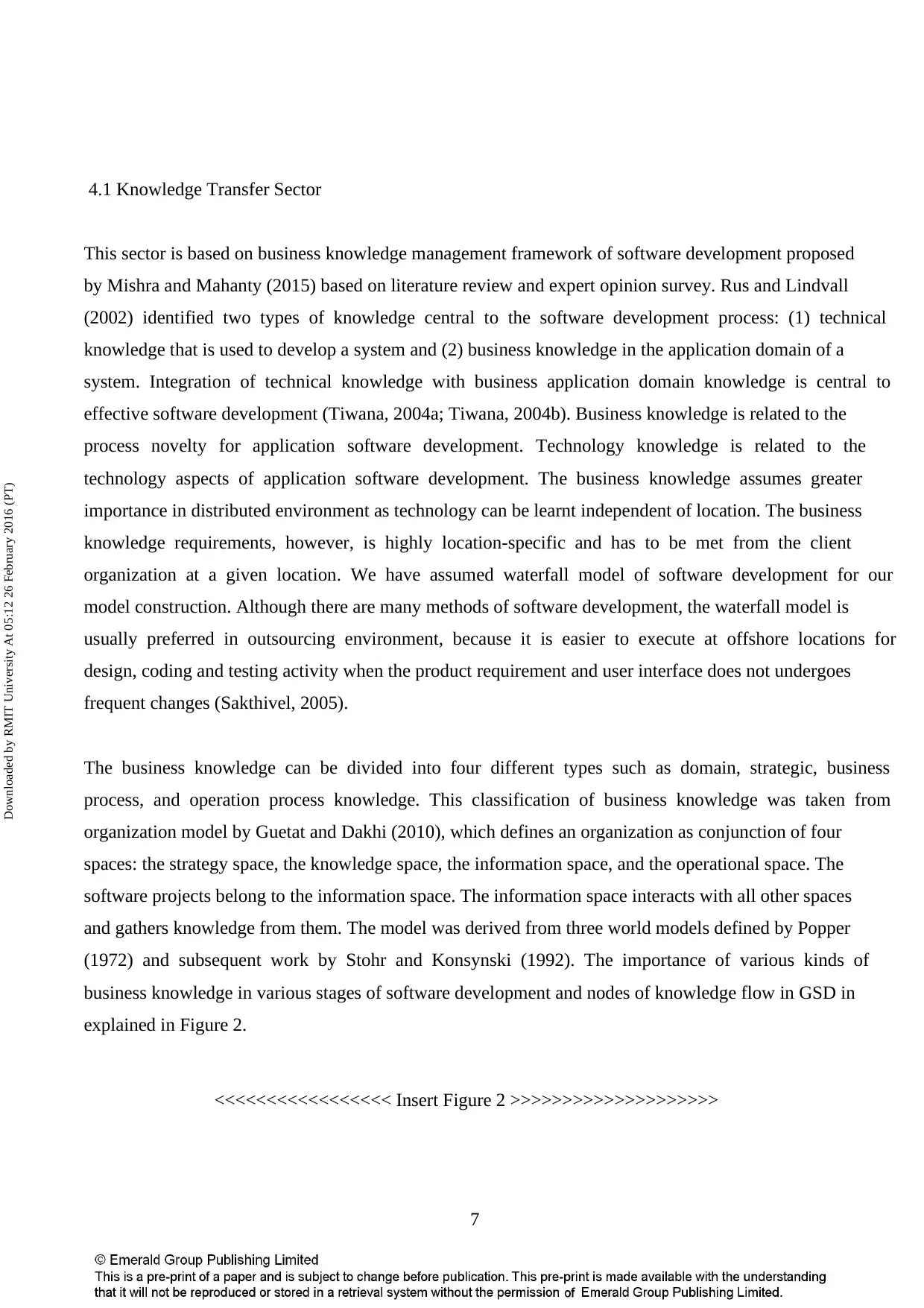
7
4.1 Knowledge Transfer Sector
This sector is based on business knowledge management framework of software development proposed
by Mishra and Mahanty (2015) based on literature review and expert opinion survey. Rus and Lindvall
(2002) identified two types of knowledge central to the software development process: (1) technical
knowledge that is used to develop a system and (2) business knowledge in the application domain of a
system. Integration of technical knowledge with business application domain knowledge is central to
effective software development (Tiwana, 2004a; Tiwana, 2004b). Business knowledge is related to the
process novelty for application software development. Technology knowledge is related to the
technology aspects of application software development. The business knowledge assumes greater
importance in distributed environment as technology can be learnt independent of location. The business
knowledge requirements, however, is highly location-specific and has to be met from the client
organization at a given location. We have assumed waterfall model of software development for our
model construction. Although there are many methods of software development, the waterfall model is
usually preferred in outsourcing environment, because it is easier to execute at offshore locations for
design, coding and testing activity when the product requirement and user interface does not undergoes
frequent changes (Sakthivel, 2005).
The business knowledge can be divided into four different types such as domain, strategic, business
process, and operation process knowledge. This classification of business knowledge was taken from
organization model by Guetat and Dakhi (2010), which defines an organization as conjunction of four
spaces: the strategy space, the knowledge space, the information space, and the operational space. The
software projects belong to the information space. The information space interacts with all other spaces
and gathers knowledge from them. The model was derived from three world models defined by Popper
(1972) and subsequent work by Stohr and Konsynski (1992). The importance of various kinds of
business knowledge in various stages of software development and nodes of knowledge flow in GSD in
explained in Figure 2.
<<<<<<<<<<<<<<<<< Insert Figure 2 >>>>>>>>>>>>>>>>>>>>
Downloaded by RMIT University At 05:12 26 February 2016 (PT)
4.1 Knowledge Transfer Sector
This sector is based on business knowledge management framework of software development proposed
by Mishra and Mahanty (2015) based on literature review and expert opinion survey. Rus and Lindvall
(2002) identified two types of knowledge central to the software development process: (1) technical
knowledge that is used to develop a system and (2) business knowledge in the application domain of a
system. Integration of technical knowledge with business application domain knowledge is central to
effective software development (Tiwana, 2004a; Tiwana, 2004b). Business knowledge is related to the
process novelty for application software development. Technology knowledge is related to the
technology aspects of application software development. The business knowledge assumes greater
importance in distributed environment as technology can be learnt independent of location. The business
knowledge requirements, however, is highly location-specific and has to be met from the client
organization at a given location. We have assumed waterfall model of software development for our
model construction. Although there are many methods of software development, the waterfall model is
usually preferred in outsourcing environment, because it is easier to execute at offshore locations for
design, coding and testing activity when the product requirement and user interface does not undergoes
frequent changes (Sakthivel, 2005).
The business knowledge can be divided into four different types such as domain, strategic, business
process, and operation process knowledge. This classification of business knowledge was taken from
organization model by Guetat and Dakhi (2010), which defines an organization as conjunction of four
spaces: the strategy space, the knowledge space, the information space, and the operational space. The
software projects belong to the information space. The information space interacts with all other spaces
and gathers knowledge from them. The model was derived from three world models defined by Popper
(1972) and subsequent work by Stohr and Konsynski (1992). The importance of various kinds of
business knowledge in various stages of software development and nodes of knowledge flow in GSD in
explained in Figure 2.
<<<<<<<<<<<<<<<<< Insert Figure 2 >>>>>>>>>>>>>>>>>>>>
Downloaded by RMIT University At 05:12 26 February 2016 (PT)
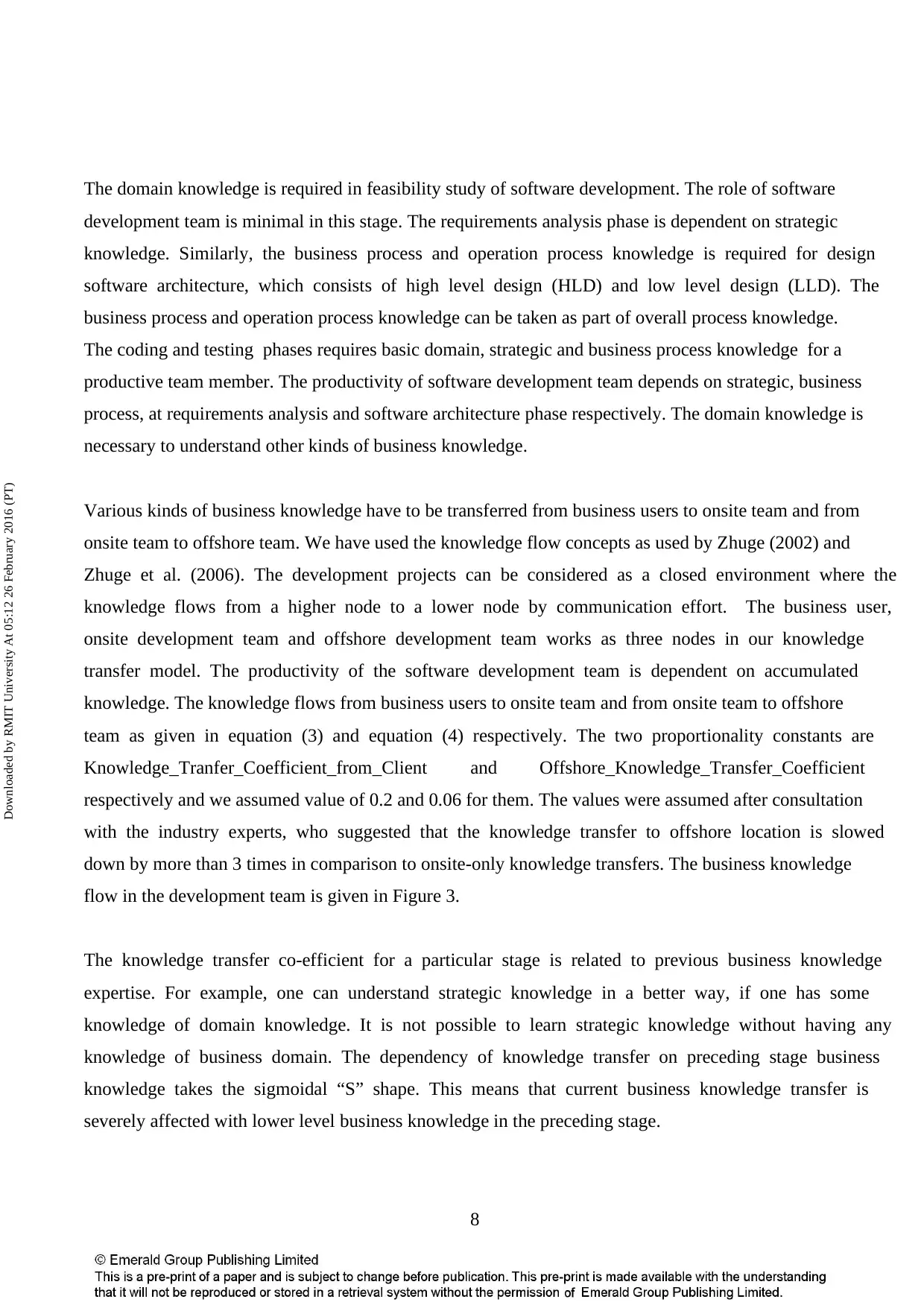
8
The domain knowledge is required in feasibility study of software development. The role of software
development team is minimal in this stage. The requirements analysis phase is dependent on strategic
knowledge. Similarly, the business process and operation process knowledge is required for design
software architecture, which consists of high level design (HLD) and low level design (LLD). The
business process and operation process knowledge can be taken as part of overall process knowledge.
The coding and testing phases requires basic domain, strategic and business process knowledge for a
productive team member. The productivity of software development team depends on strategic, business
process, at requirements analysis and software architecture phase respectively. The domain knowledge is
necessary to understand other kinds of business knowledge.
Various kinds of business knowledge have to be transferred from business users to onsite team and from
onsite team to offshore team. We have used the knowledge flow concepts as used by Zhuge (2002) and
Zhuge et al. (2006). The development projects can be considered as a closed environment where the
knowledge flows from a higher node to a lower node by communication effort. The business user,
onsite development team and offshore development team works as three nodes in our knowledge
transfer model. The productivity of the software development team is dependent on accumulated
knowledge. The knowledge flows from business users to onsite team and from onsite team to offshore
team as given in equation (3) and equation (4) respectively. The two proportionality constants are
Knowledge_Tranfer_Coefficient_from_Client and Offshore_Knowledge_Transfer_Coefficient
respectively and we assumed value of 0.2 and 0.06 for them. The values were assumed after consultation
with the industry experts, who suggested that the knowledge transfer to offshore location is slowed
down by more than 3 times in comparison to onsite-only knowledge transfers. The business knowledge
flow in the development team is given in Figure 3.
The knowledge transfer co-efficient for a particular stage is related to previous business knowledge
expertise. For example, one can understand strategic knowledge in a better way, if one has some
knowledge of domain knowledge. It is not possible to learn strategic knowledge without having any
knowledge of business domain. The dependency of knowledge transfer on preceding stage business
knowledge takes the sigmoidal “S” shape. This means that current business knowledge transfer is
severely affected with lower level business knowledge in the preceding stage.
Downloaded by RMIT University At 05:12 26 February 2016 (PT)
The domain knowledge is required in feasibility study of software development. The role of software
development team is minimal in this stage. The requirements analysis phase is dependent on strategic
knowledge. Similarly, the business process and operation process knowledge is required for design
software architecture, which consists of high level design (HLD) and low level design (LLD). The
business process and operation process knowledge can be taken as part of overall process knowledge.
The coding and testing phases requires basic domain, strategic and business process knowledge for a
productive team member. The productivity of software development team depends on strategic, business
process, at requirements analysis and software architecture phase respectively. The domain knowledge is
necessary to understand other kinds of business knowledge.
Various kinds of business knowledge have to be transferred from business users to onsite team and from
onsite team to offshore team. We have used the knowledge flow concepts as used by Zhuge (2002) and
Zhuge et al. (2006). The development projects can be considered as a closed environment where the
knowledge flows from a higher node to a lower node by communication effort. The business user,
onsite development team and offshore development team works as three nodes in our knowledge
transfer model. The productivity of the software development team is dependent on accumulated
knowledge. The knowledge flows from business users to onsite team and from onsite team to offshore
team as given in equation (3) and equation (4) respectively. The two proportionality constants are
Knowledge_Tranfer_Coefficient_from_Client and Offshore_Knowledge_Transfer_Coefficient
respectively and we assumed value of 0.2 and 0.06 for them. The values were assumed after consultation
with the industry experts, who suggested that the knowledge transfer to offshore location is slowed
down by more than 3 times in comparison to onsite-only knowledge transfers. The business knowledge
flow in the development team is given in Figure 3.
The knowledge transfer co-efficient for a particular stage is related to previous business knowledge
expertise. For example, one can understand strategic knowledge in a better way, if one has some
knowledge of domain knowledge. It is not possible to learn strategic knowledge without having any
knowledge of business domain. The dependency of knowledge transfer on preceding stage business
knowledge takes the sigmoidal “S” shape. This means that current business knowledge transfer is
severely affected with lower level business knowledge in the preceding stage.
Downloaded by RMIT University At 05:12 26 February 2016 (PT)
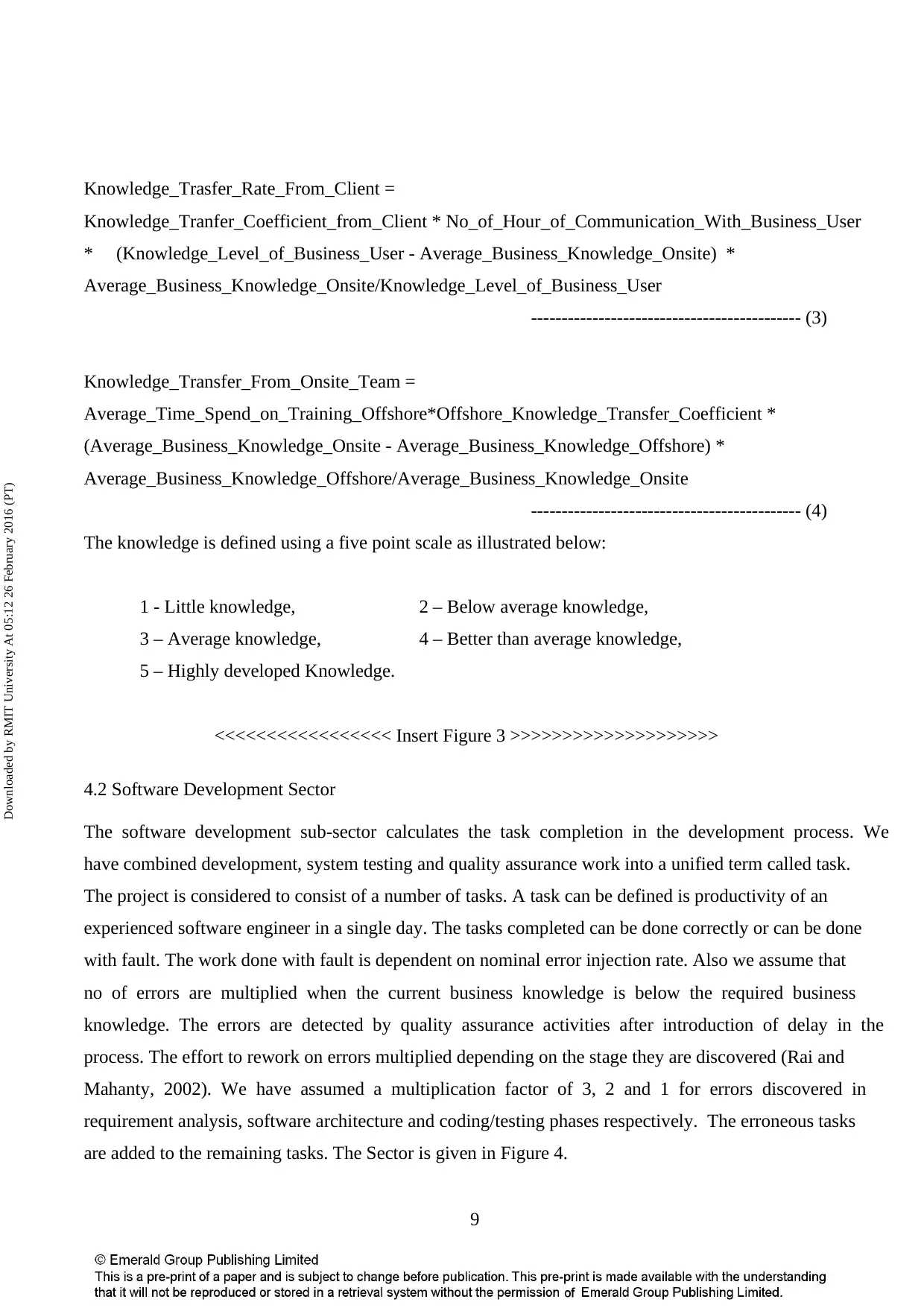
9
Knowledge_Trasfer_Rate_From_Client =
Knowledge_Tranfer_Coefficient_from_Client * No_of_Hour_of_Communication_With_Business_User
* (Knowledge_Level_of_Business_User - Average_Business_Knowledge_Onsite) *
Average_Business_Knowledge_Onsite/Knowledge_Level_of_Business_User
-------------------------------------------- (3)
Knowledge_Transfer_From_Onsite_Team =
Average_Time_Spend_on_Training_Offshore*Offshore_Knowledge_Transfer_Coefficient *
(Average_Business_Knowledge_Onsite - Average_Business_Knowledge_Offshore) *
Average_Business_Knowledge_Offshore/Average_Business_Knowledge_Onsite
-------------------------------------------- (4)
The knowledge is defined using a five point scale as illustrated below:
1 - Little knowledge, 2 – Below average knowledge,
3 – Average knowledge, 4 – Better than average knowledge,
5 – Highly developed Knowledge.
<<<<<<<<<<<<<<<<< Insert Figure 3 >>>>>>>>>>>>>>>>>>>>
4.2 Software Development Sector
The software development sub-sector calculates the task completion in the development process. We
have combined development, system testing and quality assurance work into a unified term called task.
The project is considered to consist of a number of tasks. A task can be defined is productivity of an
experienced software engineer in a single day. The tasks completed can be done correctly or can be done
with fault. The work done with fault is dependent on nominal error injection rate. Also we assume that
no of errors are multiplied when the current business knowledge is below the required business
knowledge. The errors are detected by quality assurance activities after introduction of delay in the
process. The effort to rework on errors multiplied depending on the stage they are discovered (Rai and
Mahanty, 2002). We have assumed a multiplication factor of 3, 2 and 1 for errors discovered in
requirement analysis, software architecture and coding/testing phases respectively. The erroneous tasks
are added to the remaining tasks. The Sector is given in Figure 4.
Downloaded by RMIT University At 05:12 26 February 2016 (PT)
Knowledge_Trasfer_Rate_From_Client =
Knowledge_Tranfer_Coefficient_from_Client * No_of_Hour_of_Communication_With_Business_User
* (Knowledge_Level_of_Business_User - Average_Business_Knowledge_Onsite) *
Average_Business_Knowledge_Onsite/Knowledge_Level_of_Business_User
-------------------------------------------- (3)
Knowledge_Transfer_From_Onsite_Team =
Average_Time_Spend_on_Training_Offshore*Offshore_Knowledge_Transfer_Coefficient *
(Average_Business_Knowledge_Onsite - Average_Business_Knowledge_Offshore) *
Average_Business_Knowledge_Offshore/Average_Business_Knowledge_Onsite
-------------------------------------------- (4)
The knowledge is defined using a five point scale as illustrated below:
1 - Little knowledge, 2 – Below average knowledge,
3 – Average knowledge, 4 – Better than average knowledge,
5 – Highly developed Knowledge.
<<<<<<<<<<<<<<<<< Insert Figure 3 >>>>>>>>>>>>>>>>>>>>
4.2 Software Development Sector
The software development sub-sector calculates the task completion in the development process. We
have combined development, system testing and quality assurance work into a unified term called task.
The project is considered to consist of a number of tasks. A task can be defined is productivity of an
experienced software engineer in a single day. The tasks completed can be done correctly or can be done
with fault. The work done with fault is dependent on nominal error injection rate. Also we assume that
no of errors are multiplied when the current business knowledge is below the required business
knowledge. The errors are detected by quality assurance activities after introduction of delay in the
process. The effort to rework on errors multiplied depending on the stage they are discovered (Rai and
Mahanty, 2002). We have assumed a multiplication factor of 3, 2 and 1 for errors discovered in
requirement analysis, software architecture and coding/testing phases respectively. The erroneous tasks
are added to the remaining tasks. The Sector is given in Figure 4.
Downloaded by RMIT University At 05:12 26 February 2016 (PT)
Secure Best Marks with AI Grader
Need help grading? Try our AI Grader for instant feedback on your assignments.
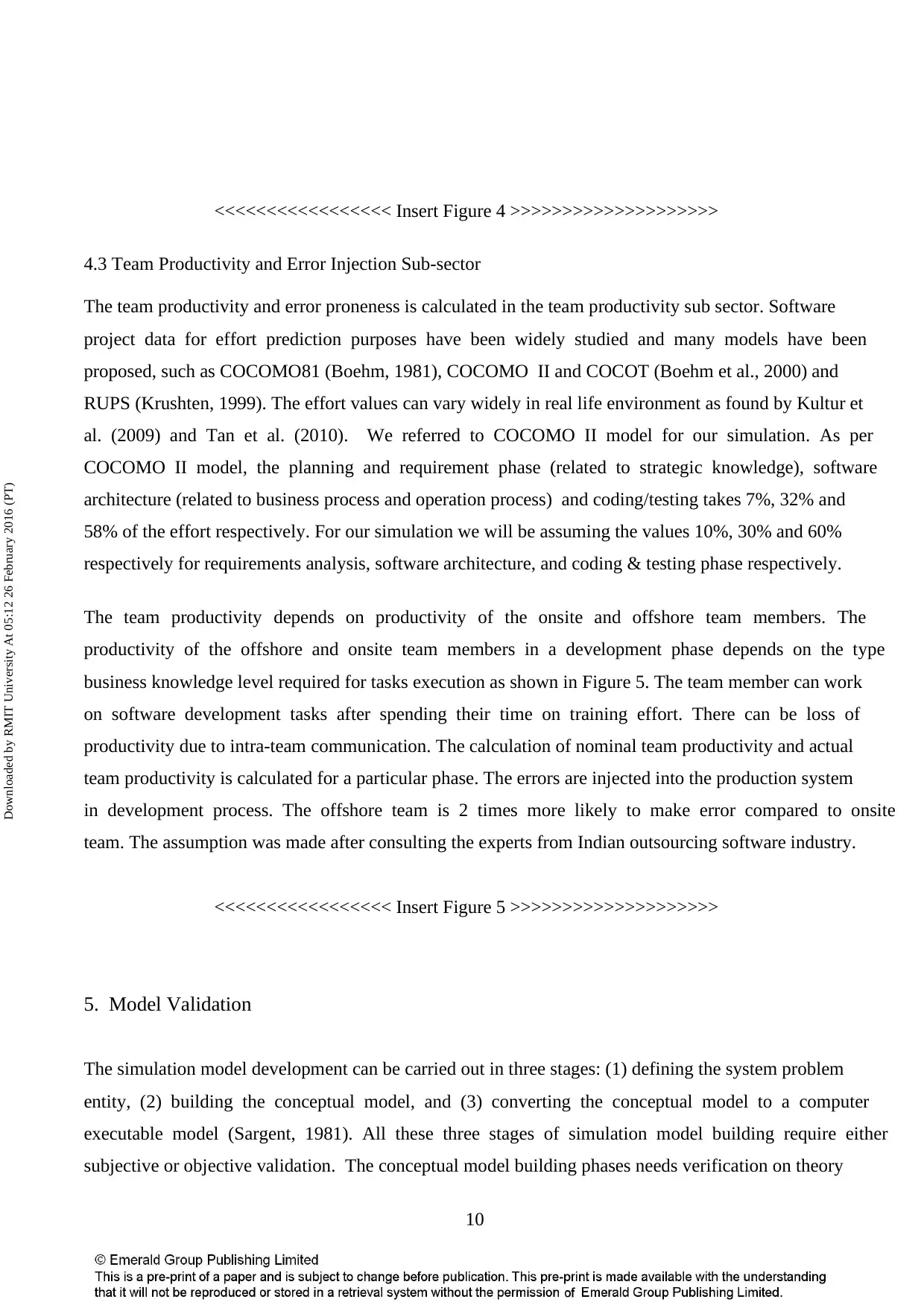
10
<<<<<<<<<<<<<<<<< Insert Figure 4 >>>>>>>>>>>>>>>>>>>>
4.3 Team Productivity and Error Injection Sub-sector
The team productivity and error proneness is calculated in the team productivity sub sector. Software
project data for effort prediction purposes have been widely studied and many models have been
proposed, such as COCOMO81 (Boehm, 1981), COCOMO II and COCOT (Boehm et al., 2000) and
RUPS (Krushten, 1999). The effort values can vary widely in real life environment as found by Kultur et
al. (2009) and Tan et al. (2010). We referred to COCOMO II model for our simulation. As per
COCOMO II model, the planning and requirement phase (related to strategic knowledge), software
architecture (related to business process and operation process) and coding/testing takes 7%, 32% and
58% of the effort respectively. For our simulation we will be assuming the values 10%, 30% and 60%
respectively for requirements analysis, software architecture, and coding & testing phase respectively.
The team productivity depends on productivity of the onsite and offshore team members. The
productivity of the offshore and onsite team members in a development phase depends on the type
business knowledge level required for tasks execution as shown in Figure 5. The team member can work
on software development tasks after spending their time on training effort. There can be loss of
productivity due to intra-team communication. The calculation of nominal team productivity and actual
team productivity is calculated for a particular phase. The errors are injected into the production system
in development process. The offshore team is 2 times more likely to make error compared to onsite
team. The assumption was made after consulting the experts from Indian outsourcing software industry.
<<<<<<<<<<<<<<<<< Insert Figure 5 >>>>>>>>>>>>>>>>>>>>
5. Model Validation
The simulation model development can be carried out in three stages: (1) defining the system problem
entity, (2) building the conceptual model, and (3) converting the conceptual model to a computer
executable model (Sargent, 1981). All these three stages of simulation model building require either
subjective or objective validation. The conceptual model building phases needs verification on theory
Downloaded by RMIT University At 05:12 26 February 2016 (PT)
<<<<<<<<<<<<<<<<< Insert Figure 4 >>>>>>>>>>>>>>>>>>>>
4.3 Team Productivity and Error Injection Sub-sector
The team productivity and error proneness is calculated in the team productivity sub sector. Software
project data for effort prediction purposes have been widely studied and many models have been
proposed, such as COCOMO81 (Boehm, 1981), COCOMO II and COCOT (Boehm et al., 2000) and
RUPS (Krushten, 1999). The effort values can vary widely in real life environment as found by Kultur et
al. (2009) and Tan et al. (2010). We referred to COCOMO II model for our simulation. As per
COCOMO II model, the planning and requirement phase (related to strategic knowledge), software
architecture (related to business process and operation process) and coding/testing takes 7%, 32% and
58% of the effort respectively. For our simulation we will be assuming the values 10%, 30% and 60%
respectively for requirements analysis, software architecture, and coding & testing phase respectively.
The team productivity depends on productivity of the onsite and offshore team members. The
productivity of the offshore and onsite team members in a development phase depends on the type
business knowledge level required for tasks execution as shown in Figure 5. The team member can work
on software development tasks after spending their time on training effort. There can be loss of
productivity due to intra-team communication. The calculation of nominal team productivity and actual
team productivity is calculated for a particular phase. The errors are injected into the production system
in development process. The offshore team is 2 times more likely to make error compared to onsite
team. The assumption was made after consulting the experts from Indian outsourcing software industry.
<<<<<<<<<<<<<<<<< Insert Figure 5 >>>>>>>>>>>>>>>>>>>>
5. Model Validation
The simulation model development can be carried out in three stages: (1) defining the system problem
entity, (2) building the conceptual model, and (3) converting the conceptual model to a computer
executable model (Sargent, 1981). All these three stages of simulation model building require either
subjective or objective validation. The conceptual model building phases needs verification on theory
Downloaded by RMIT University At 05:12 26 February 2016 (PT)
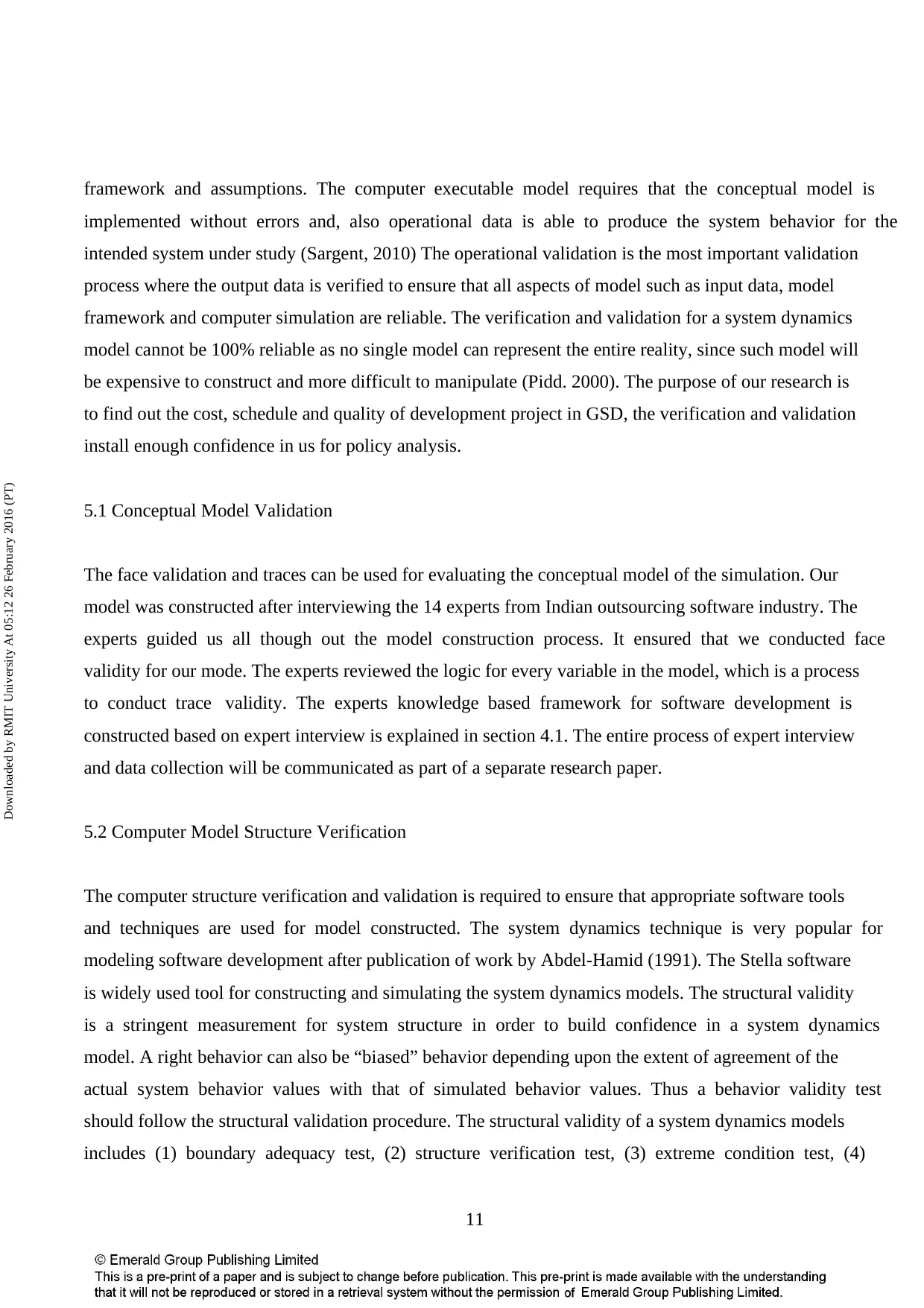
11
framework and assumptions. The computer executable model requires that the conceptual model is
implemented without errors and, also operational data is able to produce the system behavior for the
intended system under study (Sargent, 2010) The operational validation is the most important validation
process where the output data is verified to ensure that all aspects of model such as input data, model
framework and computer simulation are reliable. The verification and validation for a system dynamics
model cannot be 100% reliable as no single model can represent the entire reality, since such model will
be expensive to construct and more difficult to manipulate (Pidd. 2000). The purpose of our research is
to find out the cost, schedule and quality of development project in GSD, the verification and validation
install enough confidence in us for policy analysis.
5.1 Conceptual Model Validation
The face validation and traces can be used for evaluating the conceptual model of the simulation. Our
model was constructed after interviewing the 14 experts from Indian outsourcing software industry. The
experts guided us all though out the model construction process. It ensured that we conducted face
validity for our mode. The experts reviewed the logic for every variable in the model, which is a process
to conduct trace validity. The experts knowledge based framework for software development is
constructed based on expert interview is explained in section 4.1. The entire process of expert interview
and data collection will be communicated as part of a separate research paper.
5.2 Computer Model Structure Verification
The computer structure verification and validation is required to ensure that appropriate software tools
and techniques are used for model constructed. The system dynamics technique is very popular for
modeling software development after publication of work by Abdel-Hamid (1991). The Stella software
is widely used tool for constructing and simulating the system dynamics models. The structural validity
is a stringent measurement for system structure in order to build confidence in a system dynamics
model. A right behavior can also be “biased” behavior depending upon the extent of agreement of the
actual system behavior values with that of simulated behavior values. Thus a behavior validity test
should follow the structural validation procedure. The structural validity of a system dynamics models
includes (1) boundary adequacy test, (2) structure verification test, (3) extreme condition test, (4)
Downloaded by RMIT University At 05:12 26 February 2016 (PT)
framework and assumptions. The computer executable model requires that the conceptual model is
implemented without errors and, also operational data is able to produce the system behavior for the
intended system under study (Sargent, 2010) The operational validation is the most important validation
process where the output data is verified to ensure that all aspects of model such as input data, model
framework and computer simulation are reliable. The verification and validation for a system dynamics
model cannot be 100% reliable as no single model can represent the entire reality, since such model will
be expensive to construct and more difficult to manipulate (Pidd. 2000). The purpose of our research is
to find out the cost, schedule and quality of development project in GSD, the verification and validation
install enough confidence in us for policy analysis.
5.1 Conceptual Model Validation
The face validation and traces can be used for evaluating the conceptual model of the simulation. Our
model was constructed after interviewing the 14 experts from Indian outsourcing software industry. The
experts guided us all though out the model construction process. It ensured that we conducted face
validity for our mode. The experts reviewed the logic for every variable in the model, which is a process
to conduct trace validity. The experts knowledge based framework for software development is
constructed based on expert interview is explained in section 4.1. The entire process of expert interview
and data collection will be communicated as part of a separate research paper.
5.2 Computer Model Structure Verification
The computer structure verification and validation is required to ensure that appropriate software tools
and techniques are used for model constructed. The system dynamics technique is very popular for
modeling software development after publication of work by Abdel-Hamid (1991). The Stella software
is widely used tool for constructing and simulating the system dynamics models. The structural validity
is a stringent measurement for system structure in order to build confidence in a system dynamics
model. A right behavior can also be “biased” behavior depending upon the extent of agreement of the
actual system behavior values with that of simulated behavior values. Thus a behavior validity test
should follow the structural validation procedure. The structural validity of a system dynamics models
includes (1) boundary adequacy test, (2) structure verification test, (3) extreme condition test, (4)
Downloaded by RMIT University At 05:12 26 February 2016 (PT)
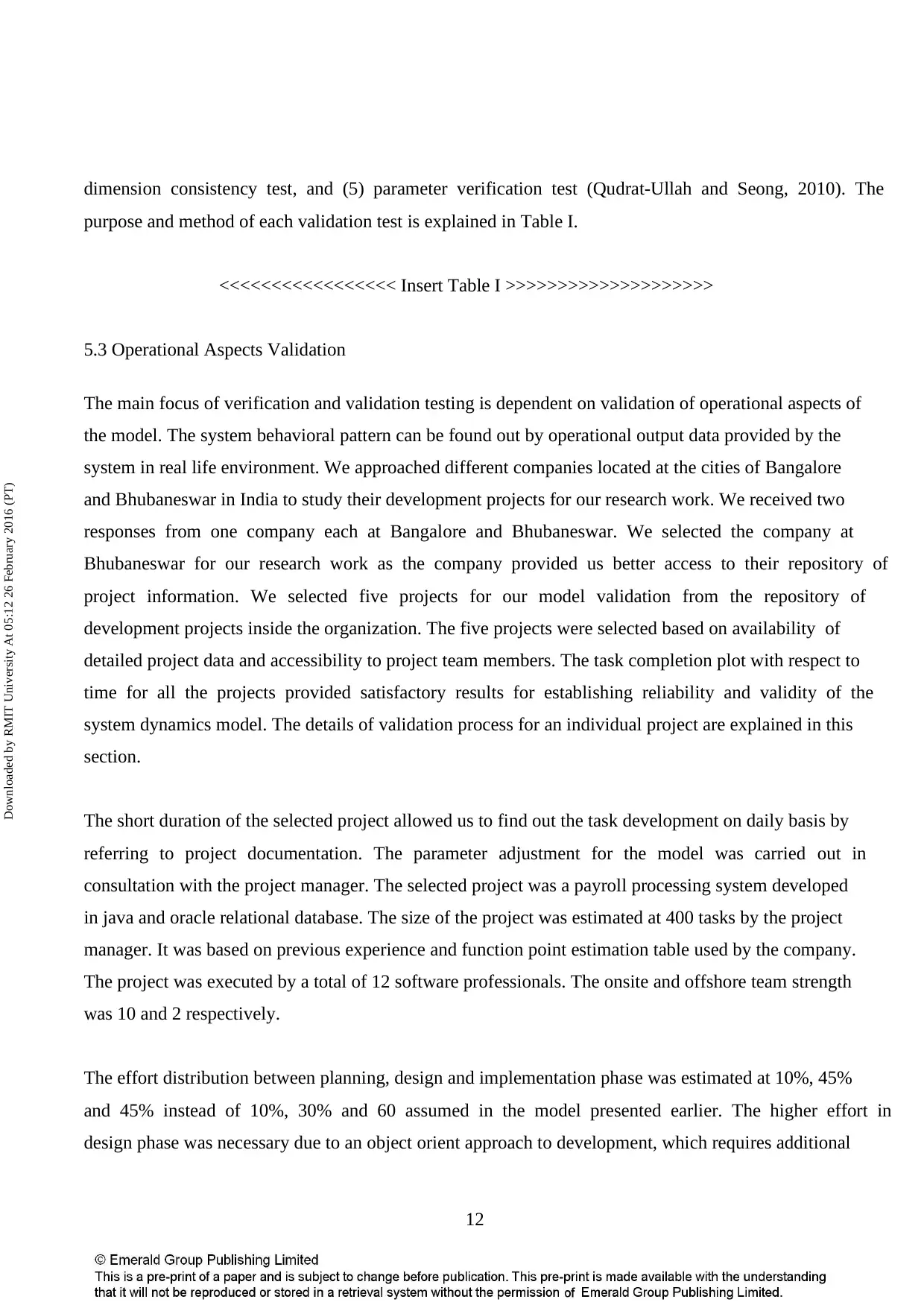
12
dimension consistency test, and (5) parameter verification test (Qudrat-Ullah and Seong, 2010). The
purpose and method of each validation test is explained in Table I.
<<<<<<<<<<<<<<<<< Insert Table I >>>>>>>>>>>>>>>>>>>>
5.3 Operational Aspects Validation
The main focus of verification and validation testing is dependent on validation of operational aspects of
the model. The system behavioral pattern can be found out by operational output data provided by the
system in real life environment. We approached different companies located at the cities of Bangalore
and Bhubaneswar in India to study their development projects for our research work. We received two
responses from one company each at Bangalore and Bhubaneswar. We selected the company at
Bhubaneswar for our research work as the company provided us better access to their repository of
project information. We selected five projects for our model validation from the repository of
development projects inside the organization. The five projects were selected based on availability of
detailed project data and accessibility to project team members. The task completion plot with respect to
time for all the projects provided satisfactory results for establishing reliability and validity of the
system dynamics model. The details of validation process for an individual project are explained in this
section.
The short duration of the selected project allowed us to find out the task development on daily basis by
referring to project documentation. The parameter adjustment for the model was carried out in
consultation with the project manager. The selected project was a payroll processing system developed
in java and oracle relational database. The size of the project was estimated at 400 tasks by the project
manager. It was based on previous experience and function point estimation table used by the company.
The project was executed by a total of 12 software professionals. The onsite and offshore team strength
was 10 and 2 respectively.
The effort distribution between planning, design and implementation phase was estimated at 10%, 45%
and 45% instead of 10%, 30% and 60 assumed in the model presented earlier. The higher effort in
design phase was necessary due to an object orient approach to development, which requires additional
Downloaded by RMIT University At 05:12 26 February 2016 (PT)
dimension consistency test, and (5) parameter verification test (Qudrat-Ullah and Seong, 2010). The
purpose and method of each validation test is explained in Table I.
<<<<<<<<<<<<<<<<< Insert Table I >>>>>>>>>>>>>>>>>>>>
5.3 Operational Aspects Validation
The main focus of verification and validation testing is dependent on validation of operational aspects of
the model. The system behavioral pattern can be found out by operational output data provided by the
system in real life environment. We approached different companies located at the cities of Bangalore
and Bhubaneswar in India to study their development projects for our research work. We received two
responses from one company each at Bangalore and Bhubaneswar. We selected the company at
Bhubaneswar for our research work as the company provided us better access to their repository of
project information. We selected five projects for our model validation from the repository of
development projects inside the organization. The five projects were selected based on availability of
detailed project data and accessibility to project team members. The task completion plot with respect to
time for all the projects provided satisfactory results for establishing reliability and validity of the
system dynamics model. The details of validation process for an individual project are explained in this
section.
The short duration of the selected project allowed us to find out the task development on daily basis by
referring to project documentation. The parameter adjustment for the model was carried out in
consultation with the project manager. The selected project was a payroll processing system developed
in java and oracle relational database. The size of the project was estimated at 400 tasks by the project
manager. It was based on previous experience and function point estimation table used by the company.
The project was executed by a total of 12 software professionals. The onsite and offshore team strength
was 10 and 2 respectively.
The effort distribution between planning, design and implementation phase was estimated at 10%, 45%
and 45% instead of 10%, 30% and 60 assumed in the model presented earlier. The higher effort in
design phase was necessary due to an object orient approach to development, which requires additional
Downloaded by RMIT University At 05:12 26 February 2016 (PT)
Paraphrase This Document
Need a fresh take? Get an instant paraphrase of this document with our AI Paraphraser
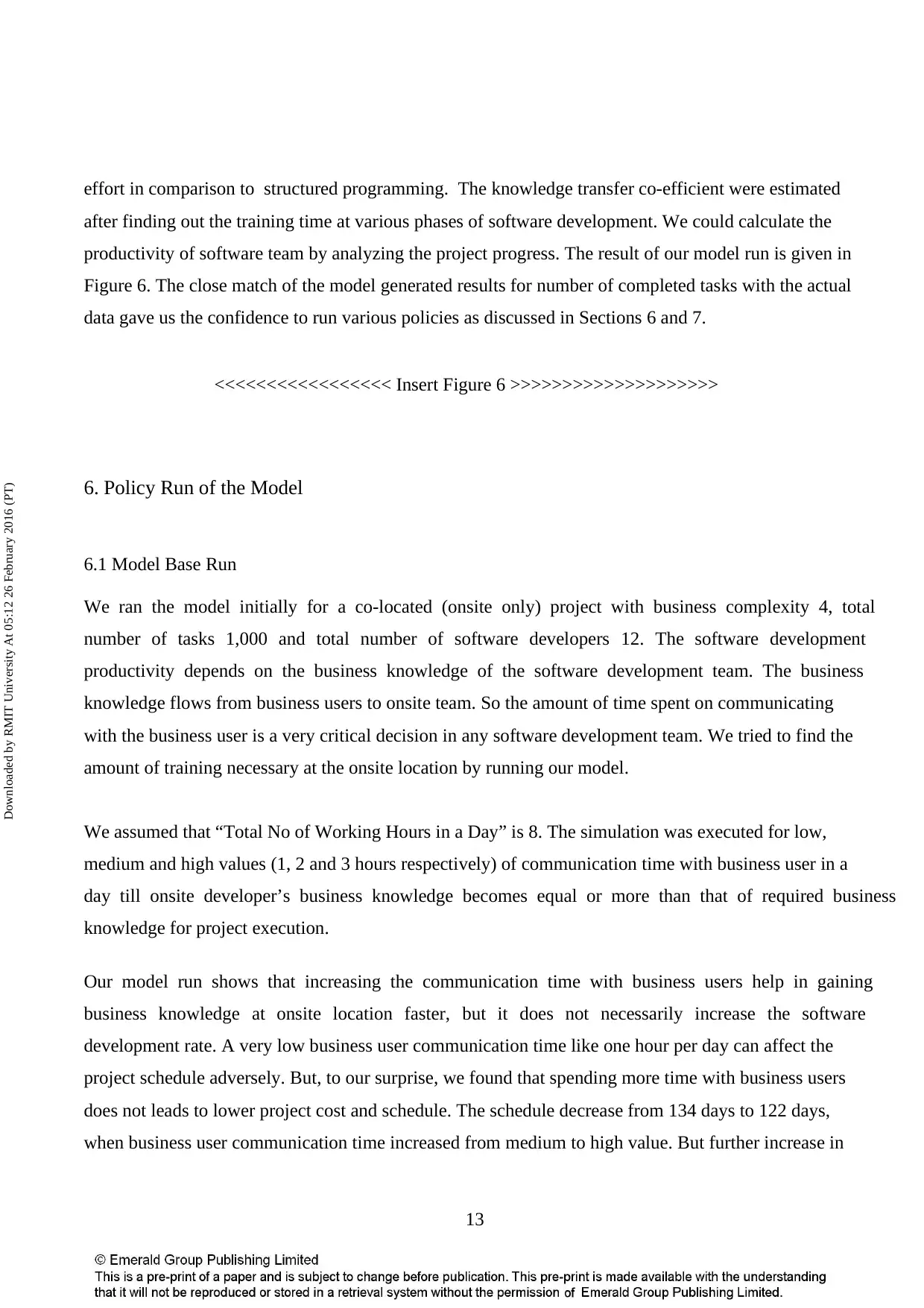
13
effort in comparison to structured programming. The knowledge transfer co-efficient were estimated
after finding out the training time at various phases of software development. We could calculate the
productivity of software team by analyzing the project progress. The result of our model run is given in
Figure 6. The close match of the model generated results for number of completed tasks with the actual
data gave us the confidence to run various policies as discussed in Sections 6 and 7.
<<<<<<<<<<<<<<<<< Insert Figure 6 >>>>>>>>>>>>>>>>>>>>
6. Policy Run of the Model
6.1 Model Base Run
We ran the model initially for a co-located (onsite only) project with business complexity 4, total
number of tasks 1,000 and total number of software developers 12. The software development
productivity depends on the business knowledge of the software development team. The business
knowledge flows from business users to onsite team. So the amount of time spent on communicating
with the business user is a very critical decision in any software development team. We tried to find the
amount of training necessary at the onsite location by running our model.
We assumed that “Total No of Working Hours in a Day” is 8. The simulation was executed for low,
medium and high values (1, 2 and 3 hours respectively) of communication time with business user in a
day till onsite developer’s business knowledge becomes equal or more than that of required business
knowledge for project execution.
Our model run shows that increasing the communication time with business users help in gaining
business knowledge at onsite location faster, but it does not necessarily increase the software
development rate. A very low business user communication time like one hour per day can affect the
project schedule adversely. But, to our surprise, we found that spending more time with business users
does not leads to lower project cost and schedule. The schedule decrease from 134 days to 122 days,
when business user communication time increased from medium to high value. But further increase in
Downloaded by RMIT University At 05:12 26 February 2016 (PT)
effort in comparison to structured programming. The knowledge transfer co-efficient were estimated
after finding out the training time at various phases of software development. We could calculate the
productivity of software team by analyzing the project progress. The result of our model run is given in
Figure 6. The close match of the model generated results for number of completed tasks with the actual
data gave us the confidence to run various policies as discussed in Sections 6 and 7.
<<<<<<<<<<<<<<<<< Insert Figure 6 >>>>>>>>>>>>>>>>>>>>
6. Policy Run of the Model
6.1 Model Base Run
We ran the model initially for a co-located (onsite only) project with business complexity 4, total
number of tasks 1,000 and total number of software developers 12. The software development
productivity depends on the business knowledge of the software development team. The business
knowledge flows from business users to onsite team. So the amount of time spent on communicating
with the business user is a very critical decision in any software development team. We tried to find the
amount of training necessary at the onsite location by running our model.
We assumed that “Total No of Working Hours in a Day” is 8. The simulation was executed for low,
medium and high values (1, 2 and 3 hours respectively) of communication time with business user in a
day till onsite developer’s business knowledge becomes equal or more than that of required business
knowledge for project execution.
Our model run shows that increasing the communication time with business users help in gaining
business knowledge at onsite location faster, but it does not necessarily increase the software
development rate. A very low business user communication time like one hour per day can affect the
project schedule adversely. But, to our surprise, we found that spending more time with business users
does not leads to lower project cost and schedule. The schedule decrease from 134 days to 122 days,
when business user communication time increased from medium to high value. But further increase in
Downloaded by RMIT University At 05:12 26 February 2016 (PT)
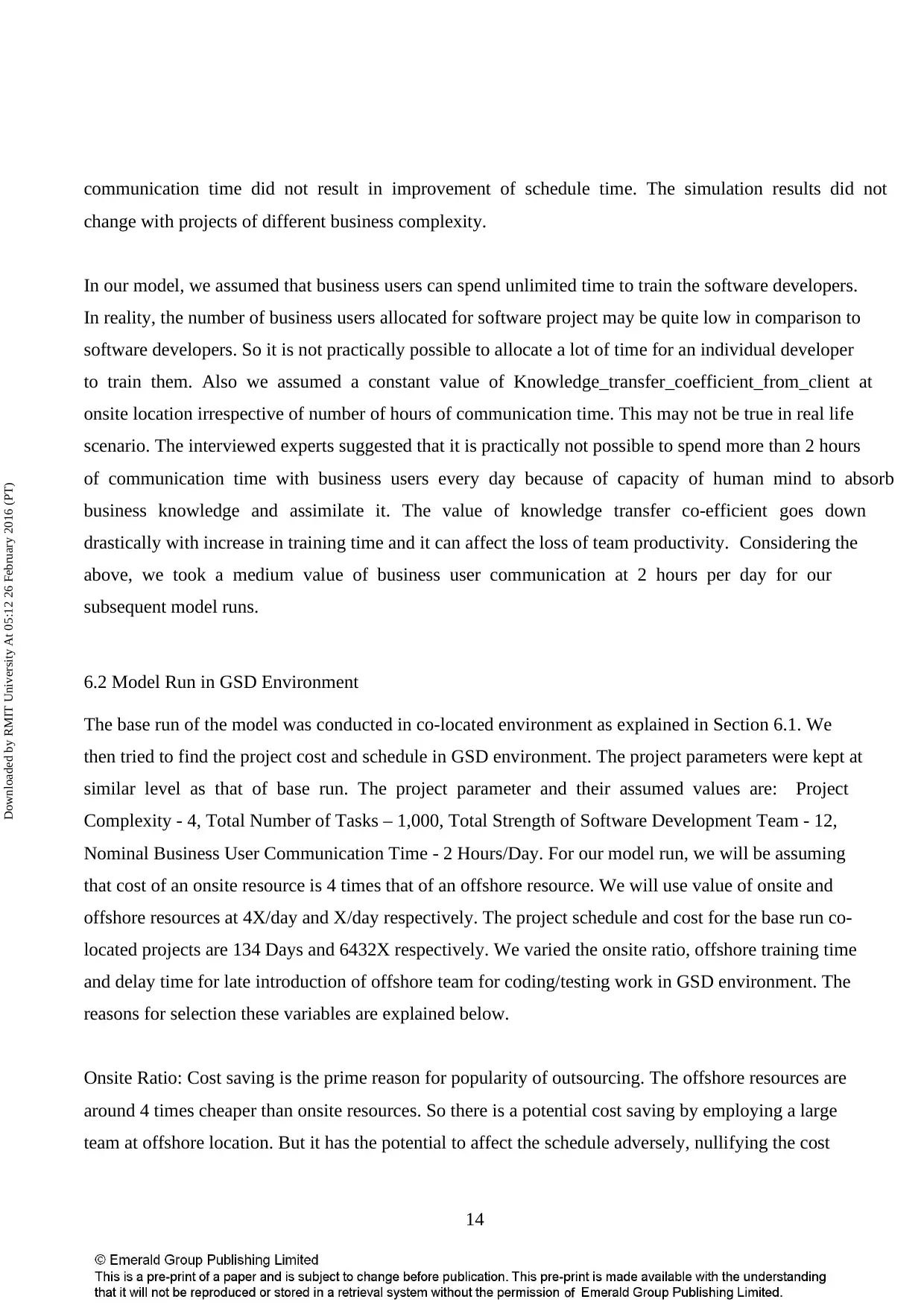
14
communication time did not result in improvement of schedule time. The simulation results did not
change with projects of different business complexity.
In our model, we assumed that business users can spend unlimited time to train the software developers.
In reality, the number of business users allocated for software project may be quite low in comparison to
software developers. So it is not practically possible to allocate a lot of time for an individual developer
to train them. Also we assumed a constant value of Knowledge_transfer_coefficient_from_client at
onsite location irrespective of number of hours of communication time. This may not be true in real life
scenario. The interviewed experts suggested that it is practically not possible to spend more than 2 hours
of communication time with business users every day because of capacity of human mind to absorb
business knowledge and assimilate it. The value of knowledge transfer co-efficient goes down
drastically with increase in training time and it can affect the loss of team productivity. Considering the
above, we took a medium value of business user communication at 2 hours per day for our
subsequent model runs.
6.2 Model Run in GSD Environment
The base run of the model was conducted in co-located environment as explained in Section 6.1. We
then tried to find the project cost and schedule in GSD environment. The project parameters were kept at
similar level as that of base run. The project parameter and their assumed values are: Project
Complexity - 4, Total Number of Tasks – 1,000, Total Strength of Software Development Team - 12,
Nominal Business User Communication Time - 2 Hours/Day. For our model run, we will be assuming
that cost of an onsite resource is 4 times that of an offshore resource. We will use value of onsite and
offshore resources at 4X/day and X/day respectively. The project schedule and cost for the base run co-
located projects are 134 Days and 6432X respectively. We varied the onsite ratio, offshore training time
and delay time for late introduction of offshore team for coding/testing work in GSD environment. The
reasons for selection these variables are explained below.
Onsite Ratio: Cost saving is the prime reason for popularity of outsourcing. The offshore resources are
around 4 times cheaper than onsite resources. So there is a potential cost saving by employing a large
team at offshore location. But it has the potential to affect the schedule adversely, nullifying the cost
Downloaded by RMIT University At 05:12 26 February 2016 (PT)
communication time did not result in improvement of schedule time. The simulation results did not
change with projects of different business complexity.
In our model, we assumed that business users can spend unlimited time to train the software developers.
In reality, the number of business users allocated for software project may be quite low in comparison to
software developers. So it is not practically possible to allocate a lot of time for an individual developer
to train them. Also we assumed a constant value of Knowledge_transfer_coefficient_from_client at
onsite location irrespective of number of hours of communication time. This may not be true in real life
scenario. The interviewed experts suggested that it is practically not possible to spend more than 2 hours
of communication time with business users every day because of capacity of human mind to absorb
business knowledge and assimilate it. The value of knowledge transfer co-efficient goes down
drastically with increase in training time and it can affect the loss of team productivity. Considering the
above, we took a medium value of business user communication at 2 hours per day for our
subsequent model runs.
6.2 Model Run in GSD Environment
The base run of the model was conducted in co-located environment as explained in Section 6.1. We
then tried to find the project cost and schedule in GSD environment. The project parameters were kept at
similar level as that of base run. The project parameter and their assumed values are: Project
Complexity - 4, Total Number of Tasks – 1,000, Total Strength of Software Development Team - 12,
Nominal Business User Communication Time - 2 Hours/Day. For our model run, we will be assuming
that cost of an onsite resource is 4 times that of an offshore resource. We will use value of onsite and
offshore resources at 4X/day and X/day respectively. The project schedule and cost for the base run co-
located projects are 134 Days and 6432X respectively. We varied the onsite ratio, offshore training time
and delay time for late introduction of offshore team for coding/testing work in GSD environment. The
reasons for selection these variables are explained below.
Onsite Ratio: Cost saving is the prime reason for popularity of outsourcing. The offshore resources are
around 4 times cheaper than onsite resources. So there is a potential cost saving by employing a large
team at offshore location. But it has the potential to affect the schedule adversely, nullifying the cost
Downloaded by RMIT University At 05:12 26 February 2016 (PT)
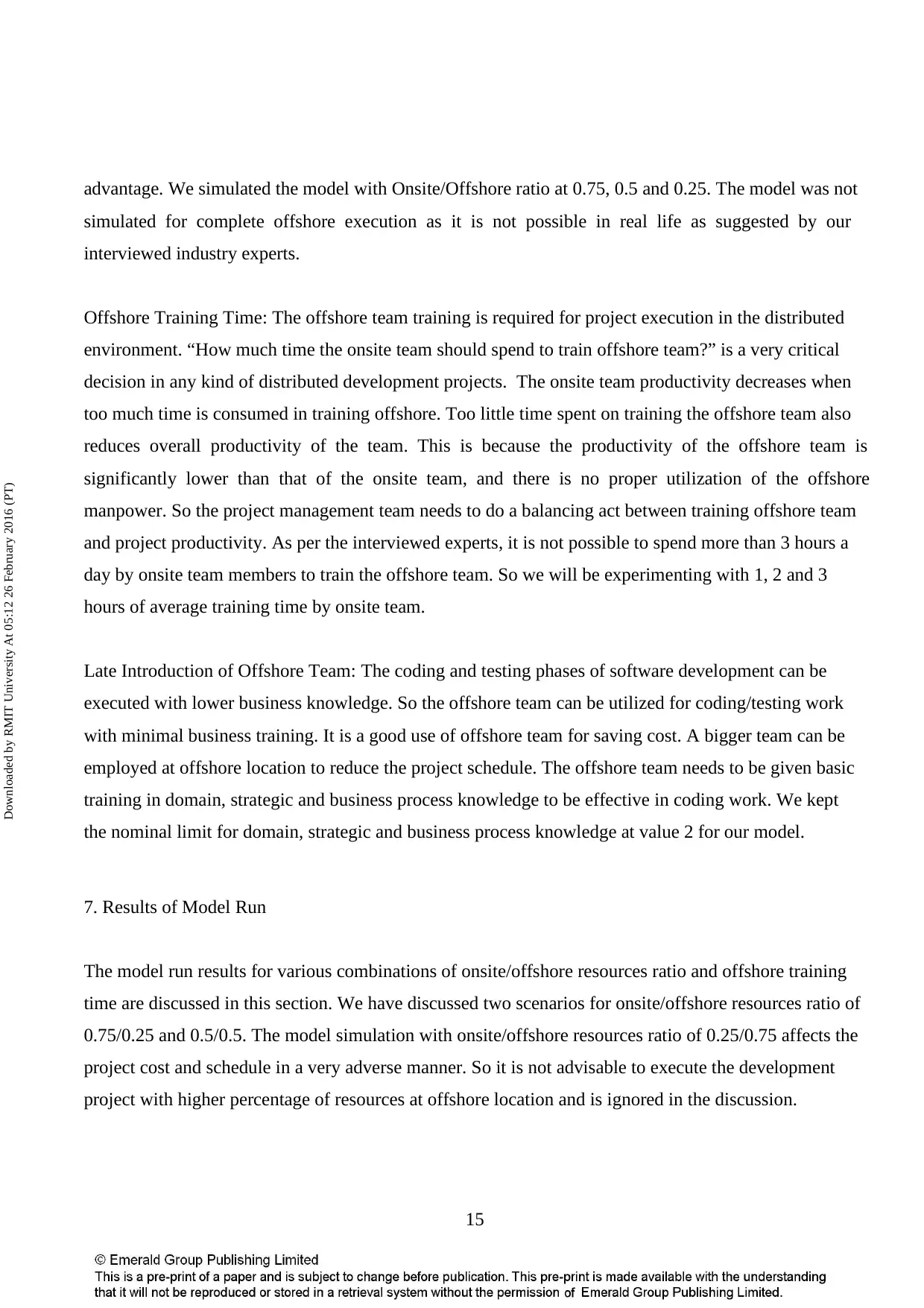
15
advantage. We simulated the model with Onsite/Offshore ratio at 0.75, 0.5 and 0.25. The model was not
simulated for complete offshore execution as it is not possible in real life as suggested by our
interviewed industry experts.
Offshore Training Time: The offshore team training is required for project execution in the distributed
environment. “How much time the onsite team should spend to train offshore team?” is a very critical
decision in any kind of distributed development projects. The onsite team productivity decreases when
too much time is consumed in training offshore. Too little time spent on training the offshore team also
reduces overall productivity of the team. This is because the productivity of the offshore team is
significantly lower than that of the onsite team, and there is no proper utilization of the offshore
manpower. So the project management team needs to do a balancing act between training offshore team
and project productivity. As per the interviewed experts, it is not possible to spend more than 3 hours a
day by onsite team members to train the offshore team. So we will be experimenting with 1, 2 and 3
hours of average training time by onsite team.
Late Introduction of Offshore Team: The coding and testing phases of software development can be
executed with lower business knowledge. So the offshore team can be utilized for coding/testing work
with minimal business training. It is a good use of offshore team for saving cost. A bigger team can be
employed at offshore location to reduce the project schedule. The offshore team needs to be given basic
training in domain, strategic and business process knowledge to be effective in coding work. We kept
the nominal limit for domain, strategic and business process knowledge at value 2 for our model.
7. Results of Model Run
The model run results for various combinations of onsite/offshore resources ratio and offshore training
time are discussed in this section. We have discussed two scenarios for onsite/offshore resources ratio of
0.75/0.25 and 0.5/0.5. The model simulation with onsite/offshore resources ratio of 0.25/0.75 affects the
project cost and schedule in a very adverse manner. So it is not advisable to execute the development
project with higher percentage of resources at offshore location and is ignored in the discussion.
Downloaded by RMIT University At 05:12 26 February 2016 (PT)
advantage. We simulated the model with Onsite/Offshore ratio at 0.75, 0.5 and 0.25. The model was not
simulated for complete offshore execution as it is not possible in real life as suggested by our
interviewed industry experts.
Offshore Training Time: The offshore team training is required for project execution in the distributed
environment. “How much time the onsite team should spend to train offshore team?” is a very critical
decision in any kind of distributed development projects. The onsite team productivity decreases when
too much time is consumed in training offshore. Too little time spent on training the offshore team also
reduces overall productivity of the team. This is because the productivity of the offshore team is
significantly lower than that of the onsite team, and there is no proper utilization of the offshore
manpower. So the project management team needs to do a balancing act between training offshore team
and project productivity. As per the interviewed experts, it is not possible to spend more than 3 hours a
day by onsite team members to train the offshore team. So we will be experimenting with 1, 2 and 3
hours of average training time by onsite team.
Late Introduction of Offshore Team: The coding and testing phases of software development can be
executed with lower business knowledge. So the offshore team can be utilized for coding/testing work
with minimal business training. It is a good use of offshore team for saving cost. A bigger team can be
employed at offshore location to reduce the project schedule. The offshore team needs to be given basic
training in domain, strategic and business process knowledge to be effective in coding work. We kept
the nominal limit for domain, strategic and business process knowledge at value 2 for our model.
7. Results of Model Run
The model run results for various combinations of onsite/offshore resources ratio and offshore training
time are discussed in this section. We have discussed two scenarios for onsite/offshore resources ratio of
0.75/0.25 and 0.5/0.5. The model simulation with onsite/offshore resources ratio of 0.25/0.75 affects the
project cost and schedule in a very adverse manner. So it is not advisable to execute the development
project with higher percentage of resources at offshore location and is ignored in the discussion.
Downloaded by RMIT University At 05:12 26 February 2016 (PT)
Secure Best Marks with AI Grader
Need help grading? Try our AI Grader for instant feedback on your assignments.
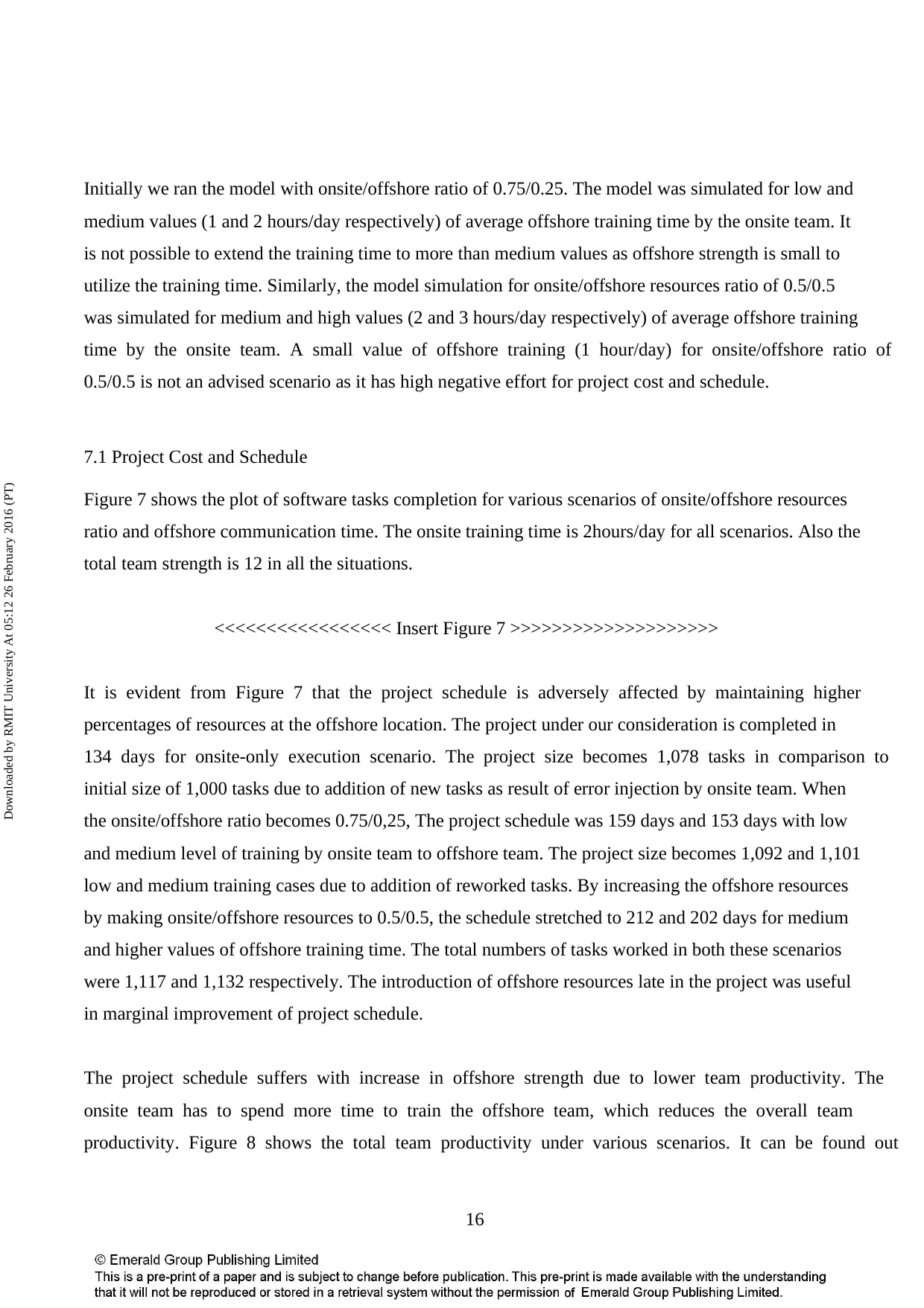
16
Initially we ran the model with onsite/offshore ratio of 0.75/0.25. The model was simulated for low and
medium values (1 and 2 hours/day respectively) of average offshore training time by the onsite team. It
is not possible to extend the training time to more than medium values as offshore strength is small to
utilize the training time. Similarly, the model simulation for onsite/offshore resources ratio of 0.5/0.5
was simulated for medium and high values (2 and 3 hours/day respectively) of average offshore training
time by the onsite team. A small value of offshore training (1 hour/day) for onsite/offshore ratio of
0.5/0.5 is not an advised scenario as it has high negative effort for project cost and schedule.
7.1 Project Cost and Schedule
Figure 7 shows the plot of software tasks completion for various scenarios of onsite/offshore resources
ratio and offshore communication time. The onsite training time is 2hours/day for all scenarios. Also the
total team strength is 12 in all the situations.
<<<<<<<<<<<<<<<<< Insert Figure 7 >>>>>>>>>>>>>>>>>>>>
It is evident from Figure 7 that the project schedule is adversely affected by maintaining higher
percentages of resources at the offshore location. The project under our consideration is completed in
134 days for onsite-only execution scenario. The project size becomes 1,078 tasks in comparison to
initial size of 1,000 tasks due to addition of new tasks as result of error injection by onsite team. When
the onsite/offshore ratio becomes 0.75/0,25, The project schedule was 159 days and 153 days with low
and medium level of training by onsite team to offshore team. The project size becomes 1,092 and 1,101
low and medium training cases due to addition of reworked tasks. By increasing the offshore resources
by making onsite/offshore resources to 0.5/0.5, the schedule stretched to 212 and 202 days for medium
and higher values of offshore training time. The total numbers of tasks worked in both these scenarios
were 1,117 and 1,132 respectively. The introduction of offshore resources late in the project was useful
in marginal improvement of project schedule.
The project schedule suffers with increase in offshore strength due to lower team productivity. The
onsite team has to spend more time to train the offshore team, which reduces the overall team
productivity. Figure 8 shows the total team productivity under various scenarios. It can be found out
Downloaded by RMIT University At 05:12 26 February 2016 (PT)
Initially we ran the model with onsite/offshore ratio of 0.75/0.25. The model was simulated for low and
medium values (1 and 2 hours/day respectively) of average offshore training time by the onsite team. It
is not possible to extend the training time to more than medium values as offshore strength is small to
utilize the training time. Similarly, the model simulation for onsite/offshore resources ratio of 0.5/0.5
was simulated for medium and high values (2 and 3 hours/day respectively) of average offshore training
time by the onsite team. A small value of offshore training (1 hour/day) for onsite/offshore ratio of
0.5/0.5 is not an advised scenario as it has high negative effort for project cost and schedule.
7.1 Project Cost and Schedule
Figure 7 shows the plot of software tasks completion for various scenarios of onsite/offshore resources
ratio and offshore communication time. The onsite training time is 2hours/day for all scenarios. Also the
total team strength is 12 in all the situations.
<<<<<<<<<<<<<<<<< Insert Figure 7 >>>>>>>>>>>>>>>>>>>>
It is evident from Figure 7 that the project schedule is adversely affected by maintaining higher
percentages of resources at the offshore location. The project under our consideration is completed in
134 days for onsite-only execution scenario. The project size becomes 1,078 tasks in comparison to
initial size of 1,000 tasks due to addition of new tasks as result of error injection by onsite team. When
the onsite/offshore ratio becomes 0.75/0,25, The project schedule was 159 days and 153 days with low
and medium level of training by onsite team to offshore team. The project size becomes 1,092 and 1,101
low and medium training cases due to addition of reworked tasks. By increasing the offshore resources
by making onsite/offshore resources to 0.5/0.5, the schedule stretched to 212 and 202 days for medium
and higher values of offshore training time. The total numbers of tasks worked in both these scenarios
were 1,117 and 1,132 respectively. The introduction of offshore resources late in the project was useful
in marginal improvement of project schedule.
The project schedule suffers with increase in offshore strength due to lower team productivity. The
onsite team has to spend more time to train the offshore team, which reduces the overall team
productivity. Figure 8 shows the total team productivity under various scenarios. It can be found out
Downloaded by RMIT University At 05:12 26 February 2016 (PT)
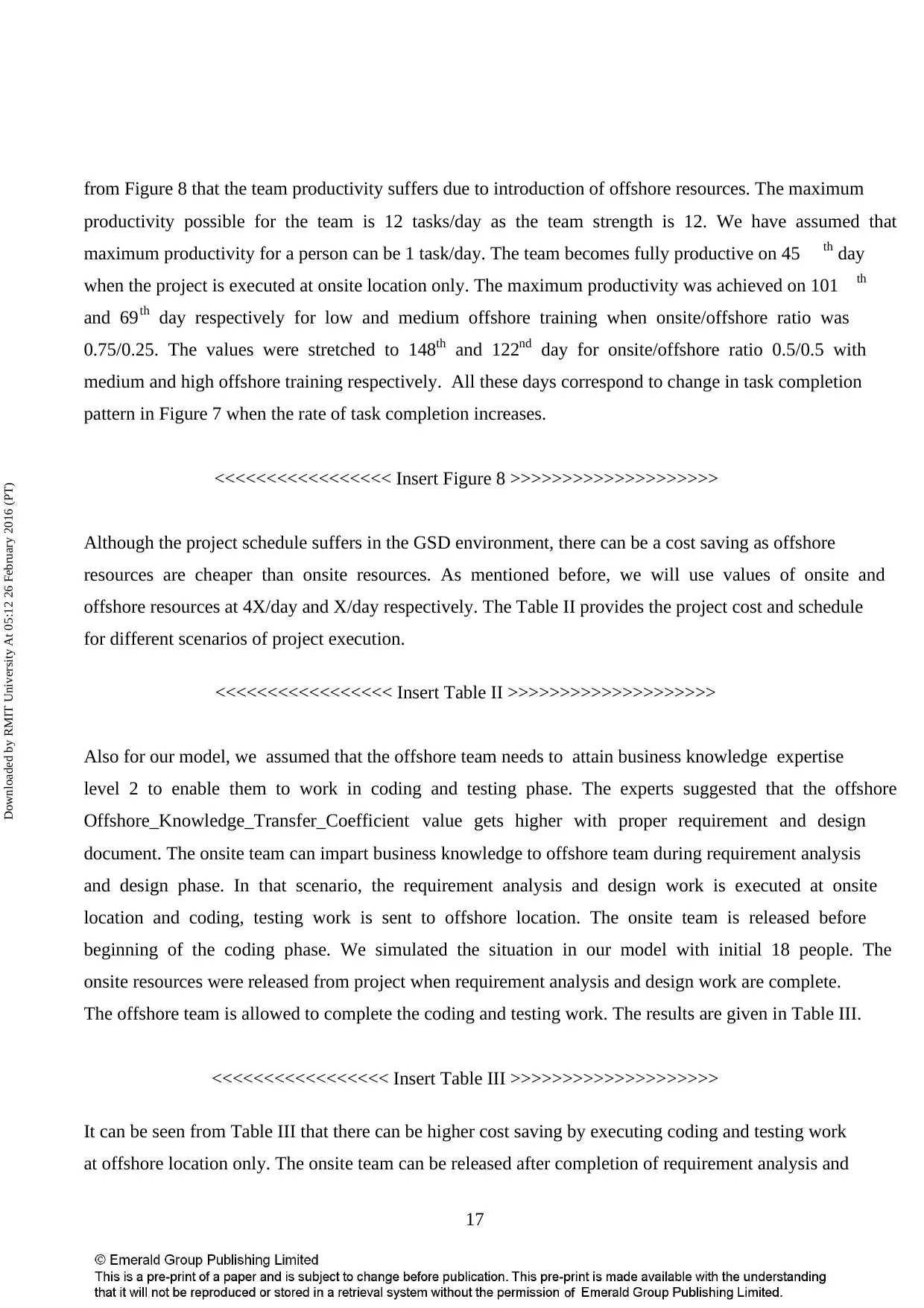
17
from Figure 8 that the team productivity suffers due to introduction of offshore resources. The maximum
productivity possible for the team is 12 tasks/day as the team strength is 12. We have assumed that
maximum productivity for a person can be 1 task/day. The team becomes fully productive on 45 th day
when the project is executed at onsite location only. The maximum productivity was achieved on 101 th
and 69th day respectively for low and medium offshore training when onsite/offshore ratio was
0.75/0.25. The values were stretched to 148th and 122nd day for onsite/offshore ratio 0.5/0.5 with
medium and high offshore training respectively. All these days correspond to change in task completion
pattern in Figure 7 when the rate of task completion increases.
<<<<<<<<<<<<<<<<< Insert Figure 8 >>>>>>>>>>>>>>>>>>>>
Although the project schedule suffers in the GSD environment, there can be a cost saving as offshore
resources are cheaper than onsite resources. As mentioned before, we will use values of onsite and
offshore resources at 4X/day and X/day respectively. The Table II provides the project cost and schedule
for different scenarios of project execution.
<<<<<<<<<<<<<<<<< Insert Table II >>>>>>>>>>>>>>>>>>>>
Also for our model, we assumed that the offshore team needs to attain business knowledge expertise
level 2 to enable them to work in coding and testing phase. The experts suggested that the offshore
Offshore_Knowledge_Transfer_Coefficient value gets higher with proper requirement and design
document. The onsite team can impart business knowledge to offshore team during requirement analysis
and design phase. In that scenario, the requirement analysis and design work is executed at onsite
location and coding, testing work is sent to offshore location. The onsite team is released before
beginning of the coding phase. We simulated the situation in our model with initial 18 people. The
onsite resources were released from project when requirement analysis and design work are complete.
The offshore team is allowed to complete the coding and testing work. The results are given in Table III.
<<<<<<<<<<<<<<<<< Insert Table III >>>>>>>>>>>>>>>>>>>>
It can be seen from Table III that there can be higher cost saving by executing coding and testing work
at offshore location only. The onsite team can be released after completion of requirement analysis and
Downloaded by RMIT University At 05:12 26 February 2016 (PT)
from Figure 8 that the team productivity suffers due to introduction of offshore resources. The maximum
productivity possible for the team is 12 tasks/day as the team strength is 12. We have assumed that
maximum productivity for a person can be 1 task/day. The team becomes fully productive on 45 th day
when the project is executed at onsite location only. The maximum productivity was achieved on 101 th
and 69th day respectively for low and medium offshore training when onsite/offshore ratio was
0.75/0.25. The values were stretched to 148th and 122nd day for onsite/offshore ratio 0.5/0.5 with
medium and high offshore training respectively. All these days correspond to change in task completion
pattern in Figure 7 when the rate of task completion increases.
<<<<<<<<<<<<<<<<< Insert Figure 8 >>>>>>>>>>>>>>>>>>>>
Although the project schedule suffers in the GSD environment, there can be a cost saving as offshore
resources are cheaper than onsite resources. As mentioned before, we will use values of onsite and
offshore resources at 4X/day and X/day respectively. The Table II provides the project cost and schedule
for different scenarios of project execution.
<<<<<<<<<<<<<<<<< Insert Table II >>>>>>>>>>>>>>>>>>>>
Also for our model, we assumed that the offshore team needs to attain business knowledge expertise
level 2 to enable them to work in coding and testing phase. The experts suggested that the offshore
Offshore_Knowledge_Transfer_Coefficient value gets higher with proper requirement and design
document. The onsite team can impart business knowledge to offshore team during requirement analysis
and design phase. In that scenario, the requirement analysis and design work is executed at onsite
location and coding, testing work is sent to offshore location. The onsite team is released before
beginning of the coding phase. We simulated the situation in our model with initial 18 people. The
onsite resources were released from project when requirement analysis and design work are complete.
The offshore team is allowed to complete the coding and testing work. The results are given in Table III.
<<<<<<<<<<<<<<<<< Insert Table III >>>>>>>>>>>>>>>>>>>>
It can be seen from Table III that there can be higher cost saving by executing coding and testing work
at offshore location only. The onsite team can be released after completion of requirement analysis and
Downloaded by RMIT University At 05:12 26 February 2016 (PT)
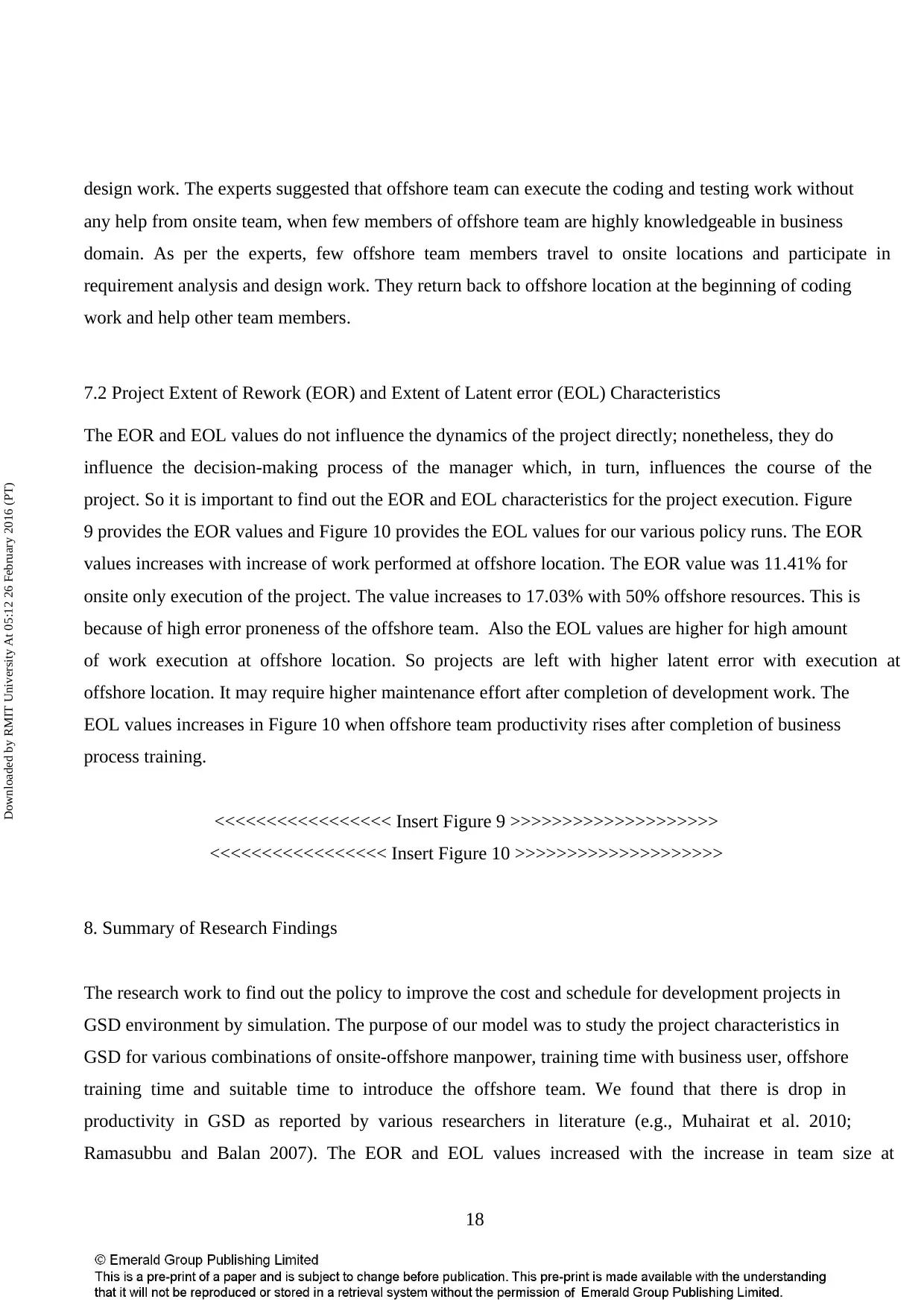
18
design work. The experts suggested that offshore team can execute the coding and testing work without
any help from onsite team, when few members of offshore team are highly knowledgeable in business
domain. As per the experts, few offshore team members travel to onsite locations and participate in
requirement analysis and design work. They return back to offshore location at the beginning of coding
work and help other team members.
7.2 Project Extent of Rework (EOR) and Extent of Latent error (EOL) Characteristics
The EOR and EOL values do not influence the dynamics of the project directly; nonetheless, they do
influence the decision-making process of the manager which, in turn, influences the course of the
project. So it is important to find out the EOR and EOL characteristics for the project execution. Figure
9 provides the EOR values and Figure 10 provides the EOL values for our various policy runs. The EOR
values increases with increase of work performed at offshore location. The EOR value was 11.41% for
onsite only execution of the project. The value increases to 17.03% with 50% offshore resources. This is
because of high error proneness of the offshore team. Also the EOL values are higher for high amount
of work execution at offshore location. So projects are left with higher latent error with execution at
offshore location. It may require higher maintenance effort after completion of development work. The
EOL values increases in Figure 10 when offshore team productivity rises after completion of business
process training.
<<<<<<<<<<<<<<<<< Insert Figure 9 >>>>>>>>>>>>>>>>>>>>
<<<<<<<<<<<<<<<<< Insert Figure 10 >>>>>>>>>>>>>>>>>>>>
8. Summary of Research Findings
The research work to find out the policy to improve the cost and schedule for development projects in
GSD environment by simulation. The purpose of our model was to study the project characteristics in
GSD for various combinations of onsite-offshore manpower, training time with business user, offshore
training time and suitable time to introduce the offshore team. We found that there is drop in
productivity in GSD as reported by various researchers in literature (e.g., Muhairat et al. 2010;
Ramasubbu and Balan 2007). The EOR and EOL values increased with the increase in team size at
Downloaded by RMIT University At 05:12 26 February 2016 (PT)
design work. The experts suggested that offshore team can execute the coding and testing work without
any help from onsite team, when few members of offshore team are highly knowledgeable in business
domain. As per the experts, few offshore team members travel to onsite locations and participate in
requirement analysis and design work. They return back to offshore location at the beginning of coding
work and help other team members.
7.2 Project Extent of Rework (EOR) and Extent of Latent error (EOL) Characteristics
The EOR and EOL values do not influence the dynamics of the project directly; nonetheless, they do
influence the decision-making process of the manager which, in turn, influences the course of the
project. So it is important to find out the EOR and EOL characteristics for the project execution. Figure
9 provides the EOR values and Figure 10 provides the EOL values for our various policy runs. The EOR
values increases with increase of work performed at offshore location. The EOR value was 11.41% for
onsite only execution of the project. The value increases to 17.03% with 50% offshore resources. This is
because of high error proneness of the offshore team. Also the EOL values are higher for high amount
of work execution at offshore location. So projects are left with higher latent error with execution at
offshore location. It may require higher maintenance effort after completion of development work. The
EOL values increases in Figure 10 when offshore team productivity rises after completion of business
process training.
<<<<<<<<<<<<<<<<< Insert Figure 9 >>>>>>>>>>>>>>>>>>>>
<<<<<<<<<<<<<<<<< Insert Figure 10 >>>>>>>>>>>>>>>>>>>>
8. Summary of Research Findings
The research work to find out the policy to improve the cost and schedule for development projects in
GSD environment by simulation. The purpose of our model was to study the project characteristics in
GSD for various combinations of onsite-offshore manpower, training time with business user, offshore
training time and suitable time to introduce the offshore team. We found that there is drop in
productivity in GSD as reported by various researchers in literature (e.g., Muhairat et al. 2010;
Ramasubbu and Balan 2007). The EOR and EOL values increased with the increase in team size at
Downloaded by RMIT University At 05:12 26 February 2016 (PT)
Paraphrase This Document
Need a fresh take? Get an instant paraphrase of this document with our AI Paraphraser
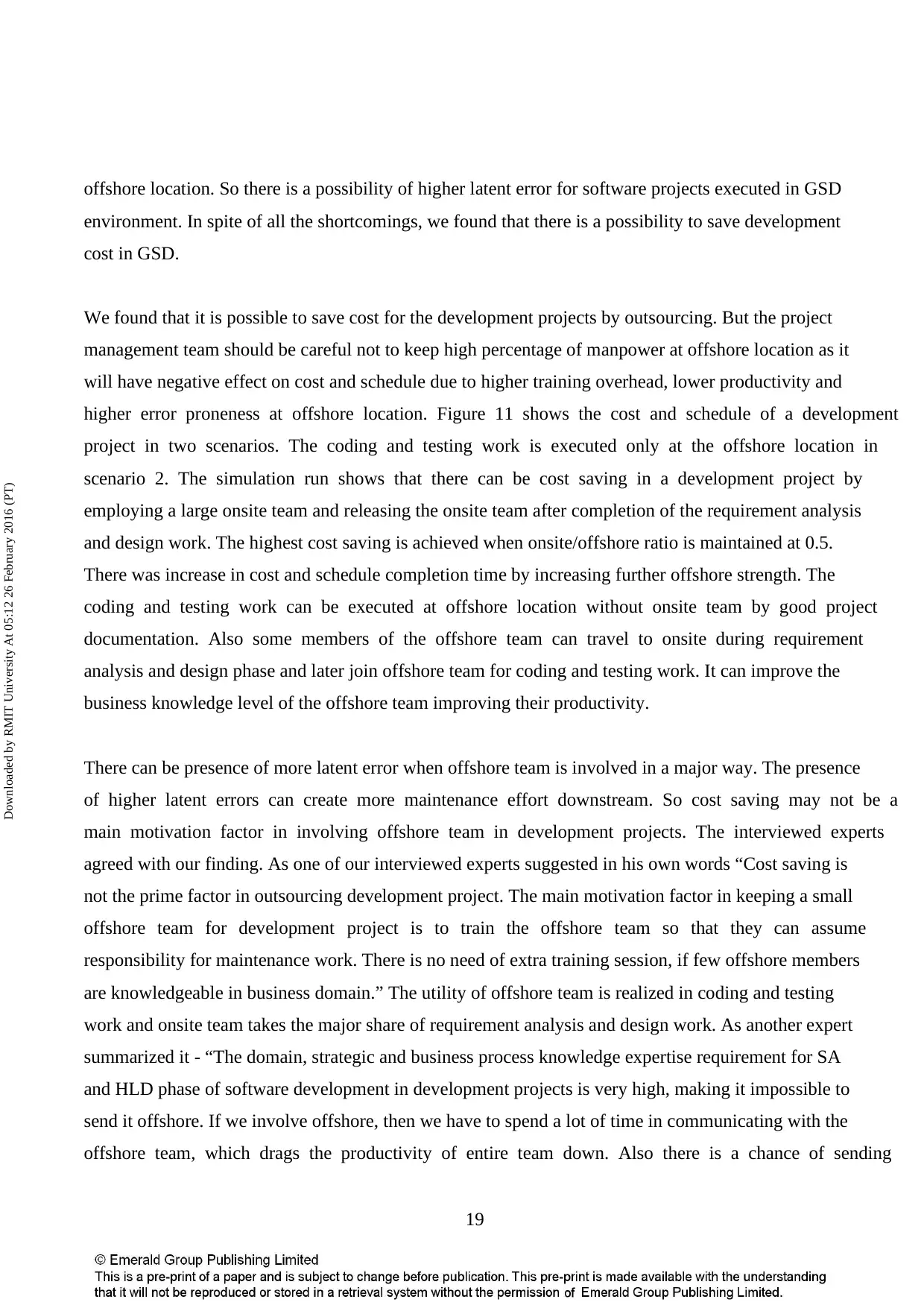
19
offshore location. So there is a possibility of higher latent error for software projects executed in GSD
environment. In spite of all the shortcomings, we found that there is a possibility to save development
cost in GSD.
We found that it is possible to save cost for the development projects by outsourcing. But the project
management team should be careful not to keep high percentage of manpower at offshore location as it
will have negative effect on cost and schedule due to higher training overhead, lower productivity and
higher error proneness at offshore location. Figure 11 shows the cost and schedule of a development
project in two scenarios. The coding and testing work is executed only at the offshore location in
scenario 2. The simulation run shows that there can be cost saving in a development project by
employing a large onsite team and releasing the onsite team after completion of the requirement analysis
and design work. The highest cost saving is achieved when onsite/offshore ratio is maintained at 0.5.
There was increase in cost and schedule completion time by increasing further offshore strength. The
coding and testing work can be executed at offshore location without onsite team by good project
documentation. Also some members of the offshore team can travel to onsite during requirement
analysis and design phase and later join offshore team for coding and testing work. It can improve the
business knowledge level of the offshore team improving their productivity.
There can be presence of more latent error when offshore team is involved in a major way. The presence
of higher latent errors can create more maintenance effort downstream. So cost saving may not be a
main motivation factor in involving offshore team in development projects. The interviewed experts
agreed with our finding. As one of our interviewed experts suggested in his own words “Cost saving is
not the prime factor in outsourcing development project. The main motivation factor in keeping a small
offshore team for development project is to train the offshore team so that they can assume
responsibility for maintenance work. There is no need of extra training session, if few offshore members
are knowledgeable in business domain.” The utility of offshore team is realized in coding and testing
work and onsite team takes the major share of requirement analysis and design work. As another expert
summarized it - “The domain, strategic and business process knowledge expertise requirement for SA
and HLD phase of software development in development projects is very high, making it impossible to
send it offshore. If we involve offshore, then we have to spend a lot of time in communicating with the
offshore team, which drags the productivity of entire team down. Also there is a chance of sending
Downloaded by RMIT University At 05:12 26 February 2016 (PT)
offshore location. So there is a possibility of higher latent error for software projects executed in GSD
environment. In spite of all the shortcomings, we found that there is a possibility to save development
cost in GSD.
We found that it is possible to save cost for the development projects by outsourcing. But the project
management team should be careful not to keep high percentage of manpower at offshore location as it
will have negative effect on cost and schedule due to higher training overhead, lower productivity and
higher error proneness at offshore location. Figure 11 shows the cost and schedule of a development
project in two scenarios. The coding and testing work is executed only at the offshore location in
scenario 2. The simulation run shows that there can be cost saving in a development project by
employing a large onsite team and releasing the onsite team after completion of the requirement analysis
and design work. The highest cost saving is achieved when onsite/offshore ratio is maintained at 0.5.
There was increase in cost and schedule completion time by increasing further offshore strength. The
coding and testing work can be executed at offshore location without onsite team by good project
documentation. Also some members of the offshore team can travel to onsite during requirement
analysis and design phase and later join offshore team for coding and testing work. It can improve the
business knowledge level of the offshore team improving their productivity.
There can be presence of more latent error when offshore team is involved in a major way. The presence
of higher latent errors can create more maintenance effort downstream. So cost saving may not be a
main motivation factor in involving offshore team in development projects. The interviewed experts
agreed with our finding. As one of our interviewed experts suggested in his own words “Cost saving is
not the prime factor in outsourcing development project. The main motivation factor in keeping a small
offshore team for development project is to train the offshore team so that they can assume
responsibility for maintenance work. There is no need of extra training session, if few offshore members
are knowledgeable in business domain.” The utility of offshore team is realized in coding and testing
work and onsite team takes the major share of requirement analysis and design work. As another expert
summarized it - “The domain, strategic and business process knowledge expertise requirement for SA
and HLD phase of software development in development projects is very high, making it impossible to
send it offshore. If we involve offshore, then we have to spend a lot of time in communicating with the
offshore team, which drags the productivity of entire team down. Also there is a chance of sending
Downloaded by RMIT University At 05:12 26 February 2016 (PT)
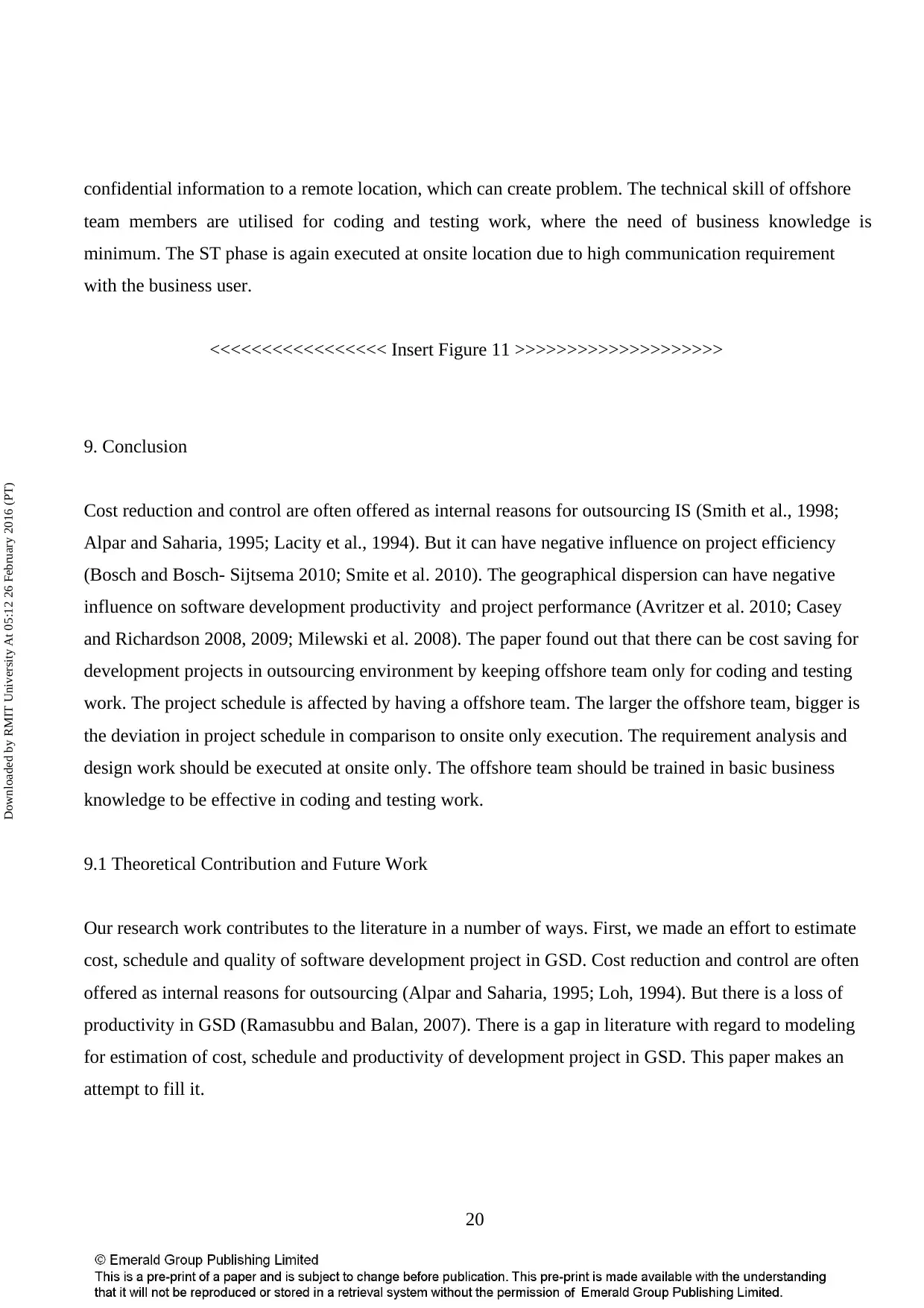
20
confidential information to a remote location, which can create problem. The technical skill of offshore
team members are utilised for coding and testing work, where the need of business knowledge is
minimum. The ST phase is again executed at onsite location due to high communication requirement
with the business user.
<<<<<<<<<<<<<<<<< Insert Figure 11 >>>>>>>>>>>>>>>>>>>>
9. Conclusion
Cost reduction and control are often offered as internal reasons for outsourcing IS (Smith et al., 1998;
Alpar and Saharia, 1995; Lacity et al., 1994). But it can have negative influence on project efficiency
(Bosch and Bosch- Sijtsema 2010; Smite et al. 2010). The geographical dispersion can have negative
influence on software development productivity and project performance (Avritzer et al. 2010; Casey
and Richardson 2008, 2009; Milewski et al. 2008). The paper found out that there can be cost saving for
development projects in outsourcing environment by keeping offshore team only for coding and testing
work. The project schedule is affected by having a offshore team. The larger the offshore team, bigger is
the deviation in project schedule in comparison to onsite only execution. The requirement analysis and
design work should be executed at onsite only. The offshore team should be trained in basic business
knowledge to be effective in coding and testing work.
9.1 Theoretical Contribution and Future Work
Our research work contributes to the literature in a number of ways. First, we made an effort to estimate
cost, schedule and quality of software development project in GSD. Cost reduction and control are often
offered as internal reasons for outsourcing (Alpar and Saharia, 1995; Loh, 1994). But there is a loss of
productivity in GSD (Ramasubbu and Balan, 2007). There is a gap in literature with regard to modeling
for estimation of cost, schedule and productivity of development project in GSD. This paper makes an
attempt to fill it.
Downloaded by RMIT University At 05:12 26 February 2016 (PT)
confidential information to a remote location, which can create problem. The technical skill of offshore
team members are utilised for coding and testing work, where the need of business knowledge is
minimum. The ST phase is again executed at onsite location due to high communication requirement
with the business user.
<<<<<<<<<<<<<<<<< Insert Figure 11 >>>>>>>>>>>>>>>>>>>>
9. Conclusion
Cost reduction and control are often offered as internal reasons for outsourcing IS (Smith et al., 1998;
Alpar and Saharia, 1995; Lacity et al., 1994). But it can have negative influence on project efficiency
(Bosch and Bosch- Sijtsema 2010; Smite et al. 2010). The geographical dispersion can have negative
influence on software development productivity and project performance (Avritzer et al. 2010; Casey
and Richardson 2008, 2009; Milewski et al. 2008). The paper found out that there can be cost saving for
development projects in outsourcing environment by keeping offshore team only for coding and testing
work. The project schedule is affected by having a offshore team. The larger the offshore team, bigger is
the deviation in project schedule in comparison to onsite only execution. The requirement analysis and
design work should be executed at onsite only. The offshore team should be trained in basic business
knowledge to be effective in coding and testing work.
9.1 Theoretical Contribution and Future Work
Our research work contributes to the literature in a number of ways. First, we made an effort to estimate
cost, schedule and quality of software development project in GSD. Cost reduction and control are often
offered as internal reasons for outsourcing (Alpar and Saharia, 1995; Loh, 1994). But there is a loss of
productivity in GSD (Ramasubbu and Balan, 2007). There is a gap in literature with regard to modeling
for estimation of cost, schedule and productivity of development project in GSD. This paper makes an
attempt to fill it.
Downloaded by RMIT University At 05:12 26 February 2016 (PT)
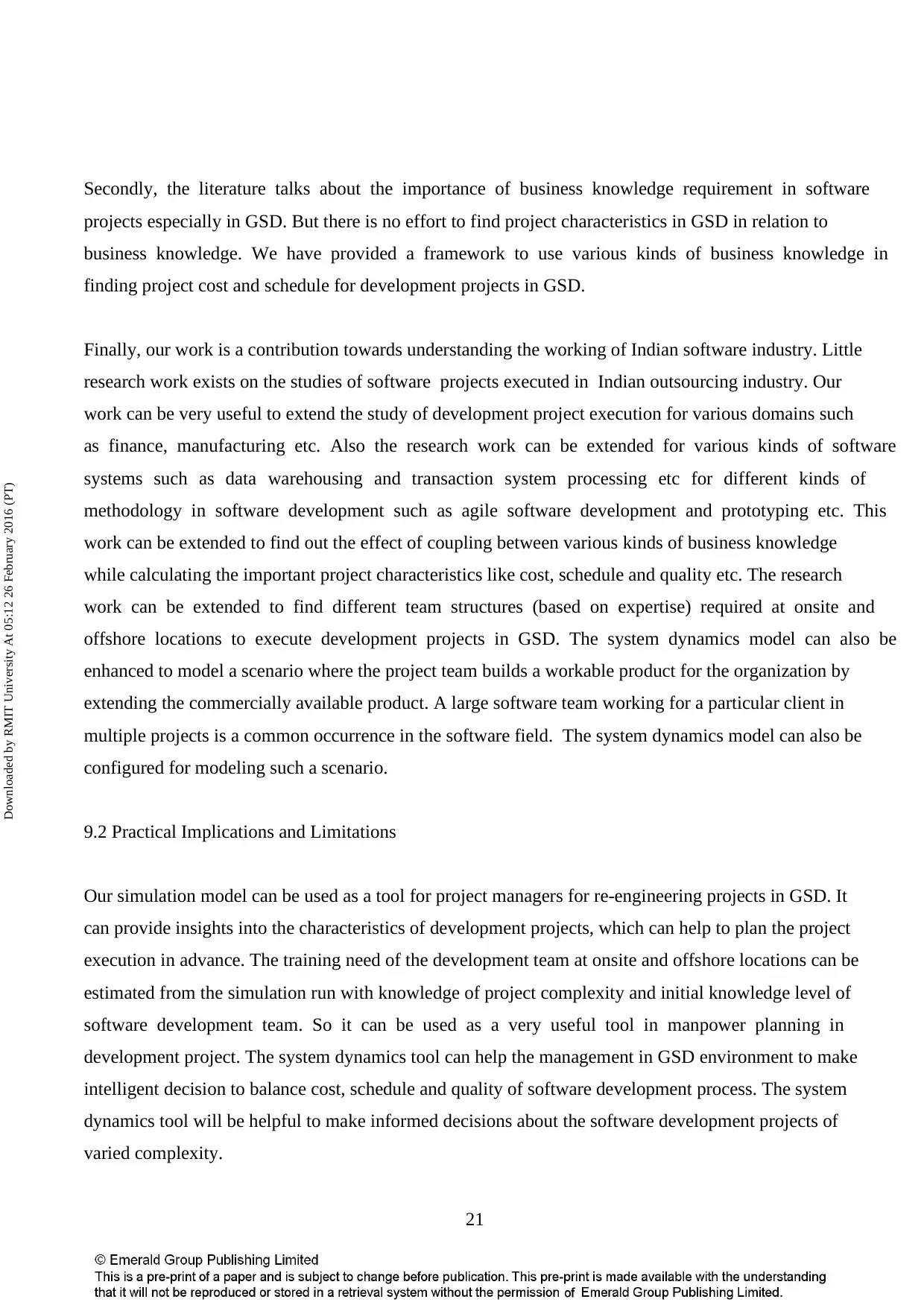
21
Secondly, the literature talks about the importance of business knowledge requirement in software
projects especially in GSD. But there is no effort to find project characteristics in GSD in relation to
business knowledge. We have provided a framework to use various kinds of business knowledge in
finding project cost and schedule for development projects in GSD.
Finally, our work is a contribution towards understanding the working of Indian software industry. Little
research work exists on the studies of software projects executed in Indian outsourcing industry. Our
work can be very useful to extend the study of development project execution for various domains such
as finance, manufacturing etc. Also the research work can be extended for various kinds of software
systems such as data warehousing and transaction system processing etc for different kinds of
methodology in software development such as agile software development and prototyping etc. This
work can be extended to find out the effect of coupling between various kinds of business knowledge
while calculating the important project characteristics like cost, schedule and quality etc. The research
work can be extended to find different team structures (based on expertise) required at onsite and
offshore locations to execute development projects in GSD. The system dynamics model can also be
enhanced to model a scenario where the project team builds a workable product for the organization by
extending the commercially available product. A large software team working for a particular client in
multiple projects is a common occurrence in the software field. The system dynamics model can also be
configured for modeling such a scenario.
9.2 Practical Implications and Limitations
Our simulation model can be used as a tool for project managers for re-engineering projects in GSD. It
can provide insights into the characteristics of development projects, which can help to plan the project
execution in advance. The training need of the development team at onsite and offshore locations can be
estimated from the simulation run with knowledge of project complexity and initial knowledge level of
software development team. So it can be used as a very useful tool in manpower planning in
development project. The system dynamics tool can help the management in GSD environment to make
intelligent decision to balance cost, schedule and quality of software development process. The system
dynamics tool will be helpful to make informed decisions about the software development projects of
varied complexity.
Downloaded by RMIT University At 05:12 26 February 2016 (PT)
Secondly, the literature talks about the importance of business knowledge requirement in software
projects especially in GSD. But there is no effort to find project characteristics in GSD in relation to
business knowledge. We have provided a framework to use various kinds of business knowledge in
finding project cost and schedule for development projects in GSD.
Finally, our work is a contribution towards understanding the working of Indian software industry. Little
research work exists on the studies of software projects executed in Indian outsourcing industry. Our
work can be very useful to extend the study of development project execution for various domains such
as finance, manufacturing etc. Also the research work can be extended for various kinds of software
systems such as data warehousing and transaction system processing etc for different kinds of
methodology in software development such as agile software development and prototyping etc. This
work can be extended to find out the effect of coupling between various kinds of business knowledge
while calculating the important project characteristics like cost, schedule and quality etc. The research
work can be extended to find different team structures (based on expertise) required at onsite and
offshore locations to execute development projects in GSD. The system dynamics model can also be
enhanced to model a scenario where the project team builds a workable product for the organization by
extending the commercially available product. A large software team working for a particular client in
multiple projects is a common occurrence in the software field. The system dynamics model can also be
configured for modeling such a scenario.
9.2 Practical Implications and Limitations
Our simulation model can be used as a tool for project managers for re-engineering projects in GSD. It
can provide insights into the characteristics of development projects, which can help to plan the project
execution in advance. The training need of the development team at onsite and offshore locations can be
estimated from the simulation run with knowledge of project complexity and initial knowledge level of
software development team. So it can be used as a very useful tool in manpower planning in
development project. The system dynamics tool can help the management in GSD environment to make
intelligent decision to balance cost, schedule and quality of software development process. The system
dynamics tool will be helpful to make informed decisions about the software development projects of
varied complexity.
Downloaded by RMIT University At 05:12 26 February 2016 (PT)
Secure Best Marks with AI Grader
Need help grading? Try our AI Grader for instant feedback on your assignments.
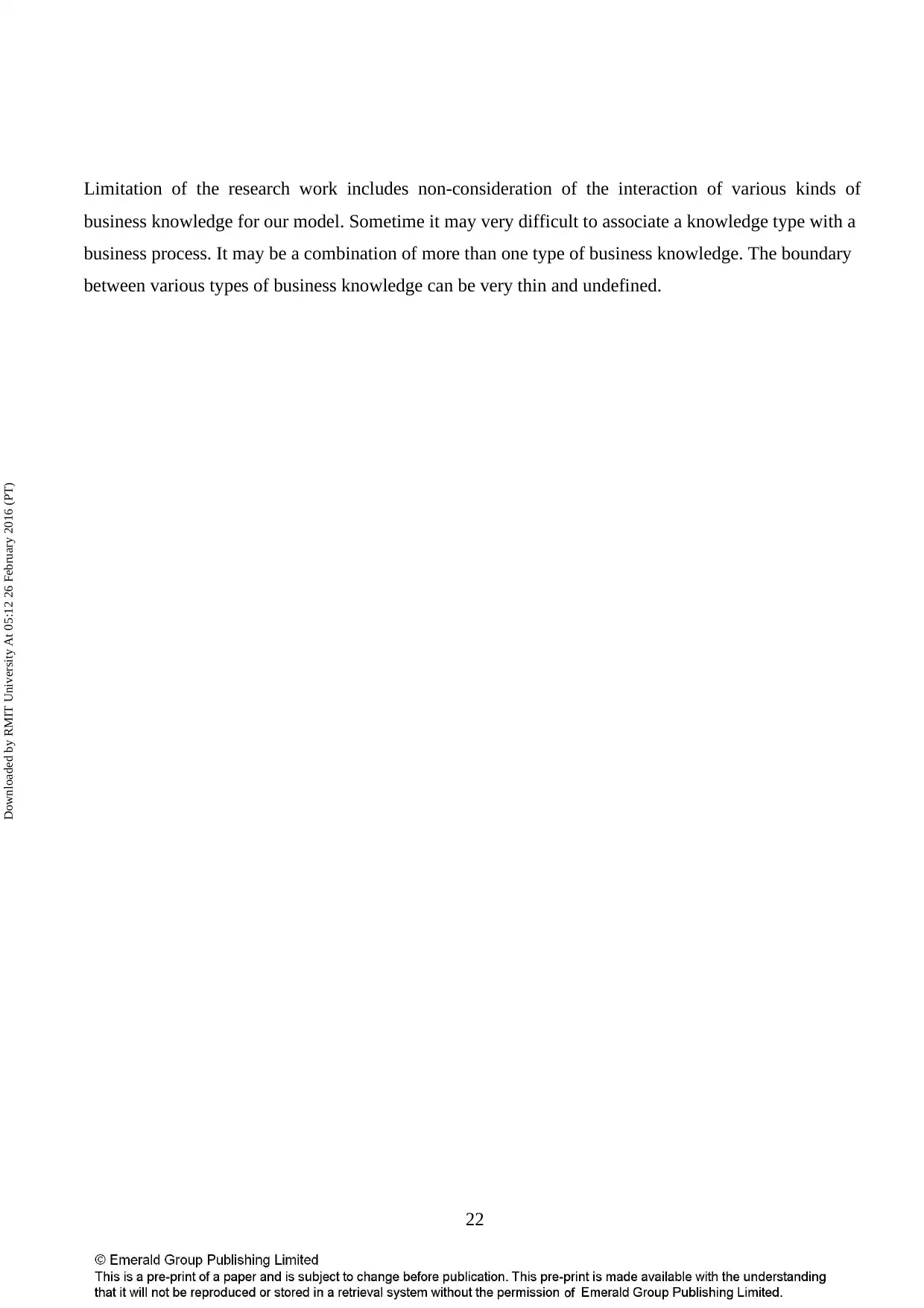
22
Limitation of the research work includes non-consideration of the interaction of various kinds of
business knowledge for our model. Sometime it may very difficult to associate a knowledge type with a
business process. It may be a combination of more than one type of business knowledge. The boundary
between various types of business knowledge can be very thin and undefined.
Downloaded by RMIT University At 05:12 26 February 2016 (PT)
Limitation of the research work includes non-consideration of the interaction of various kinds of
business knowledge for our model. Sometime it may very difficult to associate a knowledge type with a
business process. It may be a combination of more than one type of business knowledge. The boundary
between various types of business knowledge can be very thin and undefined.
Downloaded by RMIT University At 05:12 26 February 2016 (PT)
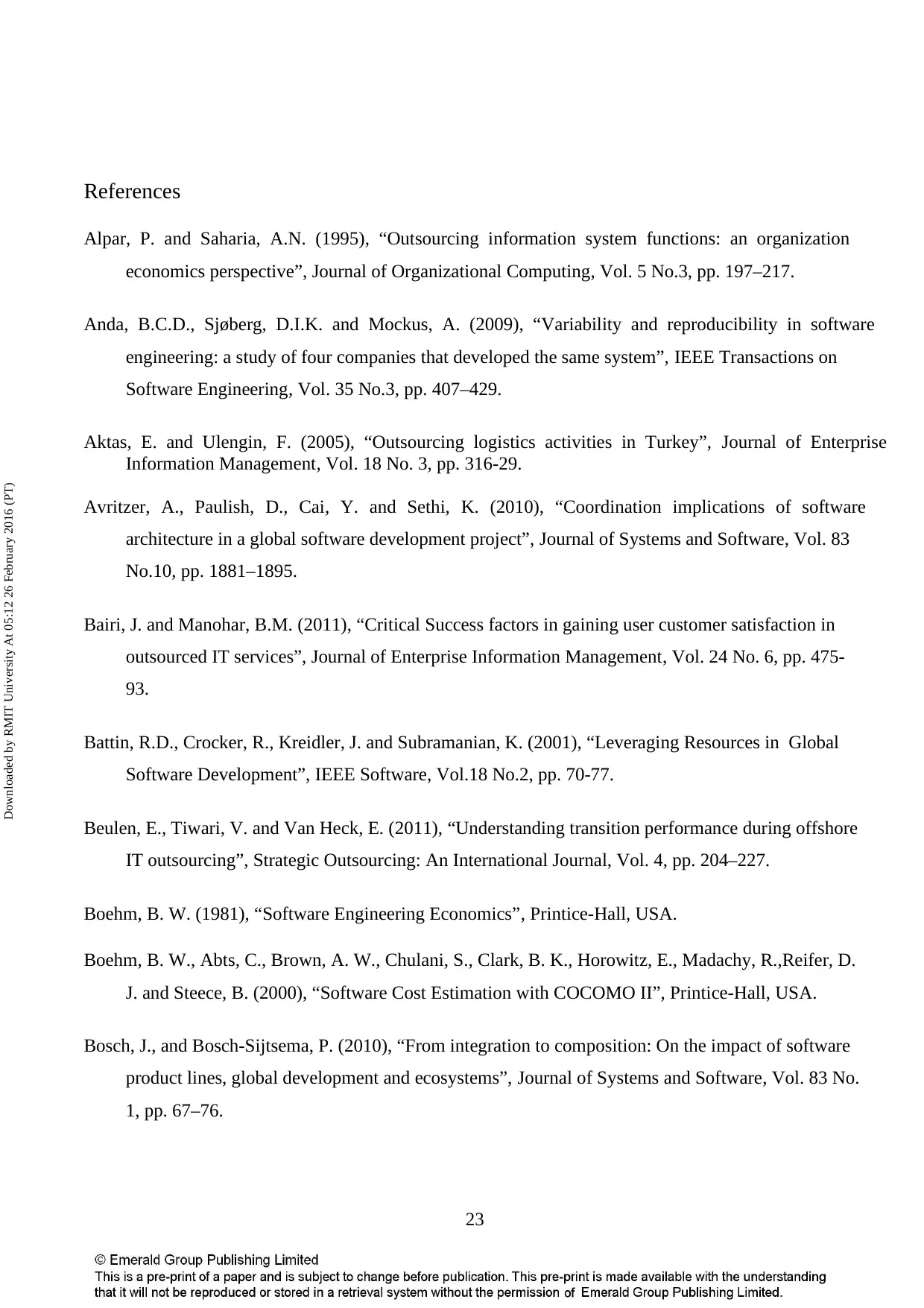
23
References
Alpar, P. and Saharia, A.N. (1995), “Outsourcing information system functions: an organization
economics perspective”, Journal of Organizational Computing, Vol. 5 No.3, pp. 197–217.
Anda, B.C.D., Sjøberg, D.I.K. and Mockus, A. (2009), “Variability and reproducibility in software
engineering: a study of four companies that developed the same system”, IEEE Transactions on
Software Engineering, Vol. 35 No.3, pp. 407–429.
Aktas, E. and Ulengin, F. (2005), “Outsourcing logistics activities in Turkey”, Journal of Enterprise
Information Management, Vol. 18 No. 3, pp. 316-29.
Avritzer, A., Paulish, D., Cai, Y. and Sethi, K. (2010), “Coordination implications of software
architecture in a global software development project”, Journal of Systems and Software, Vol. 83
No.10, pp. 1881–1895.
Bairi, J. and Manohar, B.M. (2011), “Critical Success factors in gaining user customer satisfaction in
outsourced IT services”, Journal of Enterprise Information Management, Vol. 24 No. 6, pp. 475-
93.
Battin, R.D., Crocker, R., Kreidler, J. and Subramanian, K. (2001), “Leveraging Resources in Global
Software Development”, IEEE Software, Vol.18 No.2, pp. 70-77.
Beulen, E., Tiwari, V. and Van Heck, E. (2011), “Understanding transition performance during offshore
IT outsourcing”, Strategic Outsourcing: An International Journal, Vol. 4, pp. 204–227.
Boehm, B. W. (1981), “Software Engineering Economics”, Printice-Hall, USA.
Boehm, B. W., Abts, C., Brown, A. W., Chulani, S., Clark, B. K., Horowitz, E., Madachy, R.,Reifer, D.
J. and Steece, B. (2000), “Software Cost Estimation with COCOMO II”, Printice-Hall, USA.
Bosch, J., and Bosch-Sijtsema, P. (2010), “From integration to composition: On the impact of software
product lines, global development and ecosystems”, Journal of Systems and Software, Vol. 83 No.
1, pp. 67–76.
Downloaded by RMIT University At 05:12 26 February 2016 (PT)
References
Alpar, P. and Saharia, A.N. (1995), “Outsourcing information system functions: an organization
economics perspective”, Journal of Organizational Computing, Vol. 5 No.3, pp. 197–217.
Anda, B.C.D., Sjøberg, D.I.K. and Mockus, A. (2009), “Variability and reproducibility in software
engineering: a study of four companies that developed the same system”, IEEE Transactions on
Software Engineering, Vol. 35 No.3, pp. 407–429.
Aktas, E. and Ulengin, F. (2005), “Outsourcing logistics activities in Turkey”, Journal of Enterprise
Information Management, Vol. 18 No. 3, pp. 316-29.
Avritzer, A., Paulish, D., Cai, Y. and Sethi, K. (2010), “Coordination implications of software
architecture in a global software development project”, Journal of Systems and Software, Vol. 83
No.10, pp. 1881–1895.
Bairi, J. and Manohar, B.M. (2011), “Critical Success factors in gaining user customer satisfaction in
outsourced IT services”, Journal of Enterprise Information Management, Vol. 24 No. 6, pp. 475-
93.
Battin, R.D., Crocker, R., Kreidler, J. and Subramanian, K. (2001), “Leveraging Resources in Global
Software Development”, IEEE Software, Vol.18 No.2, pp. 70-77.
Beulen, E., Tiwari, V. and Van Heck, E. (2011), “Understanding transition performance during offshore
IT outsourcing”, Strategic Outsourcing: An International Journal, Vol. 4, pp. 204–227.
Boehm, B. W. (1981), “Software Engineering Economics”, Printice-Hall, USA.
Boehm, B. W., Abts, C., Brown, A. W., Chulani, S., Clark, B. K., Horowitz, E., Madachy, R.,Reifer, D.
J. and Steece, B. (2000), “Software Cost Estimation with COCOMO II”, Printice-Hall, USA.
Bosch, J., and Bosch-Sijtsema, P. (2010), “From integration to composition: On the impact of software
product lines, global development and ecosystems”, Journal of Systems and Software, Vol. 83 No.
1, pp. 67–76.
Downloaded by RMIT University At 05:12 26 February 2016 (PT)
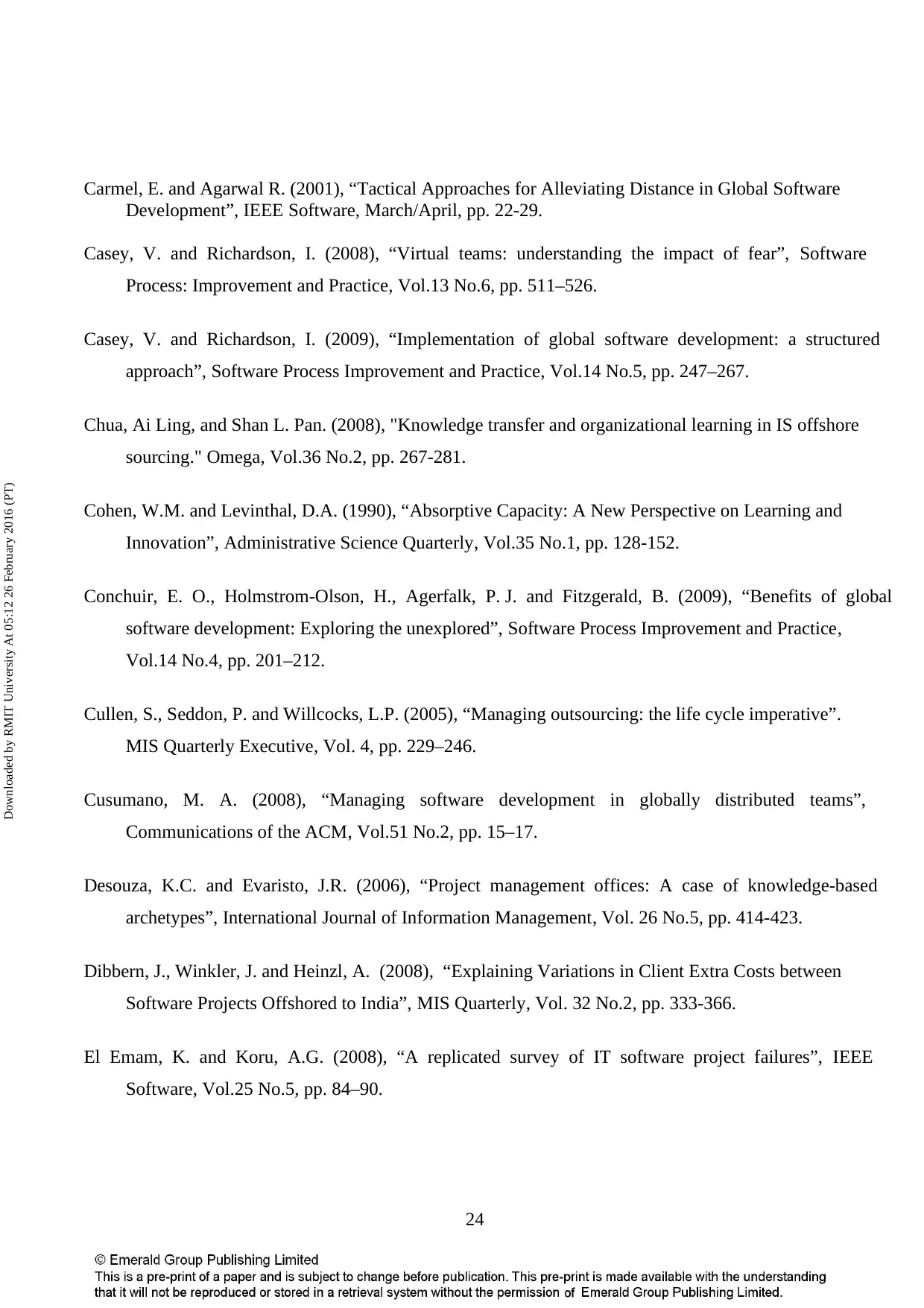
24
Carmel, E. and Agarwal R. (2001), “Tactical Approaches for Alleviating Distance in Global Software
Development”, IEEE Software, March/April, pp. 22-29.
Casey, V. and Richardson, I. (2008), “Virtual teams: understanding the impact of fear”, Software
Process: Improvement and Practice, Vol.13 No.6, pp. 511–526.
Casey, V. and Richardson, I. (2009), “Implementation of global software development: a structured
approach”, Software Process Improvement and Practice, Vol.14 No.5, pp. 247–267.
Chua, Ai Ling, and Shan L. Pan. (2008), "Knowledge transfer and organizational learning in IS offshore
sourcing." Omega, Vol.36 No.2, pp. 267-281.
Cohen, W.M. and Levinthal, D.A. (1990), “Absorptive Capacity: A New Perspective on Learning and
Innovation”, Administrative Science Quarterly, Vol.35 No.1, pp. 128-152.
Conchuir, E. O., Holmstrom-Olson, H., Agerfalk, P. J. and Fitzgerald, B. (2009), “Benefits of global
software development: Exploring the unexplored”, Software Process Improvement and Practice,
Vol.14 No.4, pp. 201–212.
Cullen, S., Seddon, P. and Willcocks, L.P. (2005), “Managing outsourcing: the life cycle imperative”.
MIS Quarterly Executive, Vol. 4, pp. 229–246.
Cusumano, M. A. (2008), “Managing software development in globally distributed teams”,
Communications of the ACM, Vol.51 No.2, pp. 15–17.
Desouza, K.C. and Evaristo, J.R. (2006), “Project management offices: A case of knowledge-based
archetypes”, International Journal of Information Management, Vol. 26 No.5, pp. 414-423.
Dibbern, J., Winkler, J. and Heinzl, A. (2008), “Explaining Variations in Client Extra Costs between
Software Projects Offshored to India”, MIS Quarterly, Vol. 32 No.2, pp. 333-366.
El Emam, K. and Koru, A.G. (2008), “A replicated survey of IT software project failures”, IEEE
Software, Vol.25 No.5, pp. 84–90.
Downloaded by RMIT University At 05:12 26 February 2016 (PT)
Carmel, E. and Agarwal R. (2001), “Tactical Approaches for Alleviating Distance in Global Software
Development”, IEEE Software, March/April, pp. 22-29.
Casey, V. and Richardson, I. (2008), “Virtual teams: understanding the impact of fear”, Software
Process: Improvement and Practice, Vol.13 No.6, pp. 511–526.
Casey, V. and Richardson, I. (2009), “Implementation of global software development: a structured
approach”, Software Process Improvement and Practice, Vol.14 No.5, pp. 247–267.
Chua, Ai Ling, and Shan L. Pan. (2008), "Knowledge transfer and organizational learning in IS offshore
sourcing." Omega, Vol.36 No.2, pp. 267-281.
Cohen, W.M. and Levinthal, D.A. (1990), “Absorptive Capacity: A New Perspective on Learning and
Innovation”, Administrative Science Quarterly, Vol.35 No.1, pp. 128-152.
Conchuir, E. O., Holmstrom-Olson, H., Agerfalk, P. J. and Fitzgerald, B. (2009), “Benefits of global
software development: Exploring the unexplored”, Software Process Improvement and Practice,
Vol.14 No.4, pp. 201–212.
Cullen, S., Seddon, P. and Willcocks, L.P. (2005), “Managing outsourcing: the life cycle imperative”.
MIS Quarterly Executive, Vol. 4, pp. 229–246.
Cusumano, M. A. (2008), “Managing software development in globally distributed teams”,
Communications of the ACM, Vol.51 No.2, pp. 15–17.
Desouza, K.C. and Evaristo, J.R. (2006), “Project management offices: A case of knowledge-based
archetypes”, International Journal of Information Management, Vol. 26 No.5, pp. 414-423.
Dibbern, J., Winkler, J. and Heinzl, A. (2008), “Explaining Variations in Client Extra Costs between
Software Projects Offshored to India”, MIS Quarterly, Vol. 32 No.2, pp. 333-366.
El Emam, K. and Koru, A.G. (2008), “A replicated survey of IT software project failures”, IEEE
Software, Vol.25 No.5, pp. 84–90.
Downloaded by RMIT University At 05:12 26 February 2016 (PT)
Paraphrase This Document
Need a fresh take? Get an instant paraphrase of this document with our AI Paraphraser
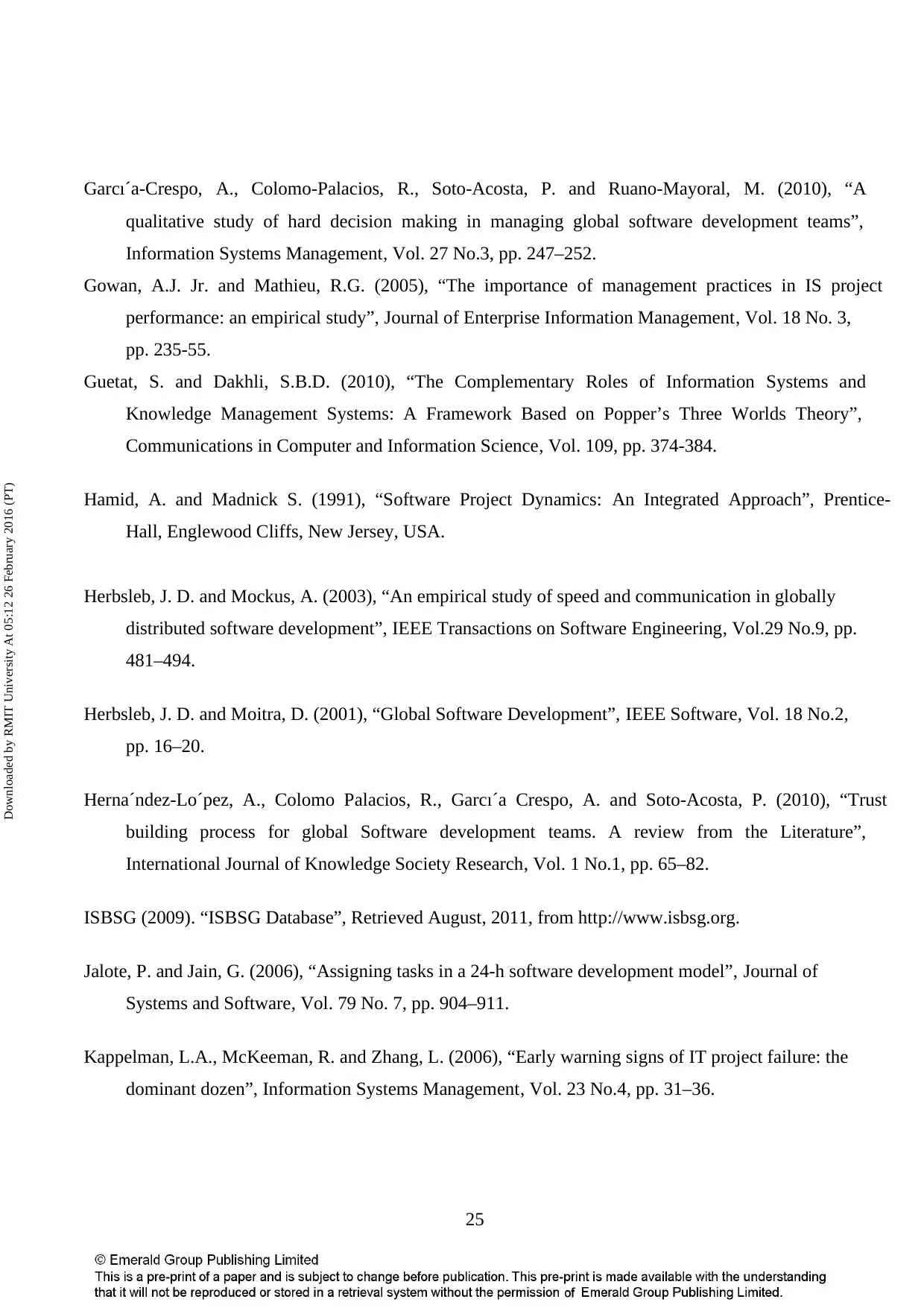
25
Garcı´a-Crespo, A., Colomo-Palacios, R., Soto-Acosta, P. and Ruano-Mayoral, M. (2010), “A
qualitative study of hard decision making in managing global software development teams”,
Information Systems Management, Vol. 27 No.3, pp. 247–252.
Gowan, A.J. Jr. and Mathieu, R.G. (2005), “The importance of management practices in IS project
performance: an empirical study”, Journal of Enterprise Information Management, Vol. 18 No. 3,
pp. 235-55.
Guetat, S. and Dakhli, S.B.D. (2010), “The Complementary Roles of Information Systems and
Knowledge Management Systems: A Framework Based on Popper’s Three Worlds Theory”,
Communications in Computer and Information Science, Vol. 109, pp. 374-384.
Hamid, A. and Madnick S. (1991), “Software Project Dynamics: An Integrated Approach”, Prentice-
Hall, Englewood Cliffs, New Jersey, USA.
Herbsleb, J. D. and Mockus, A. (2003), “An empirical study of speed and communication in globally
distributed software development”, IEEE Transactions on Software Engineering, Vol.29 No.9, pp.
481–494.
Herbsleb, J. D. and Moitra, D. (2001), “Global Software Development”, IEEE Software, Vol. 18 No.2,
pp. 16–20.
Herna´ndez-Lo´pez, A., Colomo Palacios, R., Garcı´a Crespo, A. and Soto-Acosta, P. (2010), “Trust
building process for global Software development teams. A review from the Literature”,
International Journal of Knowledge Society Research, Vol. 1 No.1, pp. 65–82.
ISBSG (2009). “ISBSG Database”, Retrieved August, 2011, from http://www.isbsg.org.
Jalote, P. and Jain, G. (2006), “Assigning tasks in a 24-h software development model”, Journal of
Systems and Software, Vol. 79 No. 7, pp. 904–911.
Kappelman, L.A., McKeeman, R. and Zhang, L. (2006), “Early warning signs of IT project failure: the
dominant dozen”, Information Systems Management, Vol. 23 No.4, pp. 31–36.
Downloaded by RMIT University At 05:12 26 February 2016 (PT)
Garcı´a-Crespo, A., Colomo-Palacios, R., Soto-Acosta, P. and Ruano-Mayoral, M. (2010), “A
qualitative study of hard decision making in managing global software development teams”,
Information Systems Management, Vol. 27 No.3, pp. 247–252.
Gowan, A.J. Jr. and Mathieu, R.G. (2005), “The importance of management practices in IS project
performance: an empirical study”, Journal of Enterprise Information Management, Vol. 18 No. 3,
pp. 235-55.
Guetat, S. and Dakhli, S.B.D. (2010), “The Complementary Roles of Information Systems and
Knowledge Management Systems: A Framework Based on Popper’s Three Worlds Theory”,
Communications in Computer and Information Science, Vol. 109, pp. 374-384.
Hamid, A. and Madnick S. (1991), “Software Project Dynamics: An Integrated Approach”, Prentice-
Hall, Englewood Cliffs, New Jersey, USA.
Herbsleb, J. D. and Mockus, A. (2003), “An empirical study of speed and communication in globally
distributed software development”, IEEE Transactions on Software Engineering, Vol.29 No.9, pp.
481–494.
Herbsleb, J. D. and Moitra, D. (2001), “Global Software Development”, IEEE Software, Vol. 18 No.2,
pp. 16–20.
Herna´ndez-Lo´pez, A., Colomo Palacios, R., Garcı´a Crespo, A. and Soto-Acosta, P. (2010), “Trust
building process for global Software development teams. A review from the Literature”,
International Journal of Knowledge Society Research, Vol. 1 No.1, pp. 65–82.
ISBSG (2009). “ISBSG Database”, Retrieved August, 2011, from http://www.isbsg.org.
Jalote, P. and Jain, G. (2006), “Assigning tasks in a 24-h software development model”, Journal of
Systems and Software, Vol. 79 No. 7, pp. 904–911.
Kappelman, L.A., McKeeman, R. and Zhang, L. (2006), “Early warning signs of IT project failure: the
dominant dozen”, Information Systems Management, Vol. 23 No.4, pp. 31–36.
Downloaded by RMIT University At 05:12 26 February 2016 (PT)
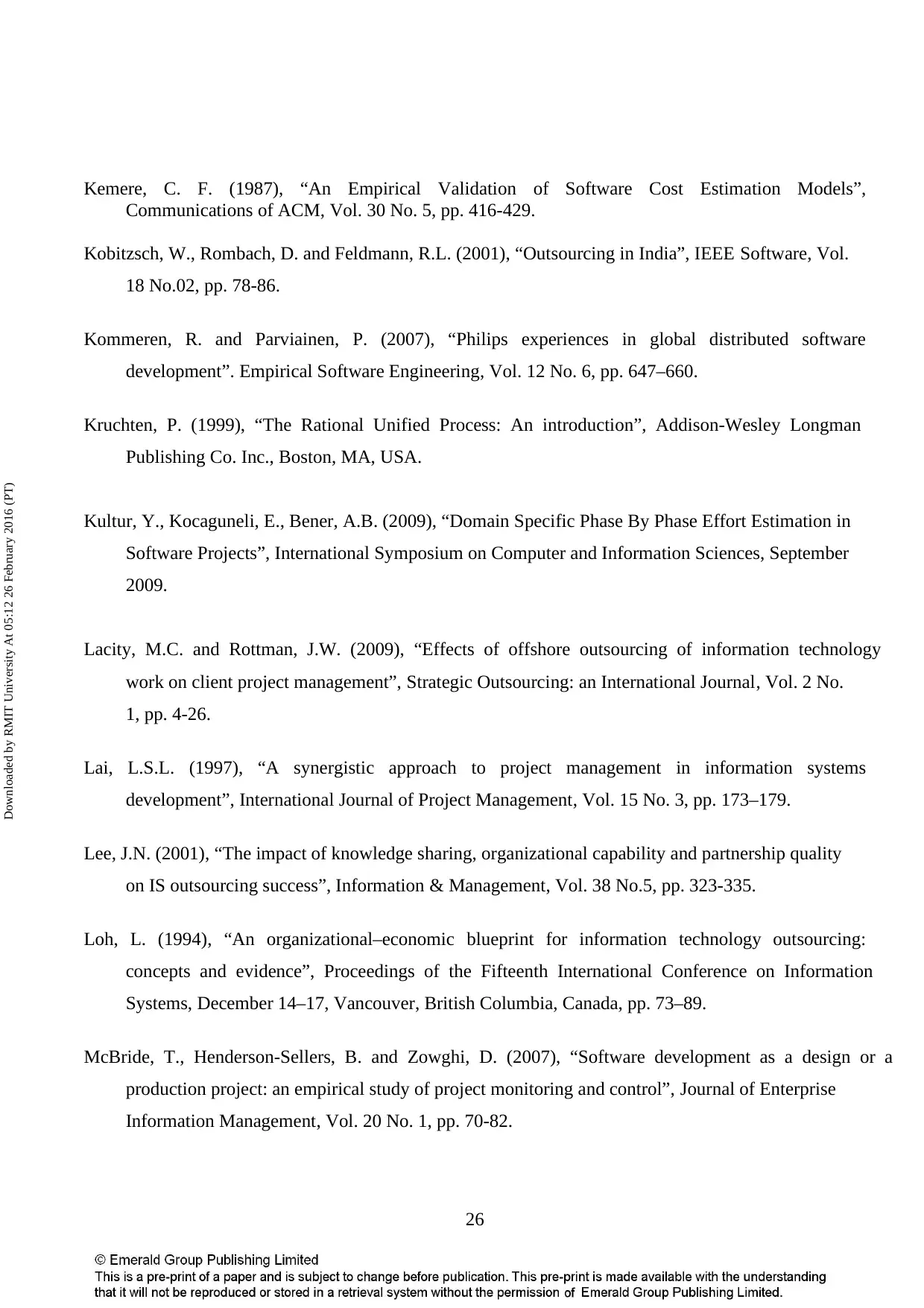
26
Kemere, C. F. (1987), “An Empirical Validation of Software Cost Estimation Models”,
Communications of ACM, Vol. 30 No. 5, pp. 416-429.
Kobitzsch, W., Rombach, D. and Feldmann, R.L. (2001), “Outsourcing in India”, IEEE Software, Vol.
18 No.02, pp. 78-86.
Kommeren, R. and Parviainen, P. (2007), “Philips experiences in global distributed software
development”. Empirical Software Engineering, Vol. 12 No. 6, pp. 647–660.
Kruchten, P. (1999), “The Rational Unified Process: An introduction”, Addison-Wesley Longman
Publishing Co. Inc., Boston, MA, USA.
Kultur, Y., Kocaguneli, E., Bener, A.B. (2009), “Domain Specific Phase By Phase Effort Estimation in
Software Projects”, International Symposium on Computer and Information Sciences, September
2009.
Lacity, M.C. and Rottman, J.W. (2009), “Effects of offshore outsourcing of information technology
work on client project management”, Strategic Outsourcing: an International Journal, Vol. 2 No.
1, pp. 4-26.
Lai, L.S.L. (1997), “A synergistic approach to project management in information systems
development”, International Journal of Project Management, Vol. 15 No. 3, pp. 173–179.
Lee, J.N. (2001), “The impact of knowledge sharing, organizational capability and partnership quality
on IS outsourcing success”, Information & Management, Vol. 38 No.5, pp. 323-335.
Loh, L. (1994), “An organizational–economic blueprint for information technology outsourcing:
concepts and evidence”, Proceedings of the Fifteenth International Conference on Information
Systems, December 14–17, Vancouver, British Columbia, Canada, pp. 73–89.
McBride, T., Henderson-Sellers, B. and Zowghi, D. (2007), “Software development as a design or a
production project: an empirical study of project monitoring and control”, Journal of Enterprise
Information Management, Vol. 20 No. 1, pp. 70-82.
Downloaded by RMIT University At 05:12 26 February 2016 (PT)
Kemere, C. F. (1987), “An Empirical Validation of Software Cost Estimation Models”,
Communications of ACM, Vol. 30 No. 5, pp. 416-429.
Kobitzsch, W., Rombach, D. and Feldmann, R.L. (2001), “Outsourcing in India”, IEEE Software, Vol.
18 No.02, pp. 78-86.
Kommeren, R. and Parviainen, P. (2007), “Philips experiences in global distributed software
development”. Empirical Software Engineering, Vol. 12 No. 6, pp. 647–660.
Kruchten, P. (1999), “The Rational Unified Process: An introduction”, Addison-Wesley Longman
Publishing Co. Inc., Boston, MA, USA.
Kultur, Y., Kocaguneli, E., Bener, A.B. (2009), “Domain Specific Phase By Phase Effort Estimation in
Software Projects”, International Symposium on Computer and Information Sciences, September
2009.
Lacity, M.C. and Rottman, J.W. (2009), “Effects of offshore outsourcing of information technology
work on client project management”, Strategic Outsourcing: an International Journal, Vol. 2 No.
1, pp. 4-26.
Lai, L.S.L. (1997), “A synergistic approach to project management in information systems
development”, International Journal of Project Management, Vol. 15 No. 3, pp. 173–179.
Lee, J.N. (2001), “The impact of knowledge sharing, organizational capability and partnership quality
on IS outsourcing success”, Information & Management, Vol. 38 No.5, pp. 323-335.
Loh, L. (1994), “An organizational–economic blueprint for information technology outsourcing:
concepts and evidence”, Proceedings of the Fifteenth International Conference on Information
Systems, December 14–17, Vancouver, British Columbia, Canada, pp. 73–89.
McBride, T., Henderson-Sellers, B. and Zowghi, D. (2007), “Software development as a design or a
production project: an empirical study of project monitoring and control”, Journal of Enterprise
Information Management, Vol. 20 No. 1, pp. 70-82.
Downloaded by RMIT University At 05:12 26 February 2016 (PT)
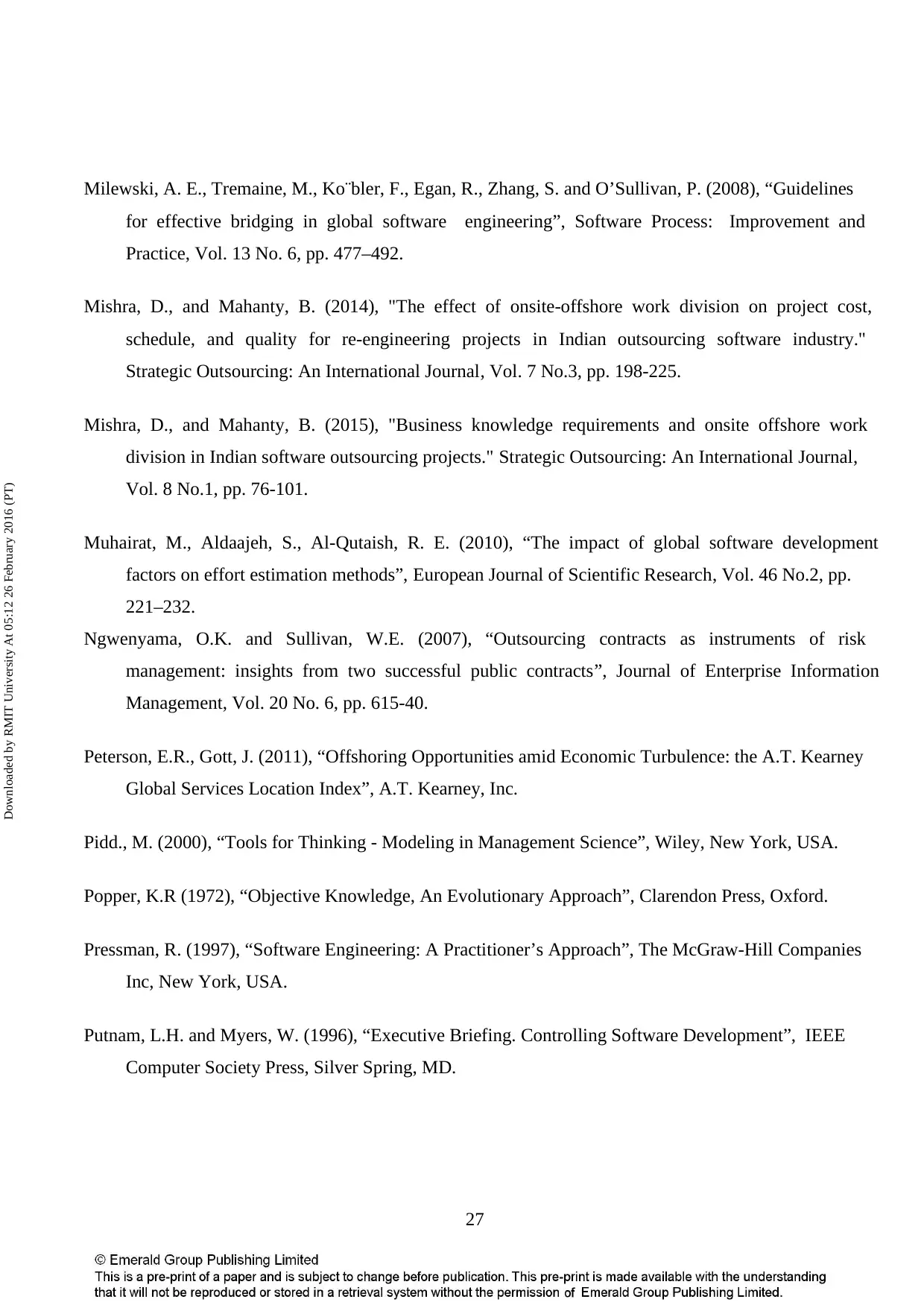
27
Milewski, A. E., Tremaine, M., Ko¨bler, F., Egan, R., Zhang, S. and O’Sullivan, P. (2008), “Guidelines
for effective bridging in global software engineering”, Software Process: Improvement and
Practice, Vol. 13 No. 6, pp. 477–492.
Mishra, D., and Mahanty, B. (2014), "The effect of onsite-offshore work division on project cost,
schedule, and quality for re-engineering projects in Indian outsourcing software industry."
Strategic Outsourcing: An International Journal, Vol. 7 No.3, pp. 198-225.
Mishra, D., and Mahanty, B. (2015), "Business knowledge requirements and onsite offshore work
division in Indian software outsourcing projects." Strategic Outsourcing: An International Journal,
Vol. 8 No.1, pp. 76-101.
Muhairat, M., Aldaajeh, S., Al-Qutaish, R. E. (2010), “The impact of global software development
factors on effort estimation methods”, European Journal of Scientific Research, Vol. 46 No.2, pp.
221–232.
Ngwenyama, O.K. and Sullivan, W.E. (2007), “Outsourcing contracts as instruments of risk
management: insights from two successful public contracts”, Journal of Enterprise Information
Management, Vol. 20 No. 6, pp. 615-40.
Peterson, E.R., Gott, J. (2011), “Offshoring Opportunities amid Economic Turbulence: the A.T. Kearney
Global Services Location Index”, A.T. Kearney, Inc.
Pidd., M. (2000), “Tools for Thinking - Modeling in Management Science”, Wiley, New York, USA.
Popper, K.R (1972), “Objective Knowledge, An Evolutionary Approach”, Clarendon Press, Oxford.
Pressman, R. (1997), “Software Engineering: A Practitioner’s Approach”, The McGraw-Hill Companies
Inc, New York, USA.
Putnam, L.H. and Myers, W. (1996), “Executive Briefing. Controlling Software Development”, IEEE
Computer Society Press, Silver Spring, MD.
Downloaded by RMIT University At 05:12 26 February 2016 (PT)
Milewski, A. E., Tremaine, M., Ko¨bler, F., Egan, R., Zhang, S. and O’Sullivan, P. (2008), “Guidelines
for effective bridging in global software engineering”, Software Process: Improvement and
Practice, Vol. 13 No. 6, pp. 477–492.
Mishra, D., and Mahanty, B. (2014), "The effect of onsite-offshore work division on project cost,
schedule, and quality for re-engineering projects in Indian outsourcing software industry."
Strategic Outsourcing: An International Journal, Vol. 7 No.3, pp. 198-225.
Mishra, D., and Mahanty, B. (2015), "Business knowledge requirements and onsite offshore work
division in Indian software outsourcing projects." Strategic Outsourcing: An International Journal,
Vol. 8 No.1, pp. 76-101.
Muhairat, M., Aldaajeh, S., Al-Qutaish, R. E. (2010), “The impact of global software development
factors on effort estimation methods”, European Journal of Scientific Research, Vol. 46 No.2, pp.
221–232.
Ngwenyama, O.K. and Sullivan, W.E. (2007), “Outsourcing contracts as instruments of risk
management: insights from two successful public contracts”, Journal of Enterprise Information
Management, Vol. 20 No. 6, pp. 615-40.
Peterson, E.R., Gott, J. (2011), “Offshoring Opportunities amid Economic Turbulence: the A.T. Kearney
Global Services Location Index”, A.T. Kearney, Inc.
Pidd., M. (2000), “Tools for Thinking - Modeling in Management Science”, Wiley, New York, USA.
Popper, K.R (1972), “Objective Knowledge, An Evolutionary Approach”, Clarendon Press, Oxford.
Pressman, R. (1997), “Software Engineering: A Practitioner’s Approach”, The McGraw-Hill Companies
Inc, New York, USA.
Putnam, L.H. and Myers, W. (1996), “Executive Briefing. Controlling Software Development”, IEEE
Computer Society Press, Silver Spring, MD.
Downloaded by RMIT University At 05:12 26 February 2016 (PT)
Secure Best Marks with AI Grader
Need help grading? Try our AI Grader for instant feedback on your assignments.
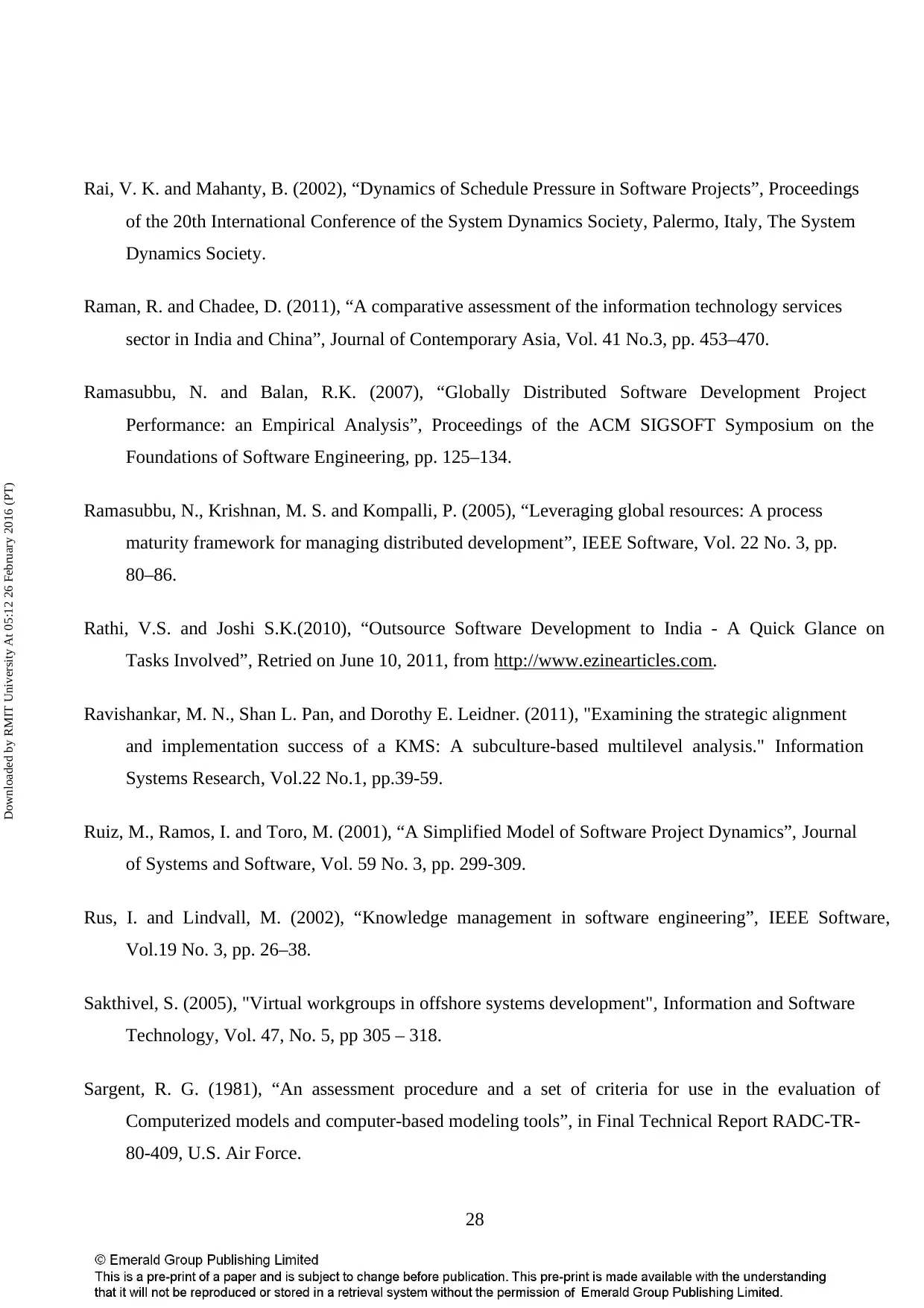
28
Rai, V. K. and Mahanty, B. (2002), “Dynamics of Schedule Pressure in Software Projects”, Proceedings
of the 20th International Conference of the System Dynamics Society, Palermo, Italy, The System
Dynamics Society.
Raman, R. and Chadee, D. (2011), “A comparative assessment of the information technology services
sector in India and China”, Journal of Contemporary Asia, Vol. 41 No.3, pp. 453–470.
Ramasubbu, N. and Balan, R.K. (2007), “Globally Distributed Software Development Project
Performance: an Empirical Analysis”, Proceedings of the ACM SIGSOFT Symposium on the
Foundations of Software Engineering, pp. 125–134.
Ramasubbu, N., Krishnan, M. S. and Kompalli, P. (2005), “Leveraging global resources: A process
maturity framework for managing distributed development”, IEEE Software, Vol. 22 No. 3, pp.
80–86.
Rathi, V.S. and Joshi S.K.(2010), “Outsource Software Development to India - A Quick Glance on
Tasks Involved”, Retried on June 10, 2011, from http://www.ezinearticles.com.
Ravishankar, M. N., Shan L. Pan, and Dorothy E. Leidner. (2011), "Examining the strategic alignment
and implementation success of a KMS: A subculture-based multilevel analysis." Information
Systems Research, Vol.22 No.1, pp.39-59.
Ruiz, M., Ramos, I. and Toro, M. (2001), “A Simplified Model of Software Project Dynamics”, Journal
of Systems and Software, Vol. 59 No. 3, pp. 299-309.
Rus, I. and Lindvall, M. (2002), “Knowledge management in software engineering”, IEEE Software,
Vol.19 No. 3, pp. 26–38.
Sakthivel, S. (2005), "Virtual workgroups in offshore systems development", Information and Software
Technology, Vol. 47, No. 5, pp 305 – 318.
Sargent, R. G. (1981), “An assessment procedure and a set of criteria for use in the evaluation of
Computerized models and computer-based modeling tools”, in Final Technical Report RADC-TR-
80-409, U.S. Air Force.
Downloaded by RMIT University At 05:12 26 February 2016 (PT)
Rai, V. K. and Mahanty, B. (2002), “Dynamics of Schedule Pressure in Software Projects”, Proceedings
of the 20th International Conference of the System Dynamics Society, Palermo, Italy, The System
Dynamics Society.
Raman, R. and Chadee, D. (2011), “A comparative assessment of the information technology services
sector in India and China”, Journal of Contemporary Asia, Vol. 41 No.3, pp. 453–470.
Ramasubbu, N. and Balan, R.K. (2007), “Globally Distributed Software Development Project
Performance: an Empirical Analysis”, Proceedings of the ACM SIGSOFT Symposium on the
Foundations of Software Engineering, pp. 125–134.
Ramasubbu, N., Krishnan, M. S. and Kompalli, P. (2005), “Leveraging global resources: A process
maturity framework for managing distributed development”, IEEE Software, Vol. 22 No. 3, pp.
80–86.
Rathi, V.S. and Joshi S.K.(2010), “Outsource Software Development to India - A Quick Glance on
Tasks Involved”, Retried on June 10, 2011, from http://www.ezinearticles.com.
Ravishankar, M. N., Shan L. Pan, and Dorothy E. Leidner. (2011), "Examining the strategic alignment
and implementation success of a KMS: A subculture-based multilevel analysis." Information
Systems Research, Vol.22 No.1, pp.39-59.
Ruiz, M., Ramos, I. and Toro, M. (2001), “A Simplified Model of Software Project Dynamics”, Journal
of Systems and Software, Vol. 59 No. 3, pp. 299-309.
Rus, I. and Lindvall, M. (2002), “Knowledge management in software engineering”, IEEE Software,
Vol.19 No. 3, pp. 26–38.
Sakthivel, S. (2005), "Virtual workgroups in offshore systems development", Information and Software
Technology, Vol. 47, No. 5, pp 305 – 318.
Sargent, R. G. (1981), “An assessment procedure and a set of criteria for use in the evaluation of
Computerized models and computer-based modeling tools”, in Final Technical Report RADC-TR-
80-409, U.S. Air Force.
Downloaded by RMIT University At 05:12 26 February 2016 (PT)
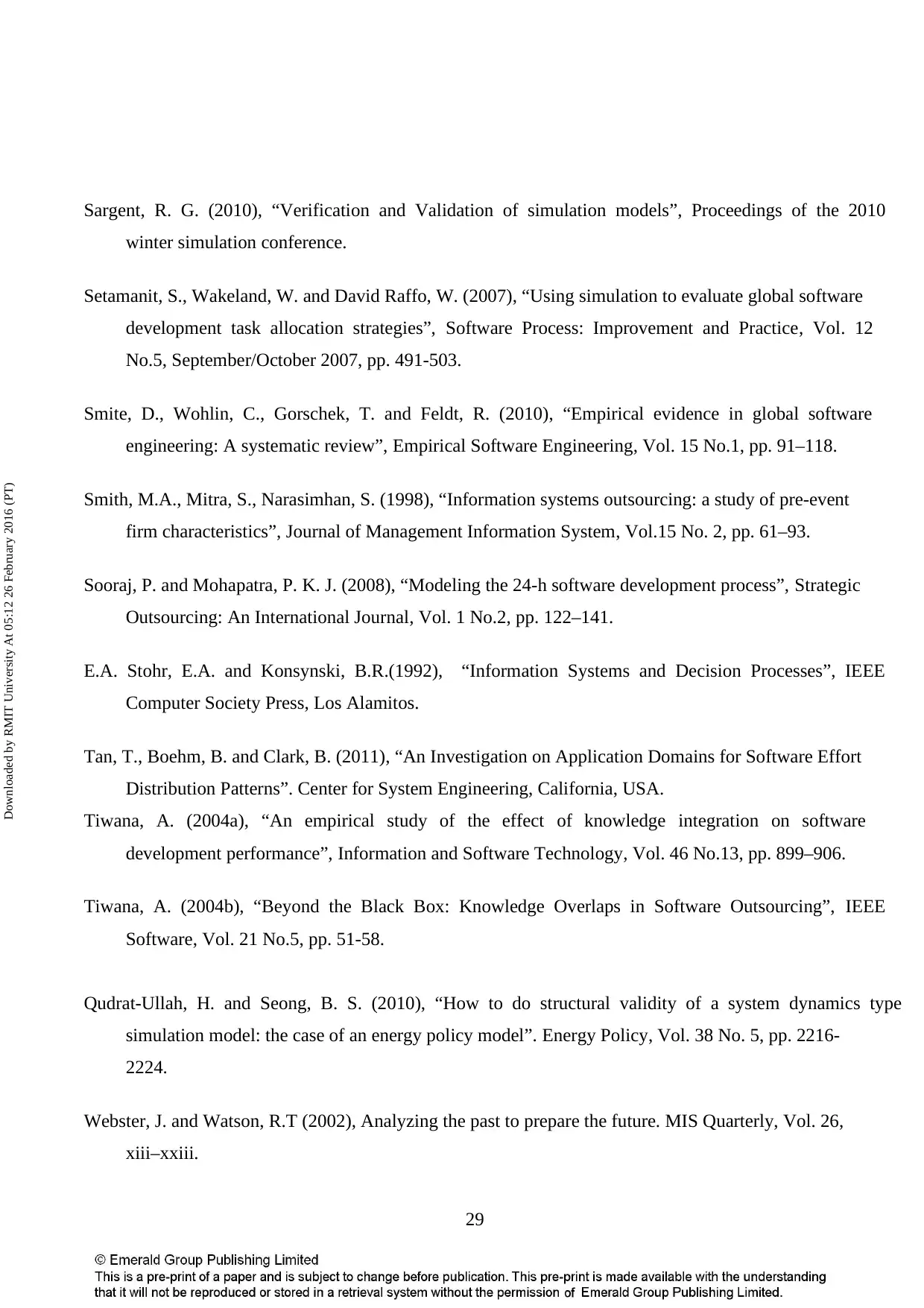
29
Sargent, R. G. (2010), “Verification and Validation of simulation models”, Proceedings of the 2010
winter simulation conference.
Setamanit, S., Wakeland, W. and David Raffo, W. (2007), “Using simulation to evaluate global software
development task allocation strategies”, Software Process: Improvement and Practice, Vol. 12
No.5, September/October 2007, pp. 491-503.
Smite, D., Wohlin, C., Gorschek, T. and Feldt, R. (2010), “Empirical evidence in global software
engineering: A systematic review”, Empirical Software Engineering, Vol. 15 No.1, pp. 91–118.
Smith, M.A., Mitra, S., Narasimhan, S. (1998), “Information systems outsourcing: a study of pre-event
firm characteristics”, Journal of Management Information System, Vol.15 No. 2, pp. 61–93.
Sooraj, P. and Mohapatra, P. K. J. (2008), “Modeling the 24-h software development process”, Strategic
Outsourcing: An International Journal, Vol. 1 No.2, pp. 122–141.
E.A. Stohr, E.A. and Konsynski, B.R.(1992), “Information Systems and Decision Processes”, IEEE
Computer Society Press, Los Alamitos.
Tan, T., Boehm, B. and Clark, B. (2011), “An Investigation on Application Domains for Software Effort
Distribution Patterns”. Center for System Engineering, California, USA.
Tiwana, A. (2004a), “An empirical study of the effect of knowledge integration on software
development performance”, Information and Software Technology, Vol. 46 No.13, pp. 899–906.
Tiwana, A. (2004b), “Beyond the Black Box: Knowledge Overlaps in Software Outsourcing”, IEEE
Software, Vol. 21 No.5, pp. 51-58.
Qudrat-Ullah, H. and Seong, B. S. (2010), “How to do structural validity of a system dynamics type
simulation model: the case of an energy policy model”. Energy Policy, Vol. 38 No. 5, pp. 2216-
2224.
Webster, J. and Watson, R.T (2002), Analyzing the past to prepare the future. MIS Quarterly, Vol. 26,
xiii–xxiii.
Downloaded by RMIT University At 05:12 26 February 2016 (PT)
Sargent, R. G. (2010), “Verification and Validation of simulation models”, Proceedings of the 2010
winter simulation conference.
Setamanit, S., Wakeland, W. and David Raffo, W. (2007), “Using simulation to evaluate global software
development task allocation strategies”, Software Process: Improvement and Practice, Vol. 12
No.5, September/October 2007, pp. 491-503.
Smite, D., Wohlin, C., Gorschek, T. and Feldt, R. (2010), “Empirical evidence in global software
engineering: A systematic review”, Empirical Software Engineering, Vol. 15 No.1, pp. 91–118.
Smith, M.A., Mitra, S., Narasimhan, S. (1998), “Information systems outsourcing: a study of pre-event
firm characteristics”, Journal of Management Information System, Vol.15 No. 2, pp. 61–93.
Sooraj, P. and Mohapatra, P. K. J. (2008), “Modeling the 24-h software development process”, Strategic
Outsourcing: An International Journal, Vol. 1 No.2, pp. 122–141.
E.A. Stohr, E.A. and Konsynski, B.R.(1992), “Information Systems and Decision Processes”, IEEE
Computer Society Press, Los Alamitos.
Tan, T., Boehm, B. and Clark, B. (2011), “An Investigation on Application Domains for Software Effort
Distribution Patterns”. Center for System Engineering, California, USA.
Tiwana, A. (2004a), “An empirical study of the effect of knowledge integration on software
development performance”, Information and Software Technology, Vol. 46 No.13, pp. 899–906.
Tiwana, A. (2004b), “Beyond the Black Box: Knowledge Overlaps in Software Outsourcing”, IEEE
Software, Vol. 21 No.5, pp. 51-58.
Qudrat-Ullah, H. and Seong, B. S. (2010), “How to do structural validity of a system dynamics type
simulation model: the case of an energy policy model”. Energy Policy, Vol. 38 No. 5, pp. 2216-
2224.
Webster, J. and Watson, R.T (2002), Analyzing the past to prepare the future. MIS Quarterly, Vol. 26,
xiii–xxiii.
Downloaded by RMIT University At 05:12 26 February 2016 (PT)
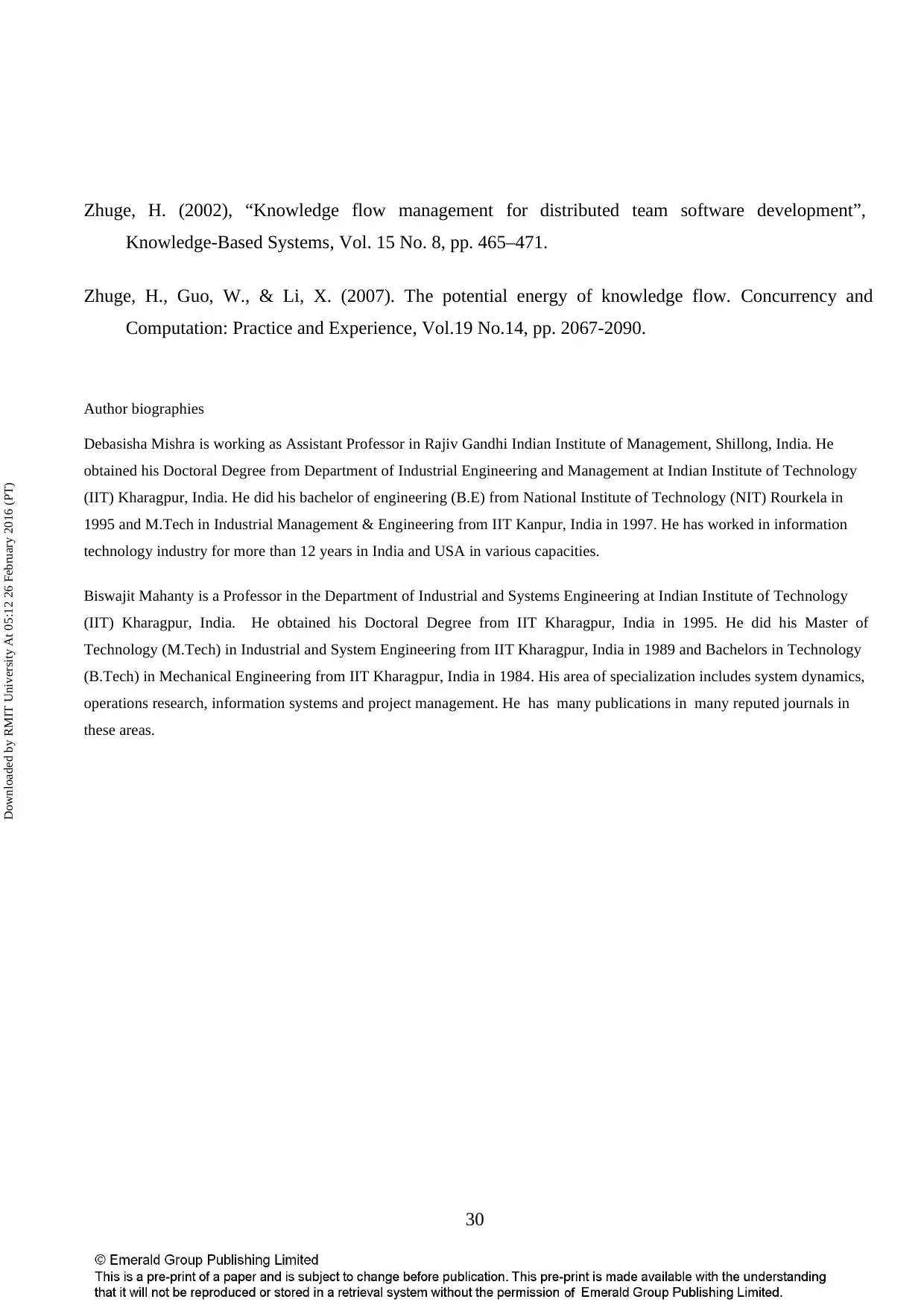
30
Zhuge, H. (2002), “Knowledge flow management for distributed team software development”,
Knowledge-Based Systems, Vol. 15 No. 8, pp. 465–471.
Zhuge, H., Guo, W., & Li, X. (2007). The potential energy of knowledge flow. Concurrency and
Computation: Practice and Experience, Vol.19 No.14, pp. 2067-2090.
Author biographies
Debasisha Mishra is working as Assistant Professor in Rajiv Gandhi Indian Institute of Management, Shillong, India. He
obtained his Doctoral Degree from Department of Industrial Engineering and Management at Indian Institute of Technology
(IIT) Kharagpur, India. He did his bachelor of engineering (B.E) from National Institute of Technology (NIT) Rourkela in
1995 and M.Tech in Industrial Management & Engineering from IIT Kanpur, India in 1997. He has worked in information
technology industry for more than 12 years in India and USA in various capacities.
Biswajit Mahanty is a Professor in the Department of Industrial and Systems Engineering at Indian Institute of Technology
(IIT) Kharagpur, India. He obtained his Doctoral Degree from IIT Kharagpur, India in 1995. He did his Master of
Technology (M.Tech) in Industrial and System Engineering from IIT Kharagpur, India in 1989 and Bachelors in Technology
(B.Tech) in Mechanical Engineering from IIT Kharagpur, India in 1984. His area of specialization includes system dynamics,
operations research, information systems and project management. He has many publications in many reputed journals in
these areas.
Downloaded by RMIT University At 05:12 26 February 2016 (PT)
Zhuge, H. (2002), “Knowledge flow management for distributed team software development”,
Knowledge-Based Systems, Vol. 15 No. 8, pp. 465–471.
Zhuge, H., Guo, W., & Li, X. (2007). The potential energy of knowledge flow. Concurrency and
Computation: Practice and Experience, Vol.19 No.14, pp. 2067-2090.
Author biographies
Debasisha Mishra is working as Assistant Professor in Rajiv Gandhi Indian Institute of Management, Shillong, India. He
obtained his Doctoral Degree from Department of Industrial Engineering and Management at Indian Institute of Technology
(IIT) Kharagpur, India. He did his bachelor of engineering (B.E) from National Institute of Technology (NIT) Rourkela in
1995 and M.Tech in Industrial Management & Engineering from IIT Kanpur, India in 1997. He has worked in information
technology industry for more than 12 years in India and USA in various capacities.
Biswajit Mahanty is a Professor in the Department of Industrial and Systems Engineering at Indian Institute of Technology
(IIT) Kharagpur, India. He obtained his Doctoral Degree from IIT Kharagpur, India in 1995. He did his Master of
Technology (M.Tech) in Industrial and System Engineering from IIT Kharagpur, India in 1989 and Bachelors in Technology
(B.Tech) in Mechanical Engineering from IIT Kharagpur, India in 1984. His area of specialization includes system dynamics,
operations research, information systems and project management. He has many publications in many reputed journals in
these areas.
Downloaded by RMIT University At 05:12 26 February 2016 (PT)
Paraphrase This Document
Need a fresh take? Get an instant paraphrase of this document with our AI Paraphraser
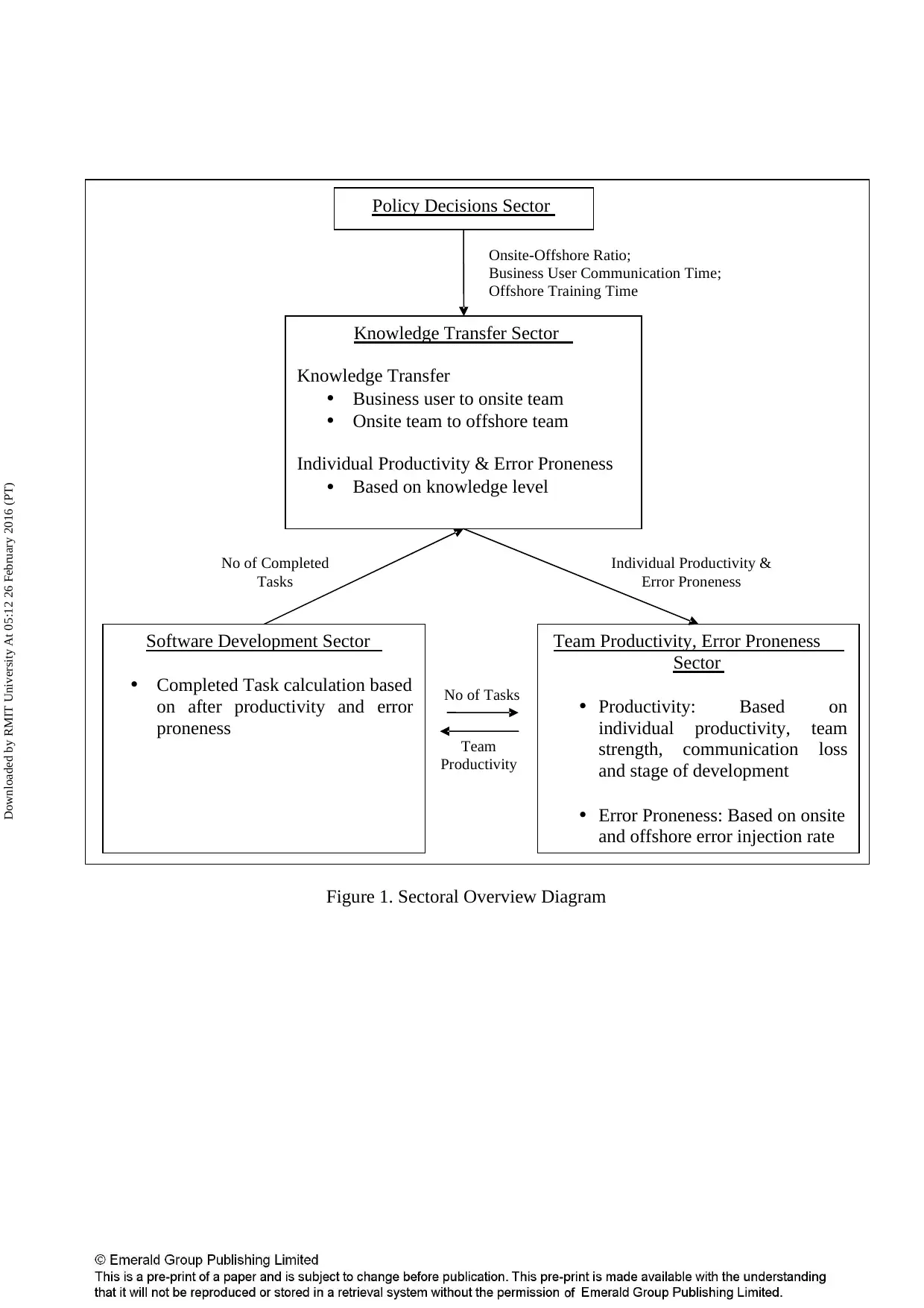
Figure 1. Sectoral Overview Diagram
Policy Decisions Sector
Knowledge Transfer Sector
Knowledge Transfer
• Business user to onsite team
• Onsite team to offshore team
Individual Productivity & Error Proneness
• Based on knowledge level
Individual Productivity &
Error Proneness
No of Completed
Tasks
Onsite-Offshore Ratio;
Business User Communication Time;
Offshore Training Time
Software Development Sector
• Completed Task calculation based
on after productivity and error
proneness
Team Productivity, Error Proneness
Sector
• Productivity: Based on
individual productivity, team
strength, communication loss
and stage of development
• Error Proneness: Based on onsite
and offshore error injection rate
No of Tasks
Team
Productivity
Downloaded by RMIT University At 05:12 26 February 2016 (PT)
Policy Decisions Sector
Knowledge Transfer Sector
Knowledge Transfer
• Business user to onsite team
• Onsite team to offshore team
Individual Productivity & Error Proneness
• Based on knowledge level
Individual Productivity &
Error Proneness
No of Completed
Tasks
Onsite-Offshore Ratio;
Business User Communication Time;
Offshore Training Time
Software Development Sector
• Completed Task calculation based
on after productivity and error
proneness
Team Productivity, Error Proneness
Sector
• Productivity: Based on
individual productivity, team
strength, communication loss
and stage of development
• Error Proneness: Based on onsite
and offshore error injection rate
No of Tasks
Team
Productivity
Downloaded by RMIT University At 05:12 26 February 2016 (PT)
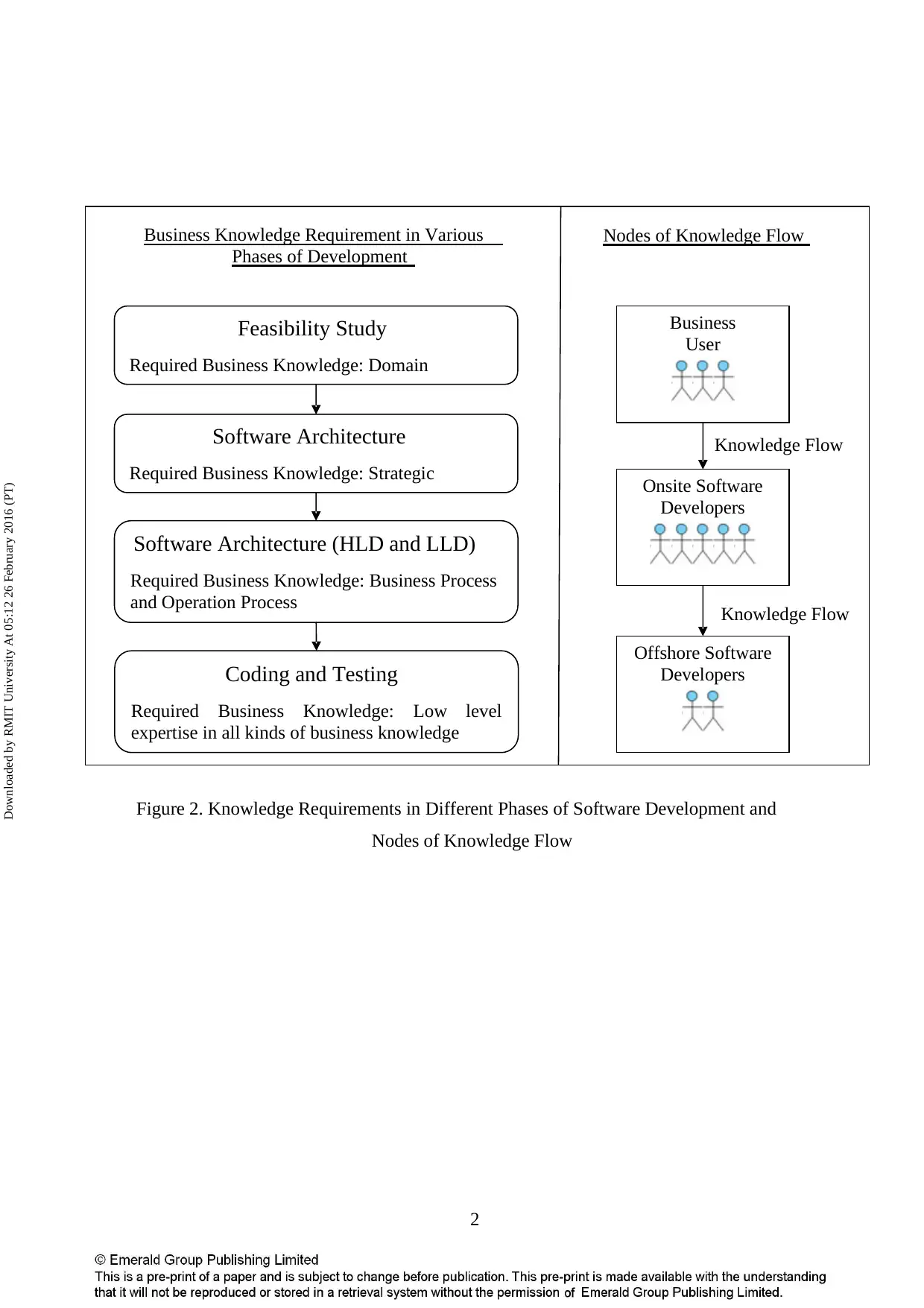
2
Figure 2. Knowledge Requirements in Different Phases of Software Development and
Nodes of Knowledge Flow
Feasibility Study
Required Business Knowledge: Domain
Software Architecture
Required Business Knowledge: Strategic
Software Architecture (HLD and LLD)
Required Business Knowledge: Business Process
and Operation Process
Coding and Testing
Required Business Knowledge: Low level
expertise in all kinds of business knowledge
Business Knowledge Requirement in Various
Phases of Development
Business
User
Nodes of Knowledge Flow
Onsite Software
Developers
Offshore Software
Developers
Knowledge Flow
Knowledge Flow
Downloaded by RMIT University At 05:12 26 February 2016 (PT)
Figure 2. Knowledge Requirements in Different Phases of Software Development and
Nodes of Knowledge Flow
Feasibility Study
Required Business Knowledge: Domain
Software Architecture
Required Business Knowledge: Strategic
Software Architecture (HLD and LLD)
Required Business Knowledge: Business Process
and Operation Process
Coding and Testing
Required Business Knowledge: Low level
expertise in all kinds of business knowledge
Business Knowledge Requirement in Various
Phases of Development
Business
User
Nodes of Knowledge Flow
Onsite Software
Developers
Offshore Software
Developers
Knowledge Flow
Knowledge Flow
Downloaded by RMIT University At 05:12 26 February 2016 (PT)
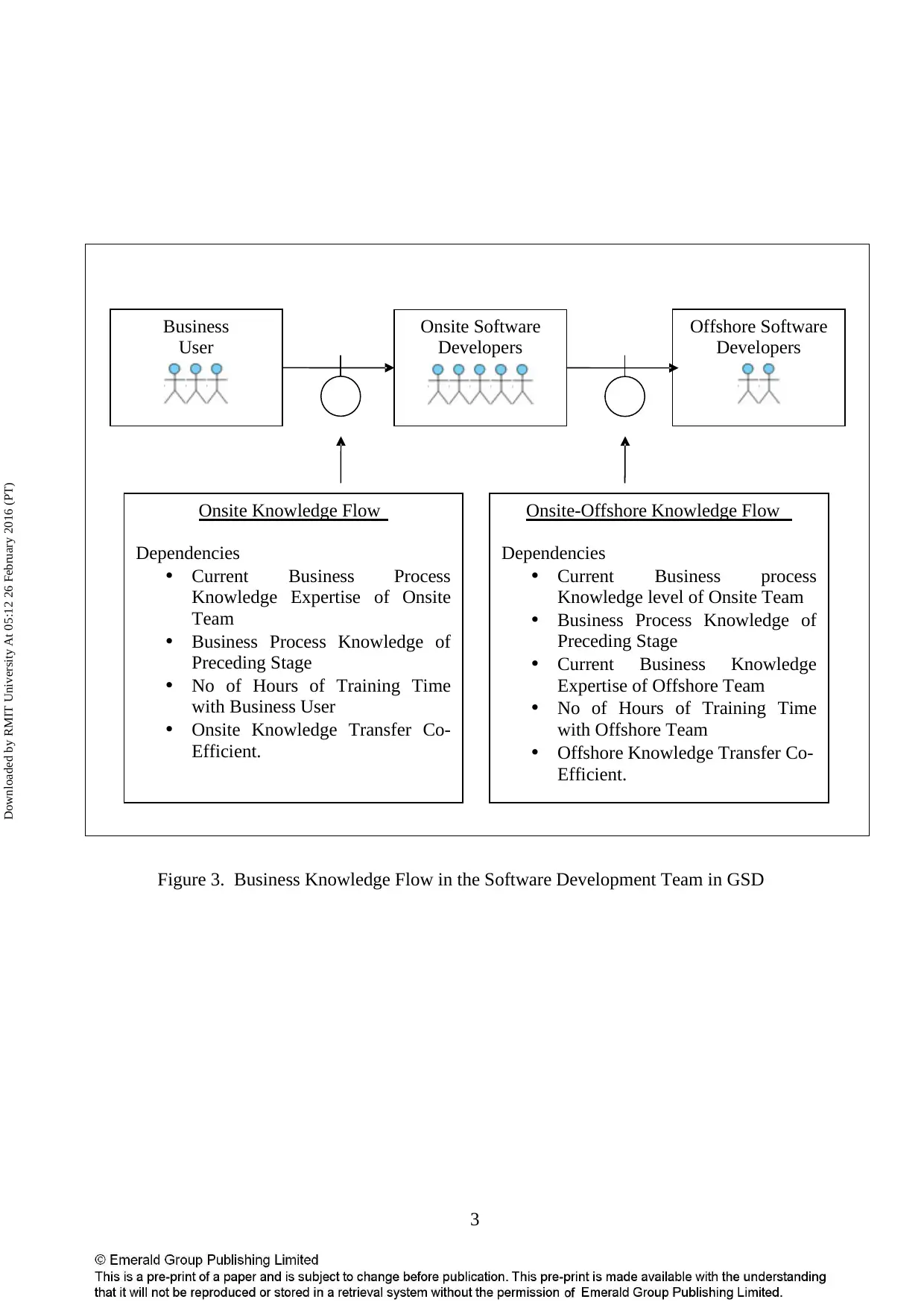
3
Figure 3. Business Knowledge Flow in the Software Development Team in GSD
Business
User
Onsite Software
Developers
Offshore Software
Developers
Onsite Knowledge Flow
Dependencies
• Current Business Process
Knowledge Expertise of Onsite
Team
• Business Process Knowledge of
Preceding Stage
• No of Hours of Training Time
with Business User
• Onsite Knowledge Transfer Co-
Efficient.
Onsite-Offshore Knowledge Flow
Dependencies
• Current Business process
Knowledge level of Onsite Team
• Business Process Knowledge of
Preceding Stage
• Current Business Knowledge
Expertise of Offshore Team
• No of Hours of Training Time
with Offshore Team
• Offshore Knowledge Transfer Co-
Efficient.
Downloaded by RMIT University At 05:12 26 February 2016 (PT)
Figure 3. Business Knowledge Flow in the Software Development Team in GSD
Business
User
Onsite Software
Developers
Offshore Software
Developers
Onsite Knowledge Flow
Dependencies
• Current Business Process
Knowledge Expertise of Onsite
Team
• Business Process Knowledge of
Preceding Stage
• No of Hours of Training Time
with Business User
• Onsite Knowledge Transfer Co-
Efficient.
Onsite-Offshore Knowledge Flow
Dependencies
• Current Business process
Knowledge level of Onsite Team
• Business Process Knowledge of
Preceding Stage
• Current Business Knowledge
Expertise of Offshore Team
• No of Hours of Training Time
with Offshore Team
• Offshore Knowledge Transfer Co-
Efficient.
Downloaded by RMIT University At 05:12 26 February 2016 (PT)
Secure Best Marks with AI Grader
Need help grading? Try our AI Grader for instant feedback on your assignments.
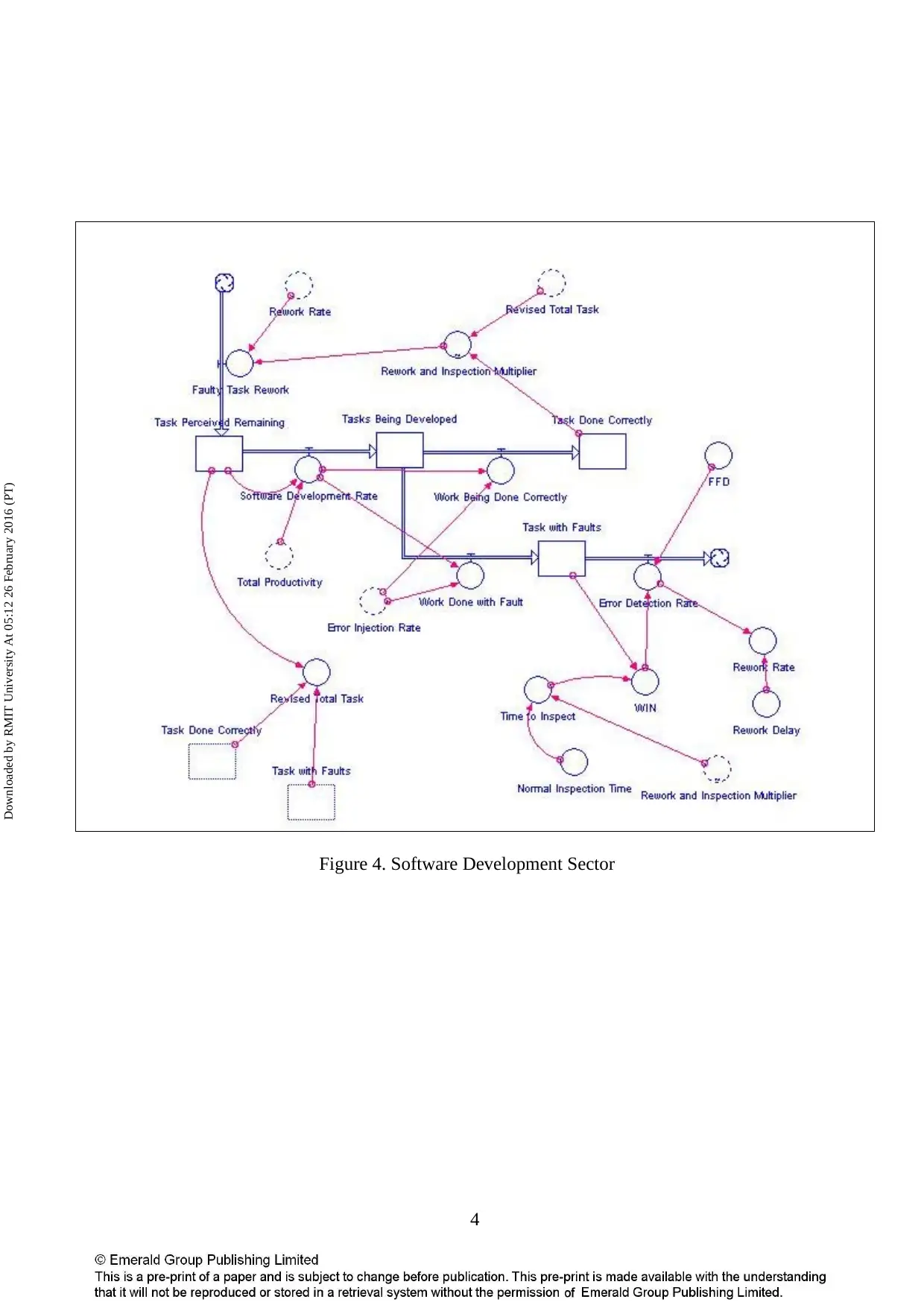
4
Figure 4. Software Development Sector
Downloaded by RMIT University At 05:12 26 February 2016 (PT)
Figure 4. Software Development Sector
Downloaded by RMIT University At 05:12 26 February 2016 (PT)
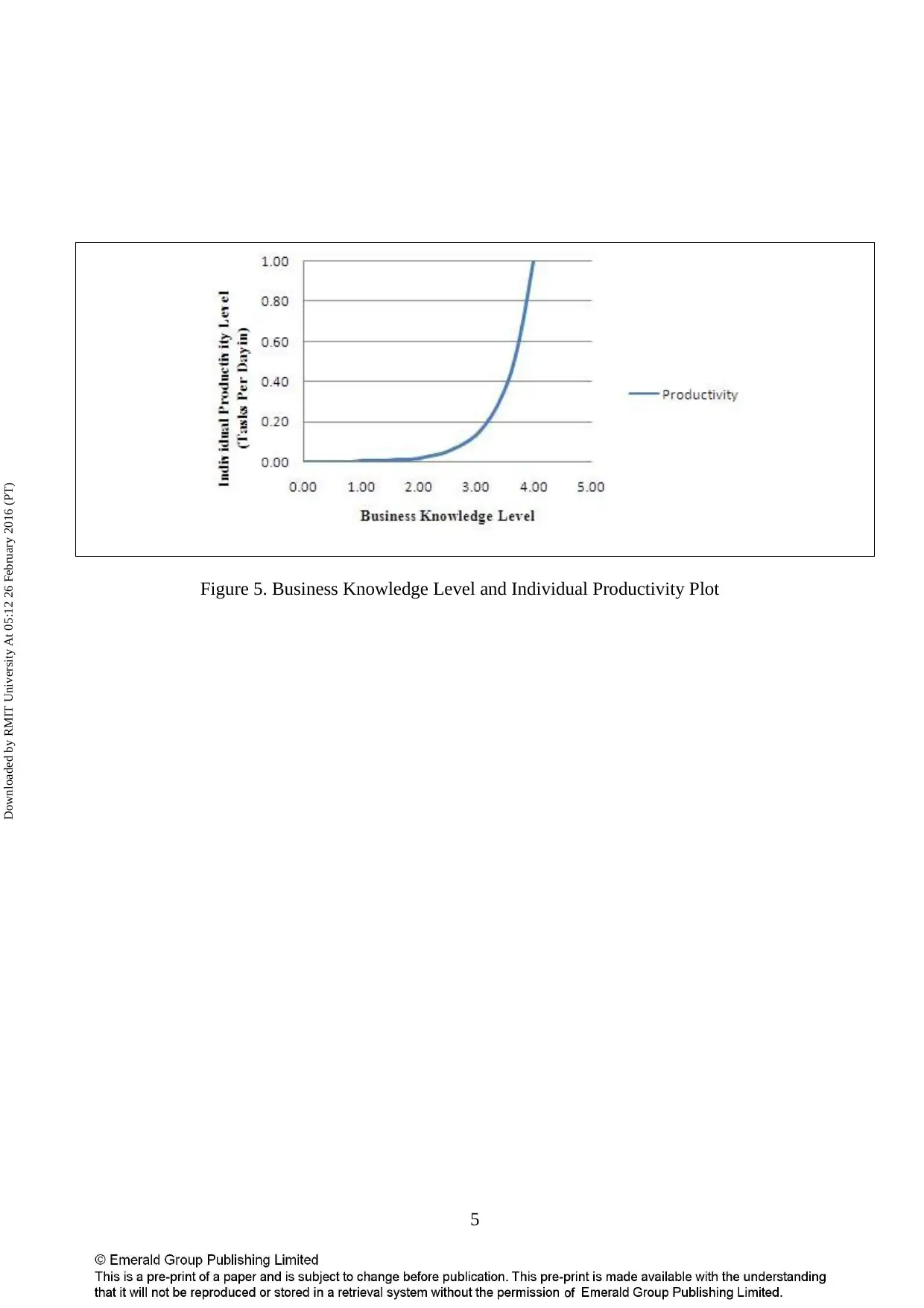
5
Figure 5. Business Knowledge Level and Individual Productivity Plot
Downloaded by RMIT University At 05:12 26 February 2016 (PT)
Figure 5. Business Knowledge Level and Individual Productivity Plot
Downloaded by RMIT University At 05:12 26 February 2016 (PT)
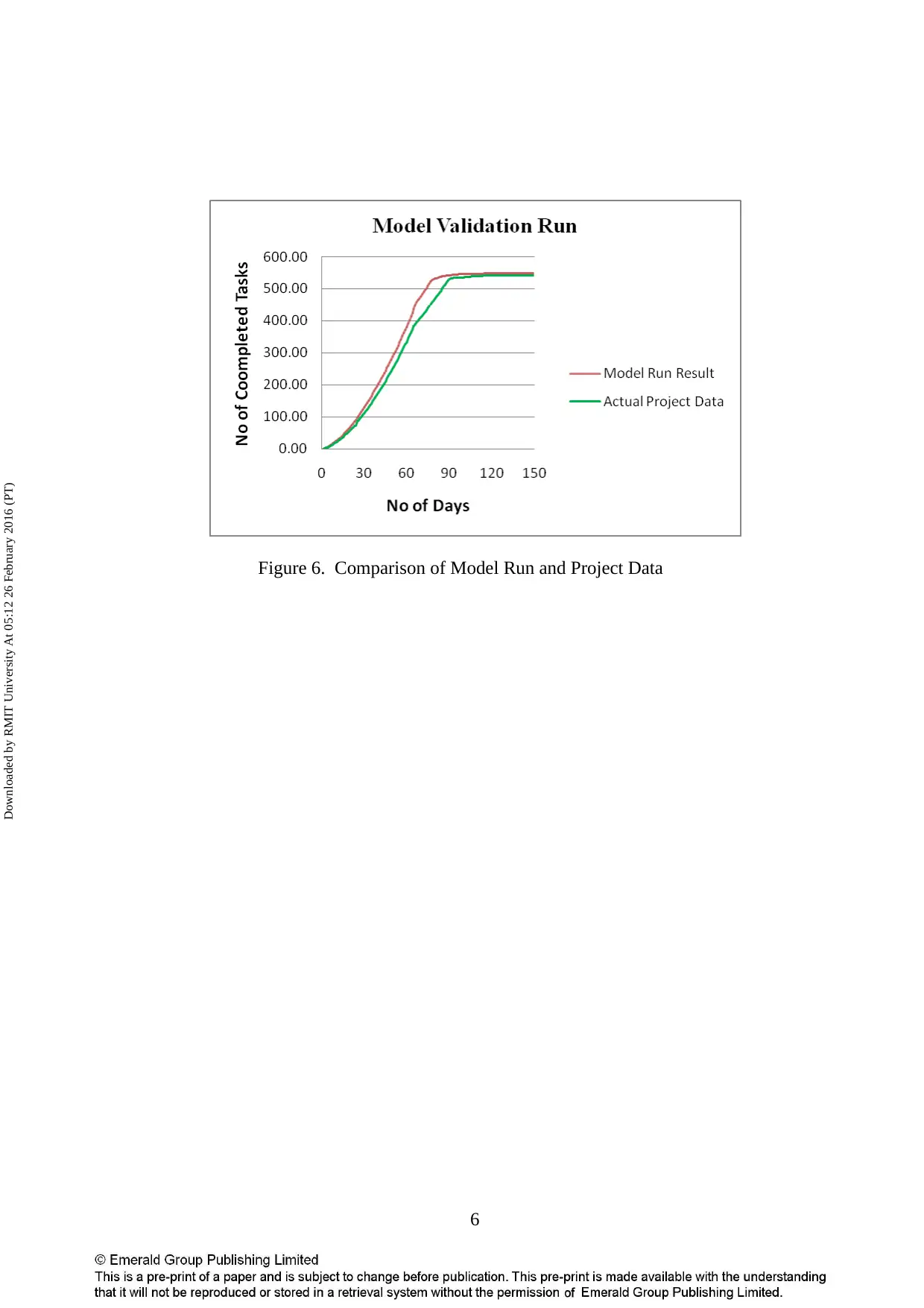
6
Figure 6. Comparison of Model Run and Project Data
Downloaded by RMIT University At 05:12 26 February 2016 (PT)
Figure 6. Comparison of Model Run and Project Data
Downloaded by RMIT University At 05:12 26 February 2016 (PT)
Paraphrase This Document
Need a fresh take? Get an instant paraphrase of this document with our AI Paraphraser
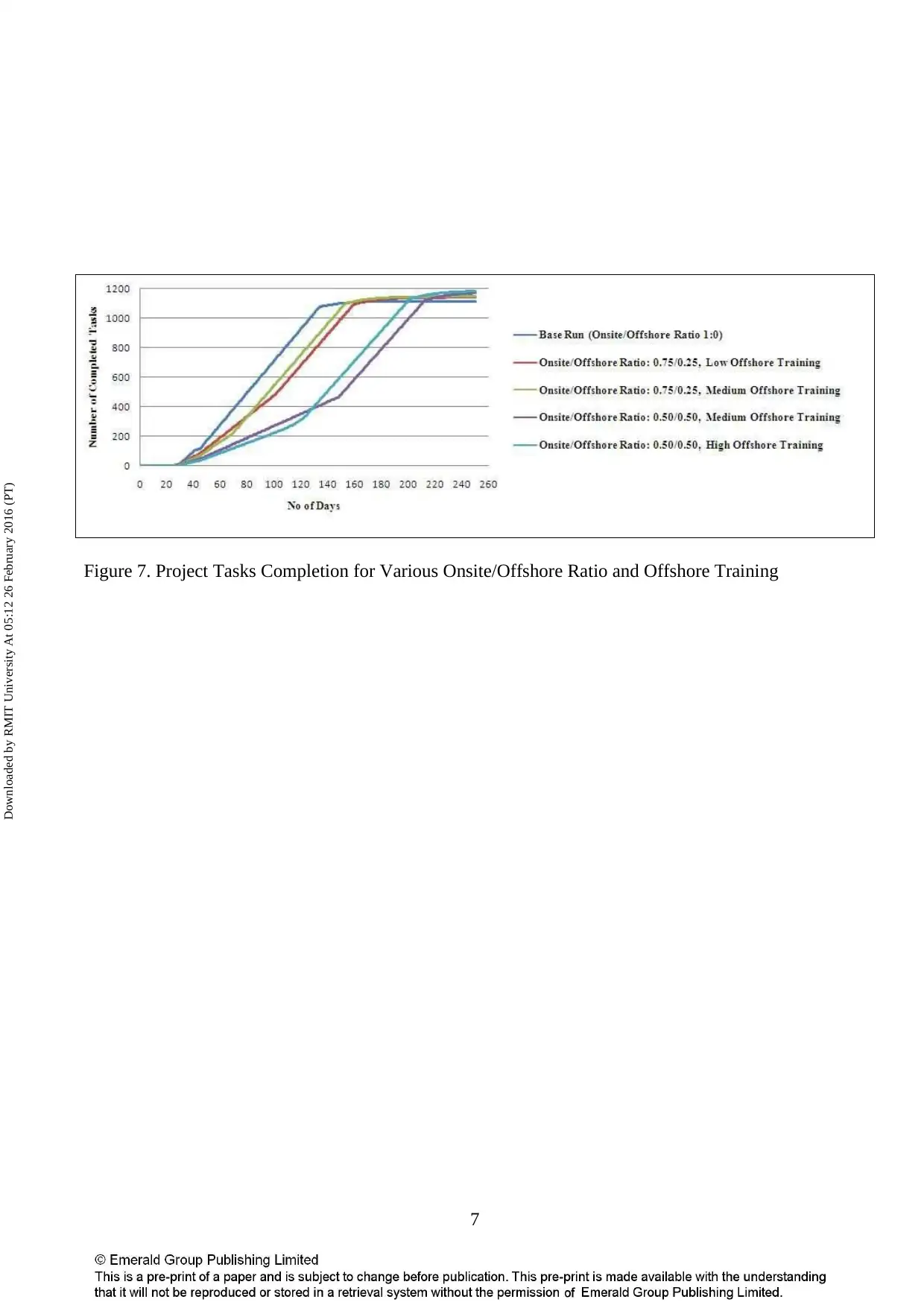
7
Figure 7. Project Tasks Completion for Various Onsite/Offshore Ratio and Offshore Training
Downloaded by RMIT University At 05:12 26 February 2016 (PT)
Figure 7. Project Tasks Completion for Various Onsite/Offshore Ratio and Offshore Training
Downloaded by RMIT University At 05:12 26 February 2016 (PT)
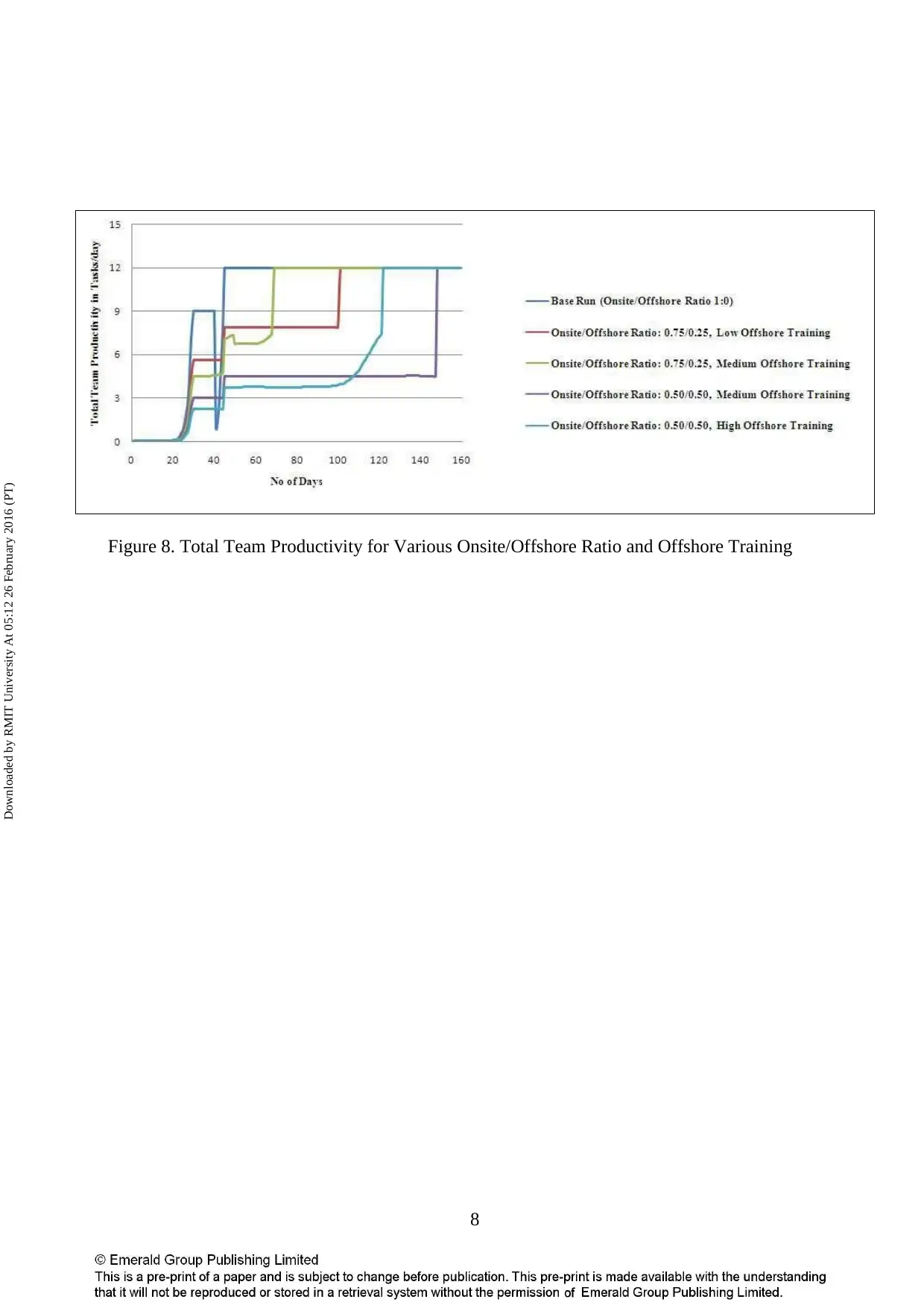
8
Figure 8. Total Team Productivity for Various Onsite/Offshore Ratio and Offshore Training
Downloaded by RMIT University At 05:12 26 February 2016 (PT)
Figure 8. Total Team Productivity for Various Onsite/Offshore Ratio and Offshore Training
Downloaded by RMIT University At 05:12 26 February 2016 (PT)
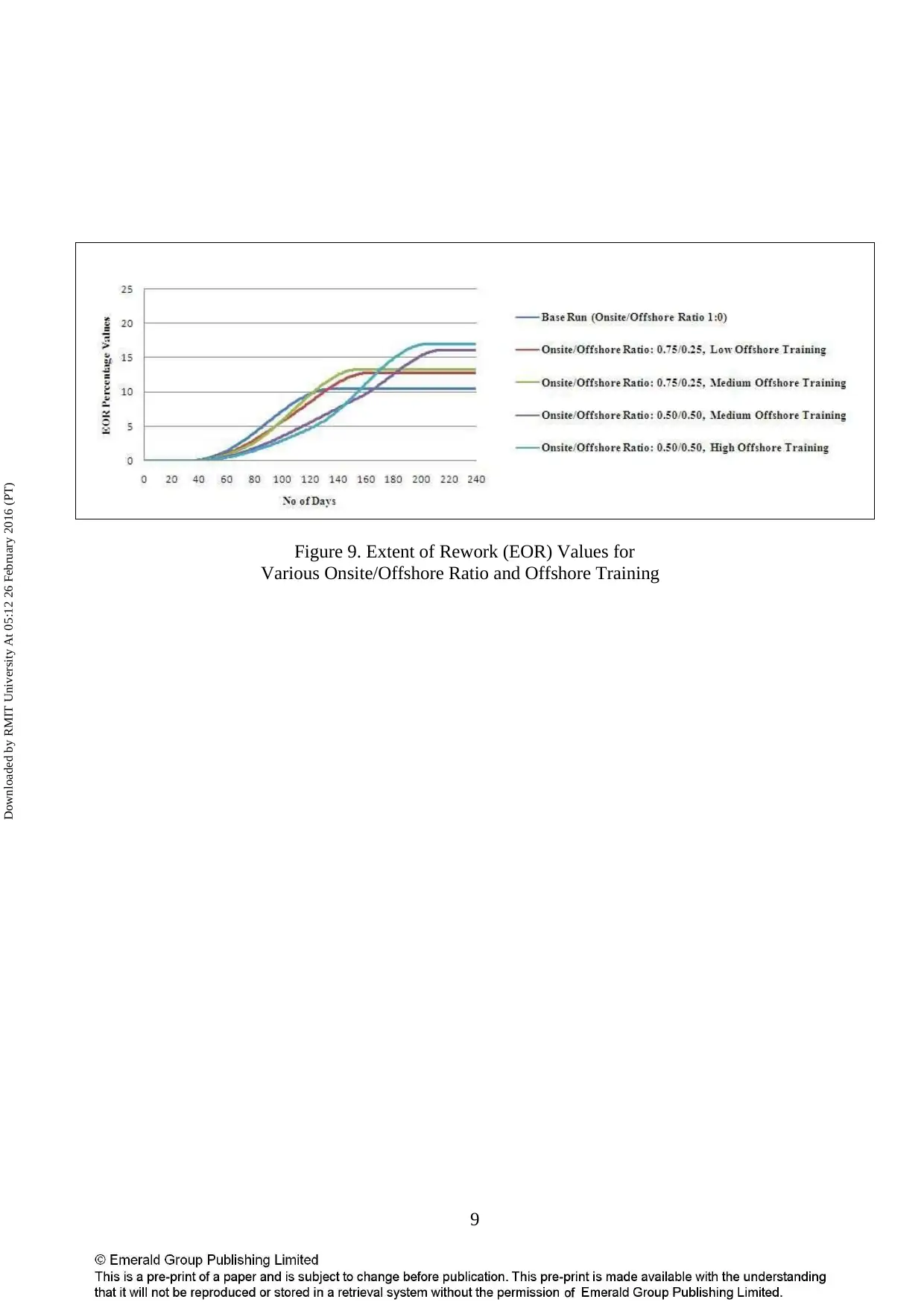
9
Figure 9. Extent of Rework (EOR) Values for
Various Onsite/Offshore Ratio and Offshore Training
Downloaded by RMIT University At 05:12 26 February 2016 (PT)
Figure 9. Extent of Rework (EOR) Values for
Various Onsite/Offshore Ratio and Offshore Training
Downloaded by RMIT University At 05:12 26 February 2016 (PT)
Secure Best Marks with AI Grader
Need help grading? Try our AI Grader for instant feedback on your assignments.
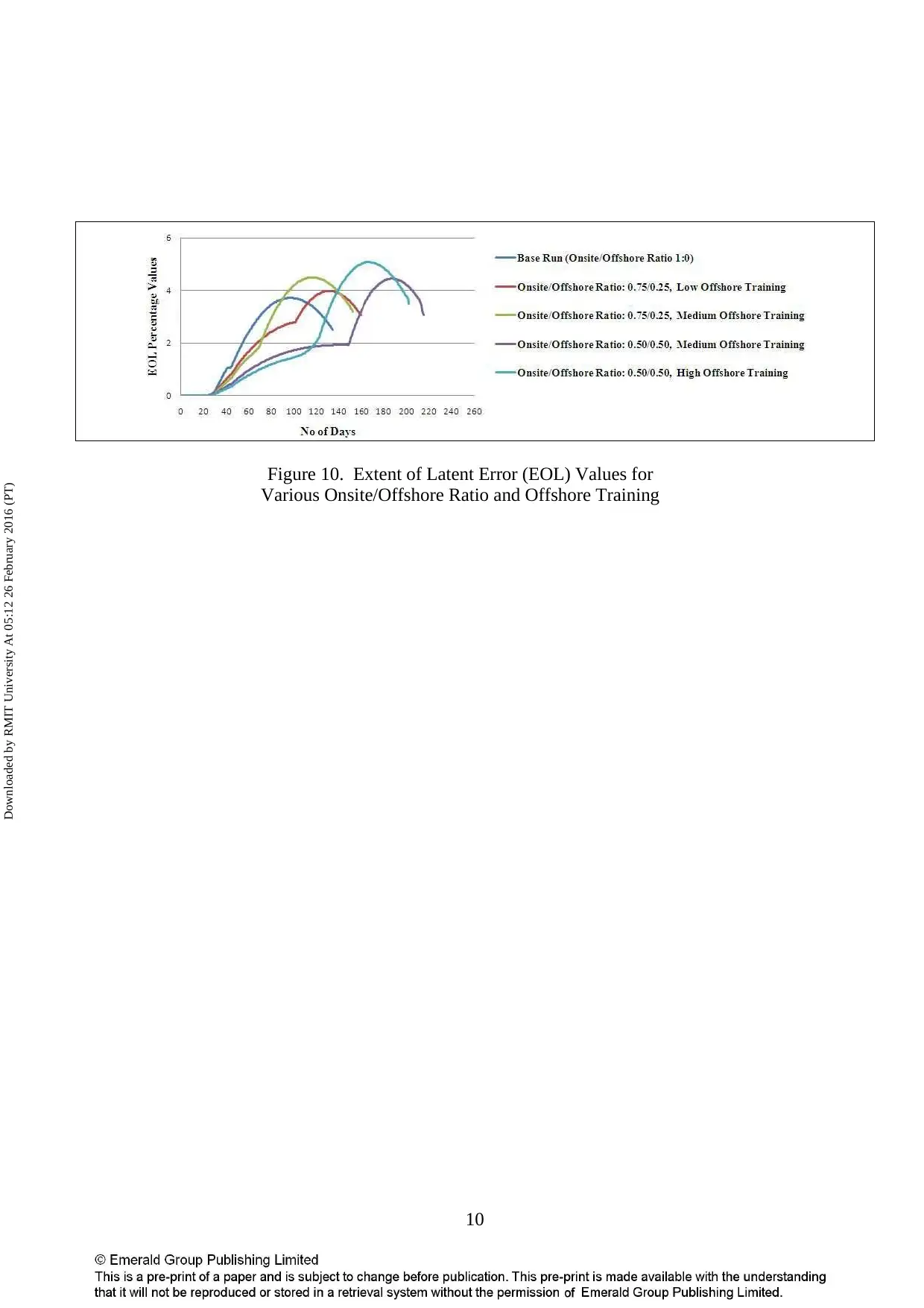
10
Figure 10. Extent of Latent Error (EOL) Values for
Various Onsite/Offshore Ratio and Offshore Training
Downloaded by RMIT University At 05:12 26 February 2016 (PT)
Figure 10. Extent of Latent Error (EOL) Values for
Various Onsite/Offshore Ratio and Offshore Training
Downloaded by RMIT University At 05:12 26 February 2016 (PT)
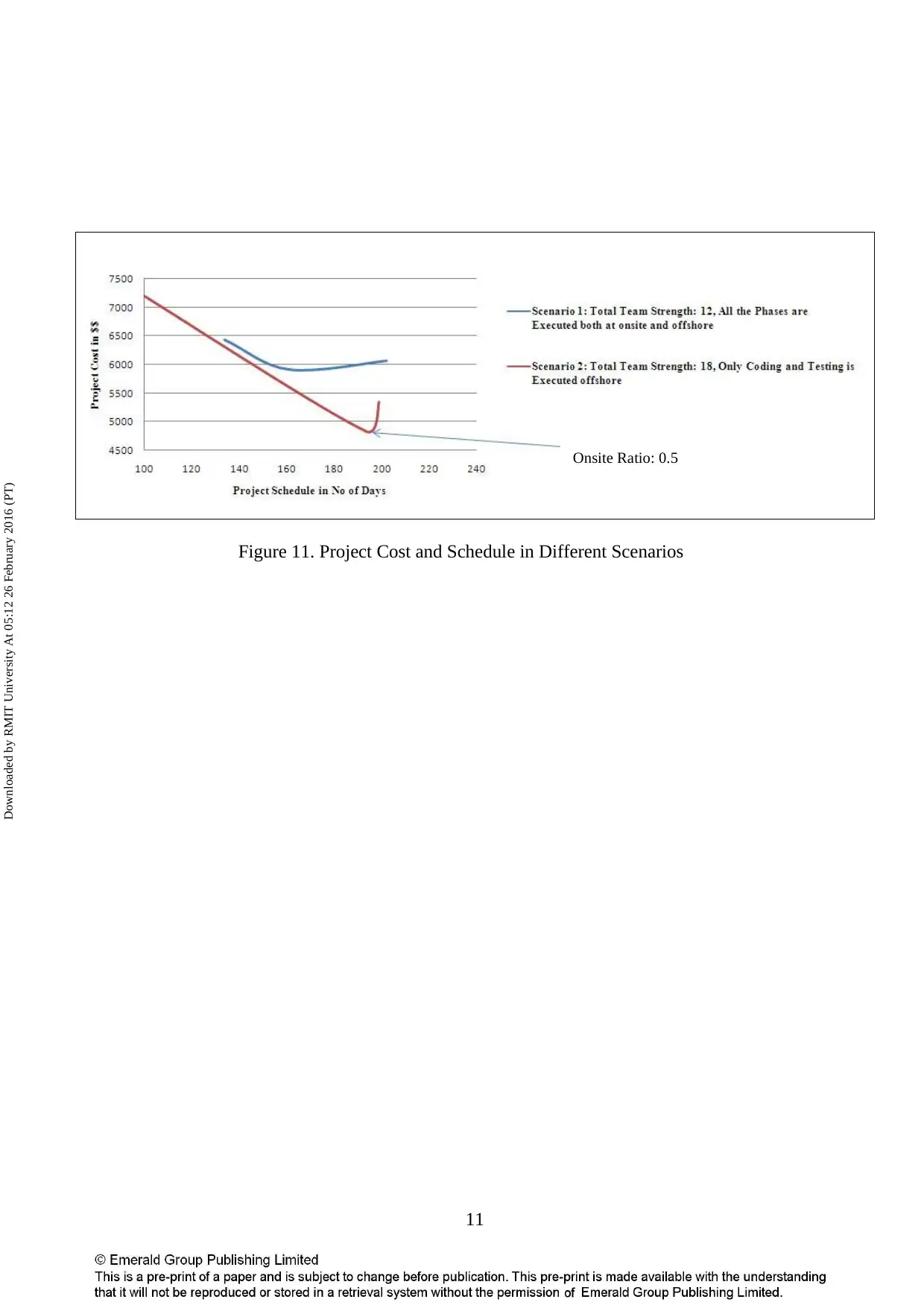
11
Figure 11. Project Cost and Schedule in Different Scenarios
Onsite Ratio: 0.5
Downloaded by RMIT University At 05:12 26 February 2016 (PT)
Figure 11. Project Cost and Schedule in Different Scenarios
Onsite Ratio: 0.5
Downloaded by RMIT University At 05:12 26 February 2016 (PT)
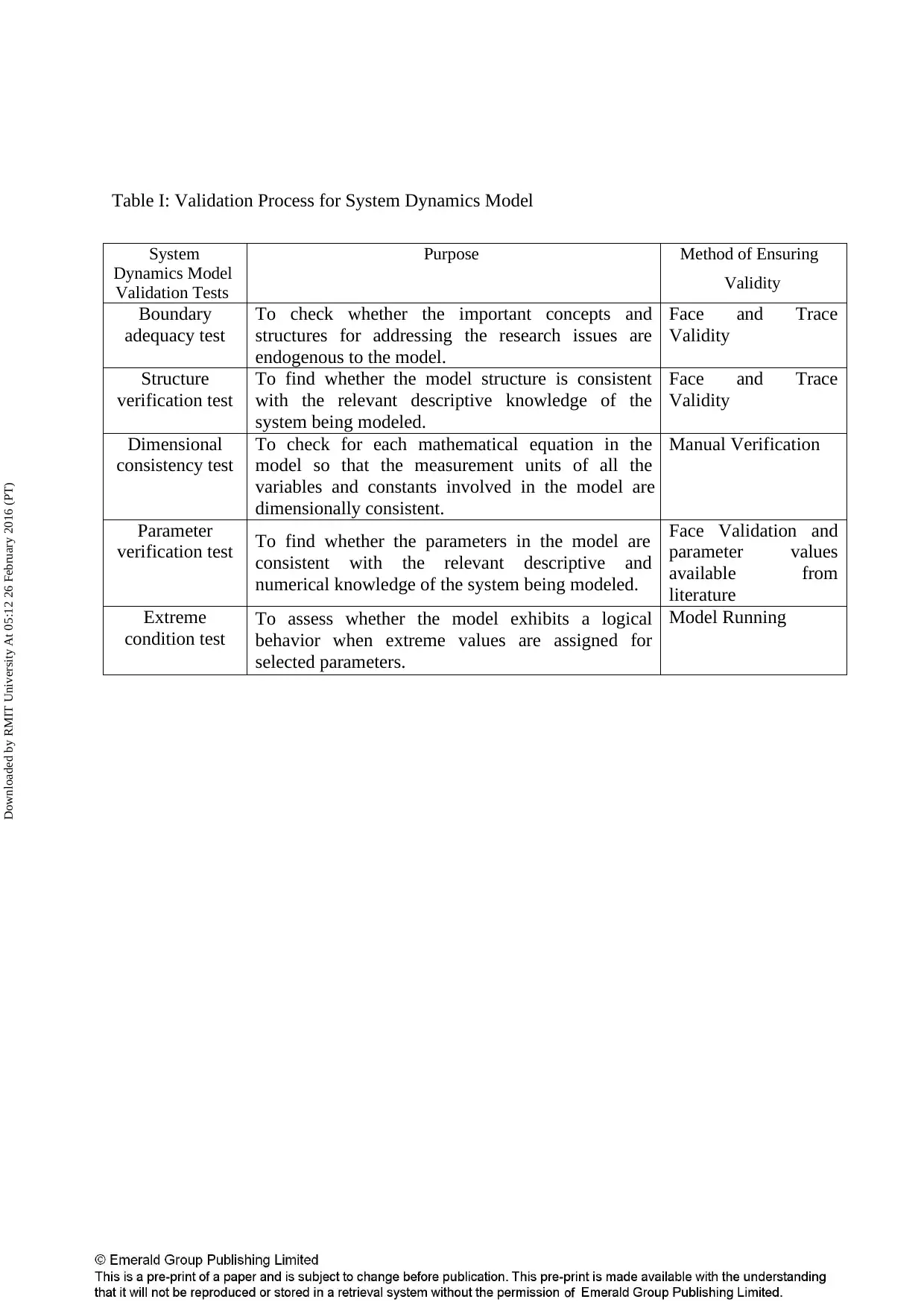
Table I: Validation Process for System Dynamics Model
System
Dynamics Model
Validation Tests
Purpose Method of Ensuring
Validity
Boundary
adequacy test
To check whether the important concepts and
structures for addressing the research issues are
endogenous to the model.
Face and Trace
Validity
Structure
verification test
To find whether the model structure is consistent
with the relevant descriptive knowledge of the
system being modeled.
Face and Trace
Validity
Dimensional
consistency test
To check for each mathematical equation in the
model so that the measurement units of all the
variables and constants involved in the model are
dimensionally consistent.
Manual Verification
Parameter
verification test To find whether the parameters in the model are
consistent with the relevant descriptive and
numerical knowledge of the system being modeled.
Face Validation and
parameter values
available from
literature
Extreme
condition test
To assess whether the model exhibits a logical
behavior when extreme values are assigned for
selected parameters.
Model Running
Downloaded by RMIT University At 05:12 26 February 2016 (PT)
System
Dynamics Model
Validation Tests
Purpose Method of Ensuring
Validity
Boundary
adequacy test
To check whether the important concepts and
structures for addressing the research issues are
endogenous to the model.
Face and Trace
Validity
Structure
verification test
To find whether the model structure is consistent
with the relevant descriptive knowledge of the
system being modeled.
Face and Trace
Validity
Dimensional
consistency test
To check for each mathematical equation in the
model so that the measurement units of all the
variables and constants involved in the model are
dimensionally consistent.
Manual Verification
Parameter
verification test To find whether the parameters in the model are
consistent with the relevant descriptive and
numerical knowledge of the system being modeled.
Face Validation and
parameter values
available from
literature
Extreme
condition test
To assess whether the model exhibits a logical
behavior when extreme values are assigned for
selected parameters.
Model Running
Downloaded by RMIT University At 05:12 26 February 2016 (PT)
Paraphrase This Document
Need a fresh take? Get an instant paraphrase of this document with our AI Paraphraser
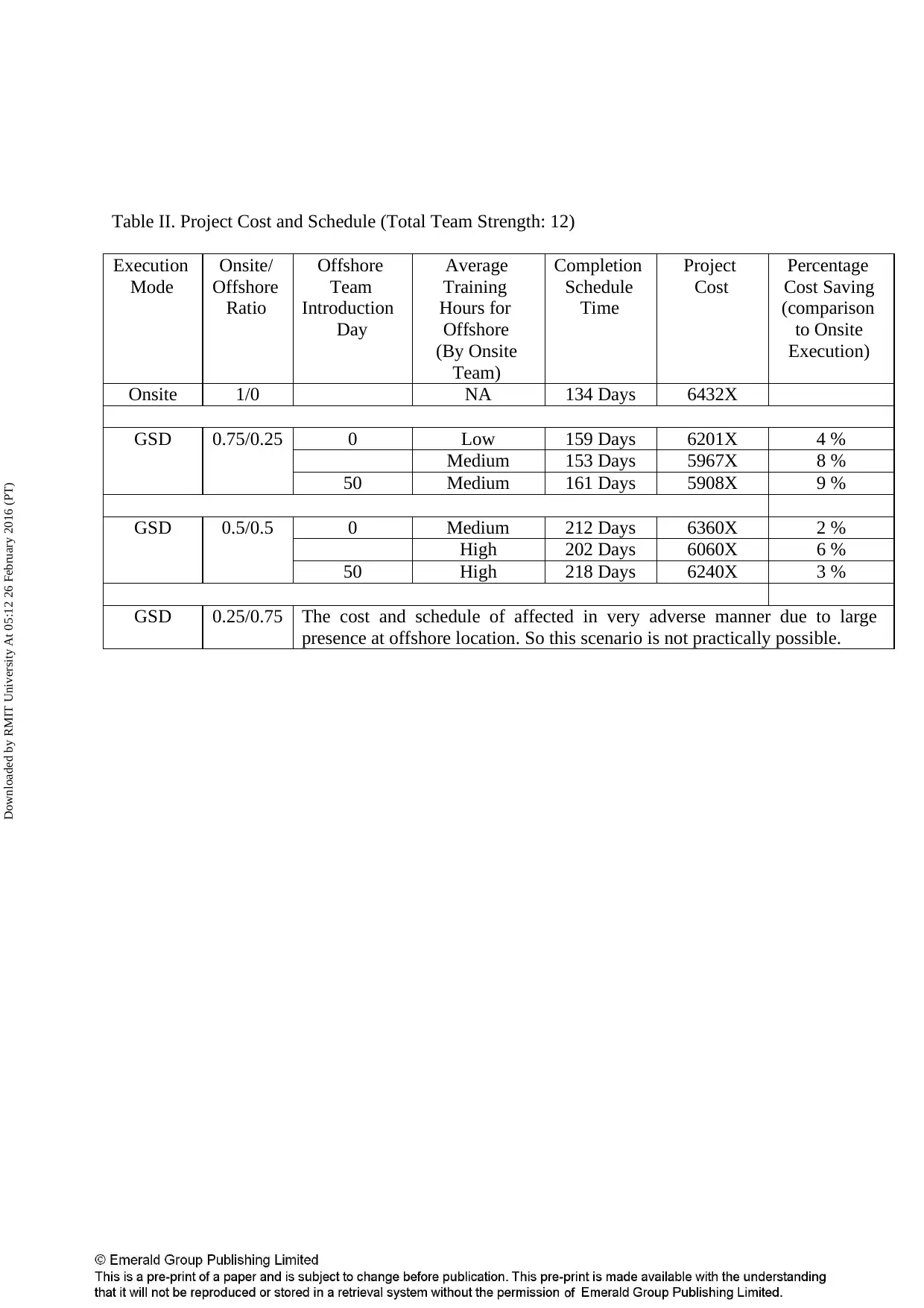
Table II. Project Cost and Schedule (Total Team Strength: 12)
Execution
Mode
Onsite/
Offshore
Ratio
Offshore
Team
Introduction
Day
Average
Training
Hours for
Offshore
(By Onsite
Team)
Completion
Schedule
Time
Project
Cost
Percentage
Cost Saving
(comparison
to Onsite
Execution)
Onsite 1/0 NA 134 Days 6432X
GSD 0.75/0.25 0 Low 159 Days 6201X 4 %
Medium 153 Days 5967X 8 %
50 Medium 161 Days 5908X 9 %
GSD 0.5/0.5 0 Medium 212 Days 6360X 2 %
High 202 Days 6060X 6 %
50 High 218 Days 6240X 3 %
GSD 0.25/0.75 The cost and schedule of affected in very adverse manner due to large
presence at offshore location. So this scenario is not practically possible.
Downloaded by RMIT University At 05:12 26 February 2016 (PT)
Execution
Mode
Onsite/
Offshore
Ratio
Offshore
Team
Introduction
Day
Average
Training
Hours for
Offshore
(By Onsite
Team)
Completion
Schedule
Time
Project
Cost
Percentage
Cost Saving
(comparison
to Onsite
Execution)
Onsite 1/0 NA 134 Days 6432X
GSD 0.75/0.25 0 Low 159 Days 6201X 4 %
Medium 153 Days 5967X 8 %
50 Medium 161 Days 5908X 9 %
GSD 0.5/0.5 0 Medium 212 Days 6360X 2 %
High 202 Days 6060X 6 %
50 High 218 Days 6240X 3 %
GSD 0.25/0.75 The cost and schedule of affected in very adverse manner due to large
presence at offshore location. So this scenario is not practically possible.
Downloaded by RMIT University At 05:12 26 February 2016 (PT)
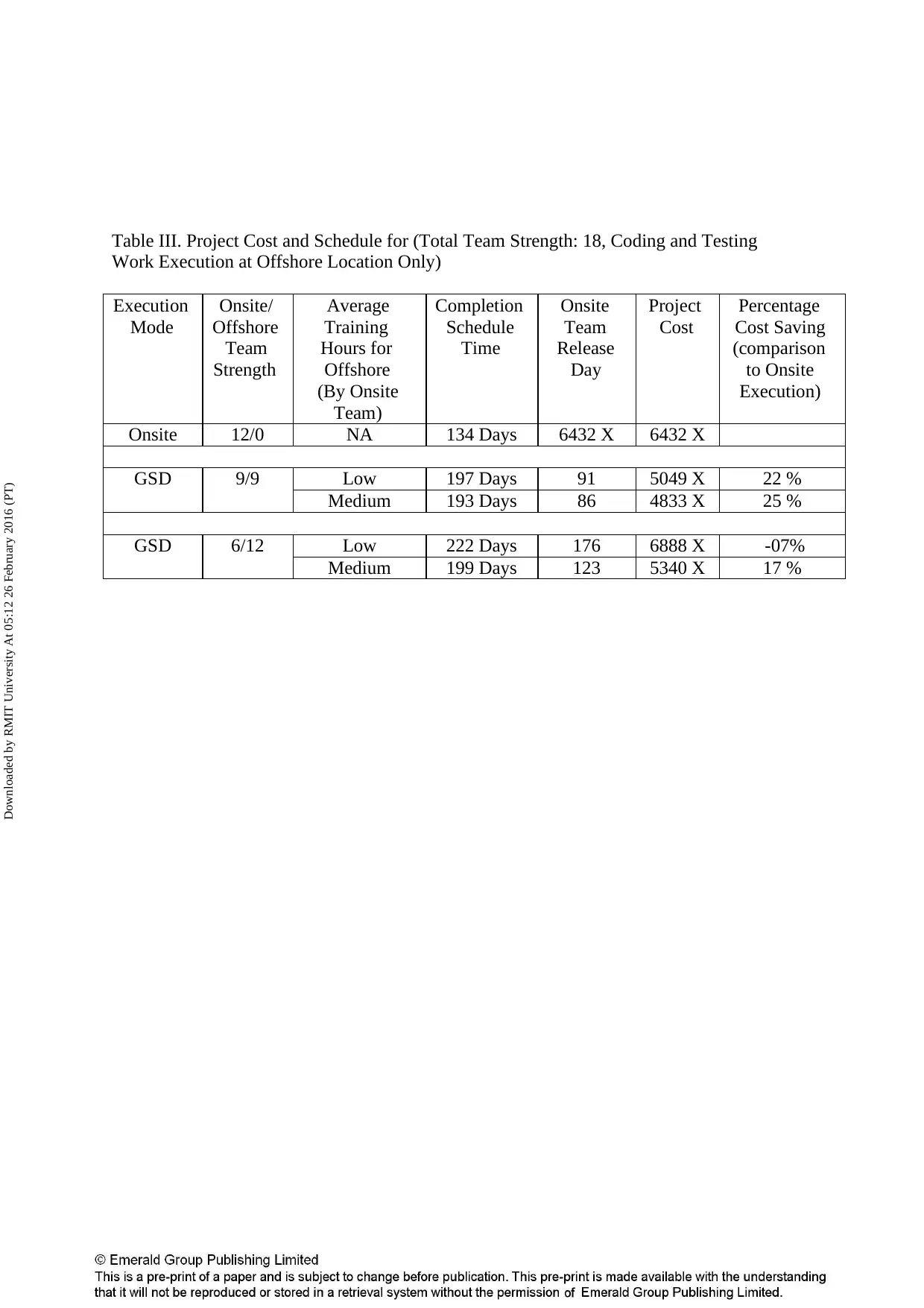
Table III. Project Cost and Schedule for (Total Team Strength: 18, Coding and Testing
Work Execution at Offshore Location Only)
Execution
Mode
Onsite/
Offshore
Team
Strength
Average
Training
Hours for
Offshore
(By Onsite
Team)
Completion
Schedule
Time
Onsite
Team
Release
Day
Project
Cost
Percentage
Cost Saving
(comparison
to Onsite
Execution)
Onsite 12/0 NA 134 Days 6432 X 6432 X
GSD 9/9 Low 197 Days 91 5049 X 22 %
Medium 193 Days 86 4833 X 25 %
GSD 6/12 Low 222 Days 176 6888 X -07%
Medium 199 Days 123 5340 X 17 %
Downloaded by RMIT University At 05:12 26 February 2016 (PT)
Work Execution at Offshore Location Only)
Execution
Mode
Onsite/
Offshore
Team
Strength
Average
Training
Hours for
Offshore
(By Onsite
Team)
Completion
Schedule
Time
Onsite
Team
Release
Day
Project
Cost
Percentage
Cost Saving
(comparison
to Onsite
Execution)
Onsite 12/0 NA 134 Days 6432 X 6432 X
GSD 9/9 Low 197 Days 91 5049 X 22 %
Medium 193 Days 86 4833 X 25 %
GSD 6/12 Low 222 Days 176 6888 X -07%
Medium 199 Days 123 5340 X 17 %
Downloaded by RMIT University At 05:12 26 February 2016 (PT)
1 out of 45
Your All-in-One AI-Powered Toolkit for Academic Success.
+13062052269
info@desklib.com
Available 24*7 on WhatsApp / Email
![[object Object]](/_next/static/media/star-bottom.7253800d.svg)
Unlock your academic potential
© 2024 | Zucol Services PVT LTD | All rights reserved.